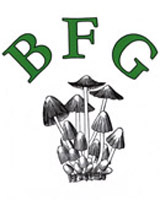Members’ Finds, January to June 2025
Following the success of our Members' Finds project launched in 2020, here is our new page for January to June 2025 to which members are again invited to contribute. Please email Penny your photos - even of species already on previous lists. Common or rare: all are welcome! Thanks to all our many contributors, we now have well over 1200 species illustrated here, all from Buckinghamshire!
BASIC INSTRUCTIONS FOR PARTICIPATING
• Only BFG members may contribute; collections must be from Buckinghamshire.
• Please send images as an attachment and not embedded into the email text.
• NB! All photos should be accurately captioned before attaching. Please replace your camera code number with fungus name (a suggestion is fine), site, date, your initials. EG Amanita muscaria Penn Wood 01.10.2025 PC1.
• Aim to show all aspects of the fruitbody, include several photos if available.
• Please include in your email as much detail as possible (eg size, smell, substrate, habitat, microscopic details if available). All clues are vital when identifying solely from photos.
• If possible collect and retain at least one specimen until you've heard back from Penny in case further investigation is required - records of rarities are invalid without voucher material which may well need to be dried for molecular sequencing to confirm.
VIEWING TIPS
• Click on thumbnail to view photos at full size.
• New for 2025, the date on the left outside the text boxes is the date of entry into Members Finds; the date within each text box before the species name is the date of collection.
• At the bottom of each entry, clicking on Previous finds, New find or Updated find takes you to the appropriate entry in the Masterlist Index.
• The quickest way to search for any species is by clicking on the LATIN MASTERLIST INDEX, which now automatically groups all entries for any one species together for convenient comparison.
• In addition to the Masterlist, each page has a regularly updated list of entries. Click either Latin binomial or English common.
• ![]() Only entries marked with this symbol have been microscopically examined. There is no guarantee on identifications made of entries lacking this symbol though all photos are checked and selected by Penny to the best of her ability. Basic accompanying notes are also Penny's.
Only entries marked with this symbol have been microscopically examined. There is no guarantee on identifications made of entries lacking this symbol though all photos are checked and selected by Penny to the best of her ability. Basic accompanying notes are also Penny's.
• ![]() Entries marked with this symbol have been confirmed or identified using DNA sequencing.
Entries marked with this symbol have been confirmed or identified using DNA sequencing.
• To search for a particular date, start by clicking on the month required (just above the first entry) before scrolling down or up.
Contributors / Photographers: Andrew Dodd; Bob Simpson; Claire Williams; Jackie Ewan; Jackie Newcombe; Jesper Lauder; John Catterson; Lisa Rock; Sarah Ebdon; Stephen Plummer.
Rare sightings |
New to Buckinghamshire |
New to UK |
New to Science |
January February March April May June
| Image | Details |
|---|
June 12th 2025
.jpg) |
June 9th Cyanoboletus pulverulentus (Inkstain Bolete) In Jordans Village in a grassy verge under Oak and Beech Jesper Launder found this stunning example of a bolete which stains intensely deep blue on damage though has yellow rather than red or orange pores as in others which have blue staining flesh. I wonder, can we take this as a strong sign that at last there's been sufficient rain to trigger some fungi into fruiting at last?! Previous finds |
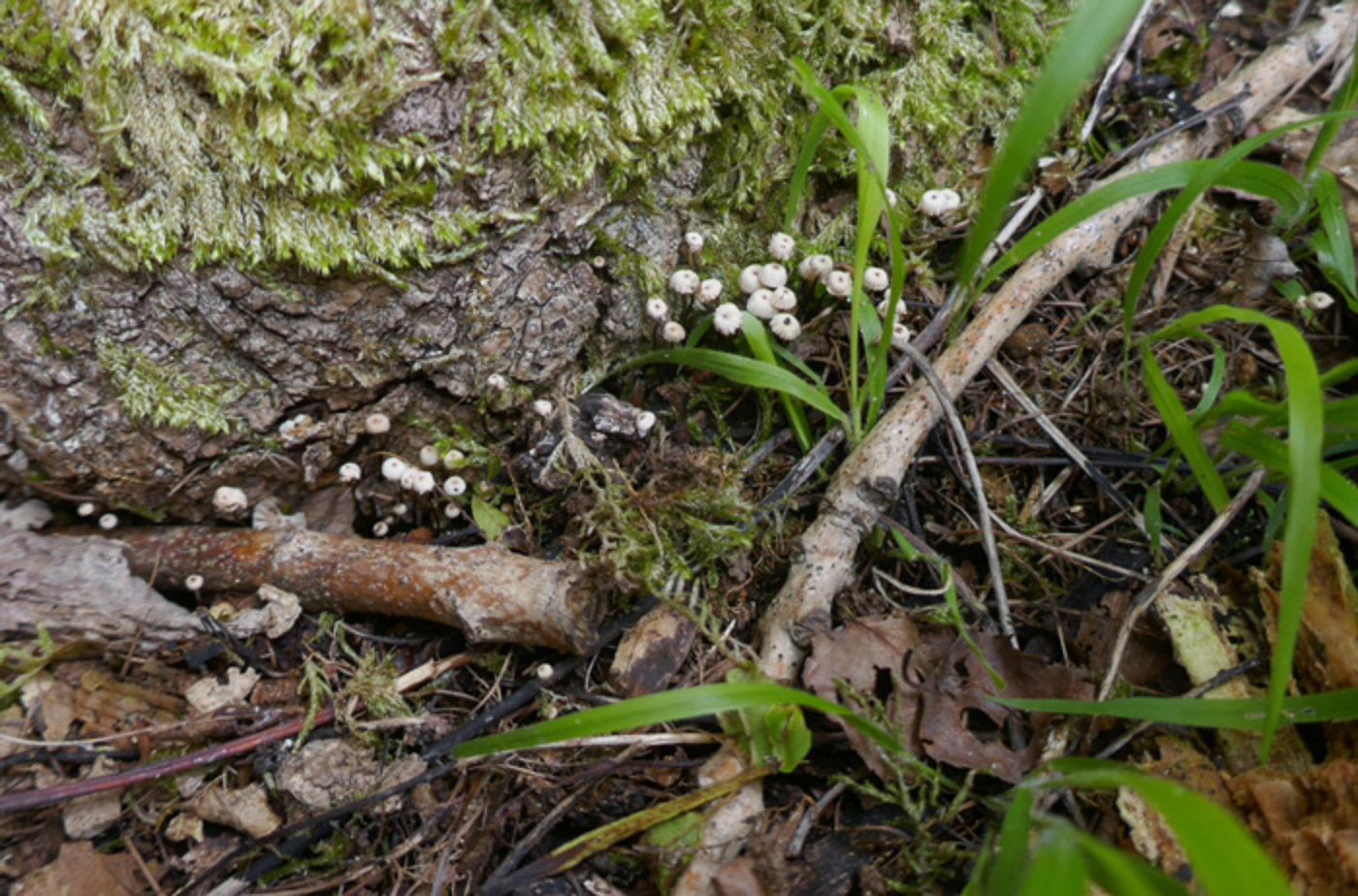
.jpg)
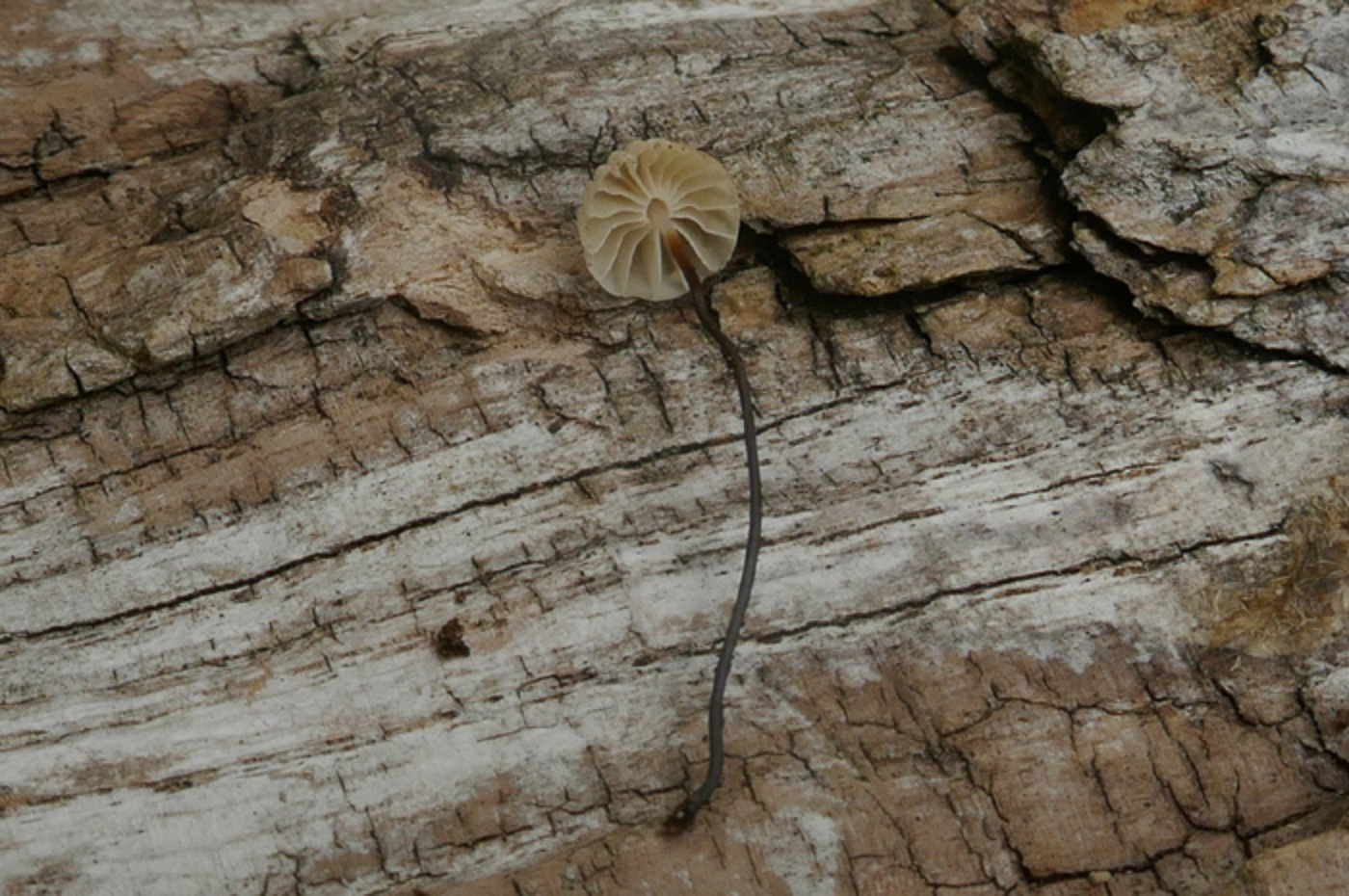 |
June 9th Marasmius rotula (Collared Parachute) At Stampwell Farm Jackie Ewan was pleased to see the good quantities of this common species of woodland litter fruiting on the woody remains of Ash. This number of fruitbodies was a certainly sight for sore eyes after the dearth in recent months. There are several other species in this genus which can look similar from above, but not with the distinctive 'cogwheel' effect where the gills attach to a 'collar' rather than to the stem itself in this way. The much rarer and miniscule M. bulliardii also sports this gill attachment but is tiny, has a dark central 'dot' in the cap and occurs only on fallen deciduous leaves - usually Beech - and not on woody remains. Previous finds |
.jpg) |
June 9th Gymnopus confluens (Clustered Toughshank) At Stampwell Farm Jackie Ewan found a few of these in a grassy woodland path, no doubt responding to the recent and much needed rains. A common woodland fruiter, the species can be found both tightly clustered and also on occasion singly when it tends to confuse for obvious reasons. The very crowded gills and finely furry stems are good characters to look out for. The site now has a long species list but Jackie says this was the first time she's found it here. Previous finds |
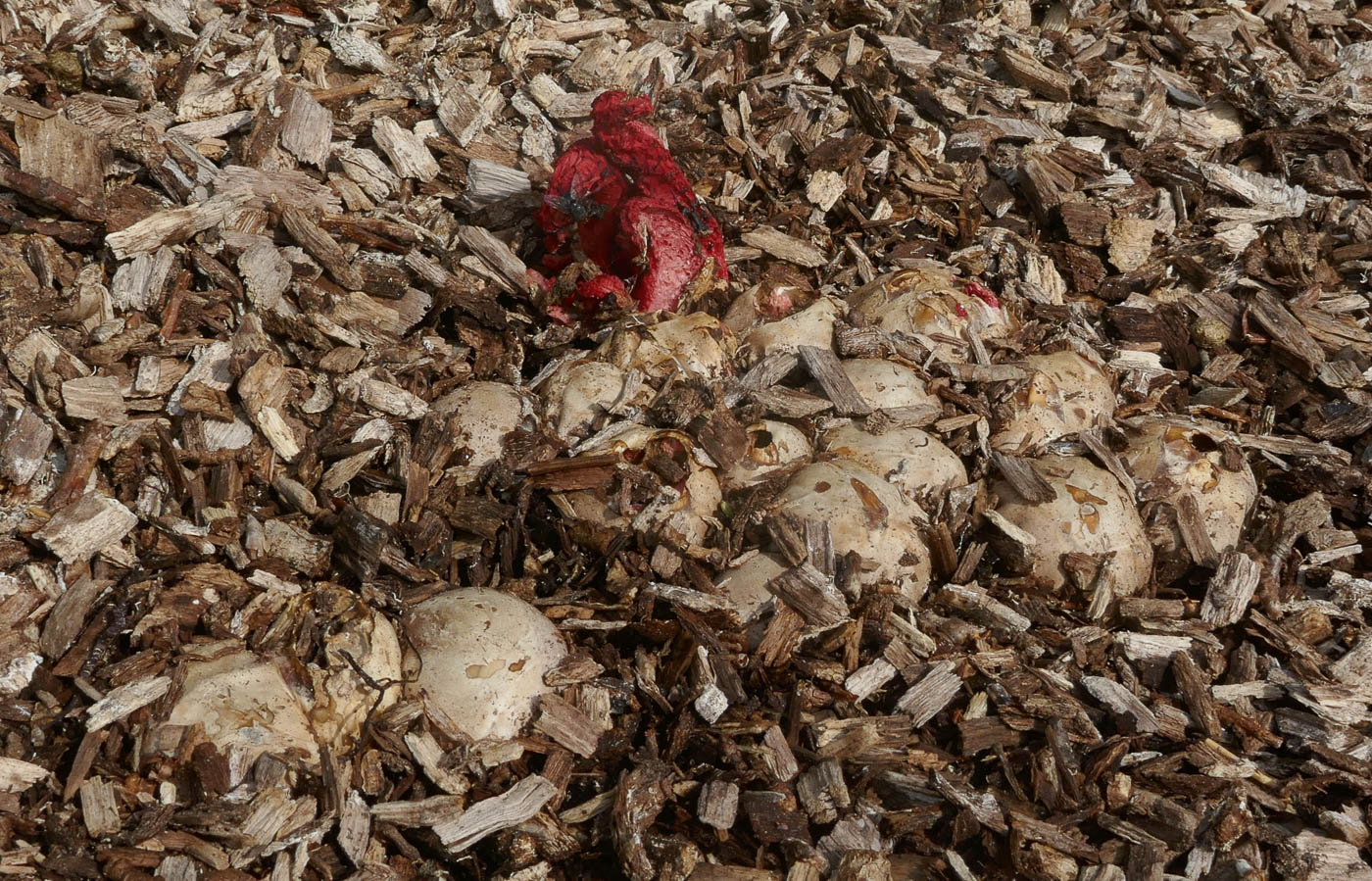
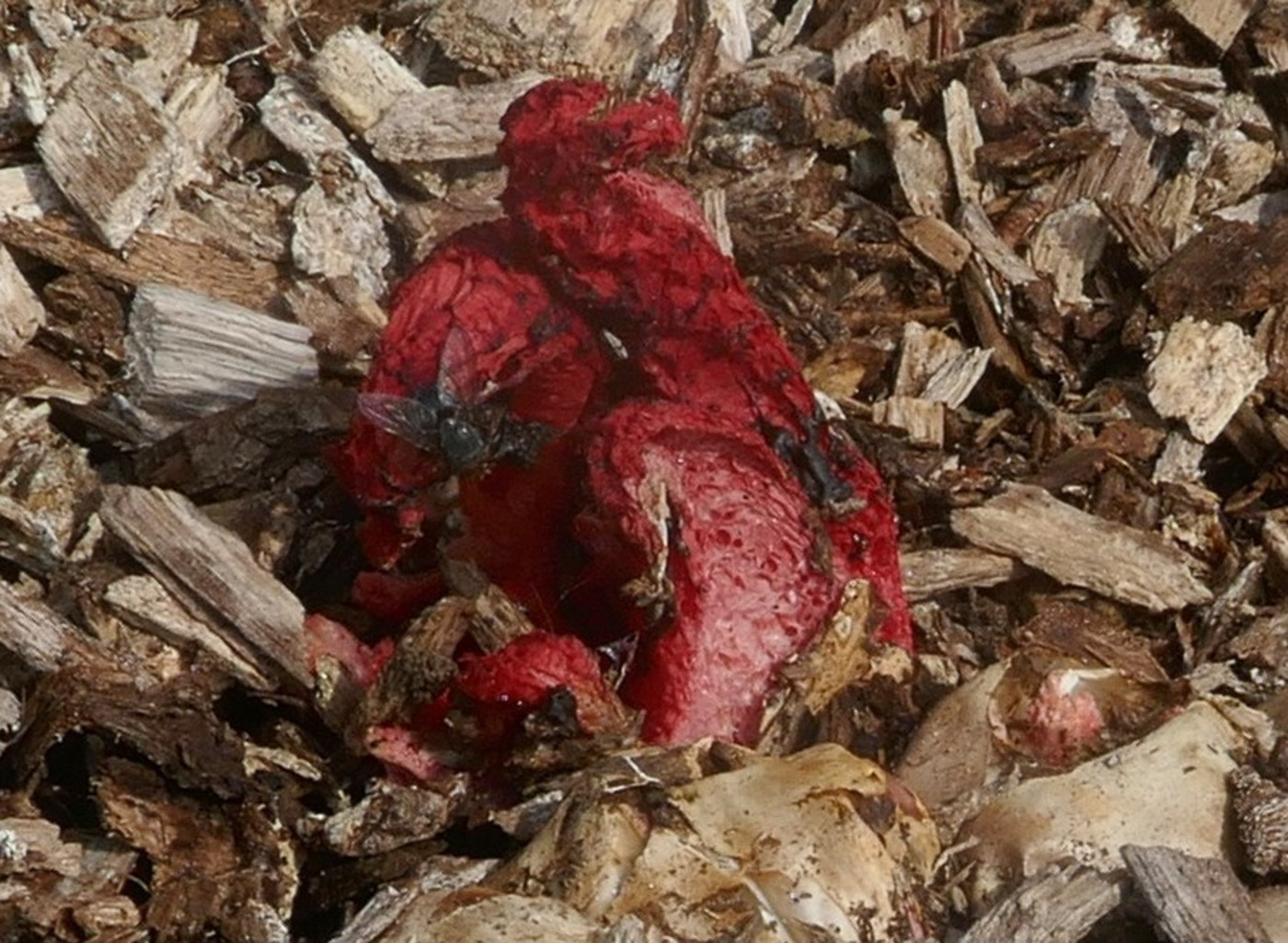 |
June 6th Clathrus archeri (Devil's Fingers) This species was a surprise to find at this time of year at Stampwell Farm where it has been found regularly for the last few years though always later in the year. Jackie Ewan reports that there was a large clutch of no less than 18 eggs with just one or two far enough developed to show the distinctive red of the mature fruit bodies. They were enjoying a newish woodchip pile in the same spot where she first discovered the species here in 2021 though the pile was formed much more recently than that from local prunings indicating that the re-occurrence of the species is due to the site itself rather specifically to the woodchip pile. Previous finds |
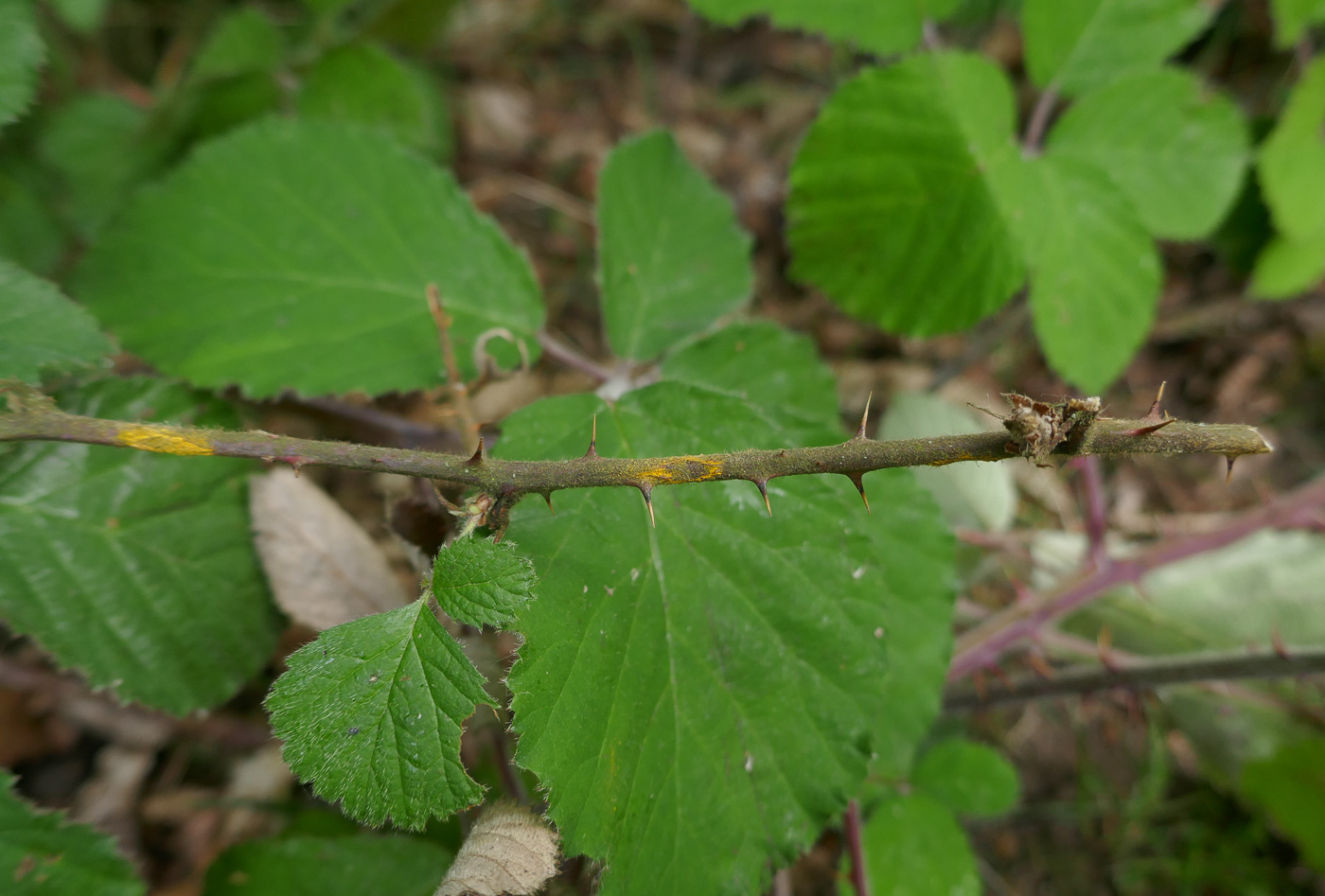 |
June 6th Kuehneola uredinis (Pale Bramble Rust) At Stampwell Farm Jackie Ewan spotted this distinctive rust which frequents Bramble stems at this time Previous finds |
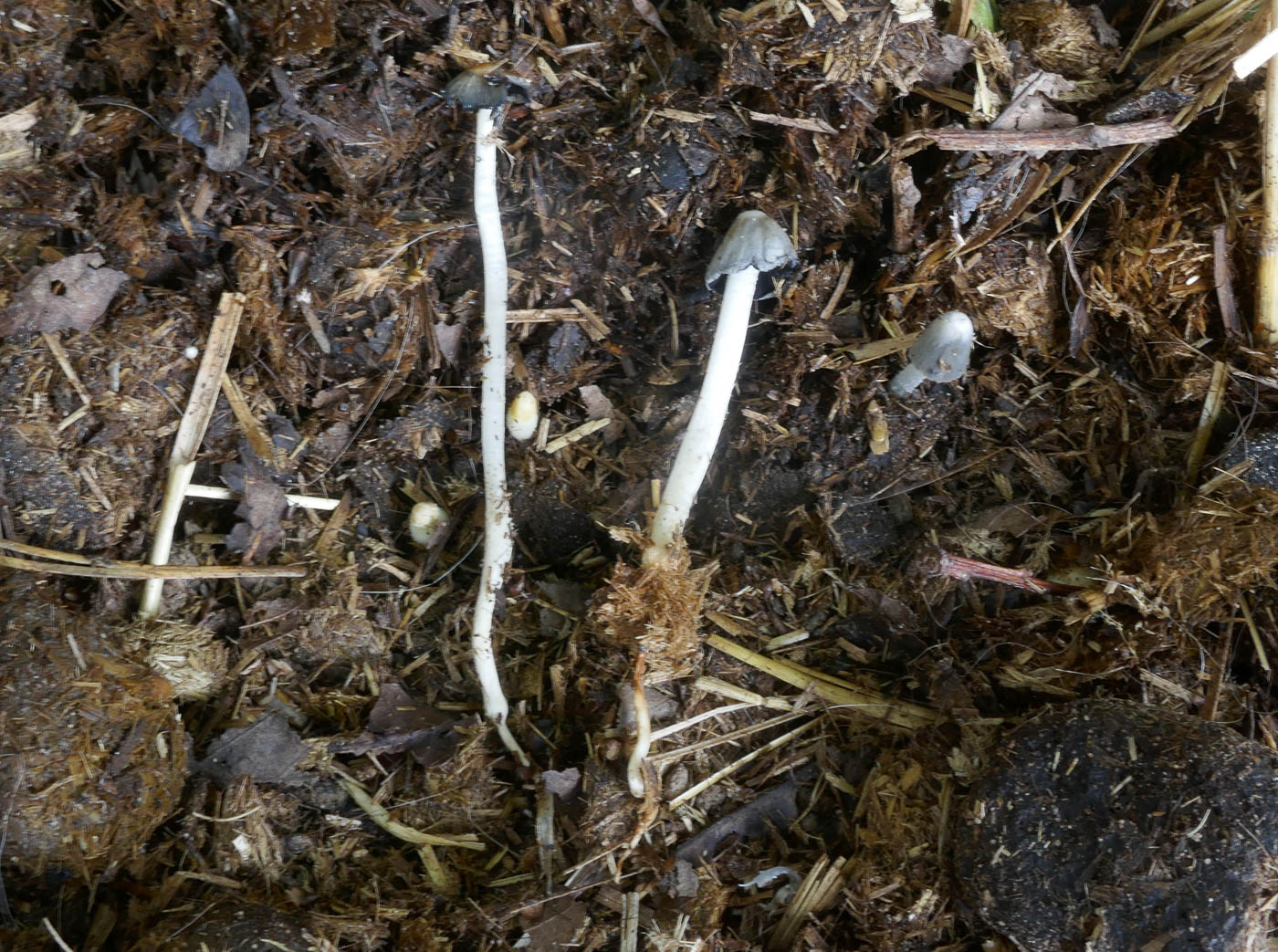
 |
June 6th Coprinopsis cinerea (Grey Inkcap) On the dung heap at Stampwell Farm Jackie Ewan noticed this species just beginning to appear. This is in fact a relatively common dung Inkcap though we appear to have only a handful of county records, and our first Finds entry was from this same dung heap at the farm a couple of years back. It favours dung heaps with straw, as here, rather than dung in the field. Previous finds |
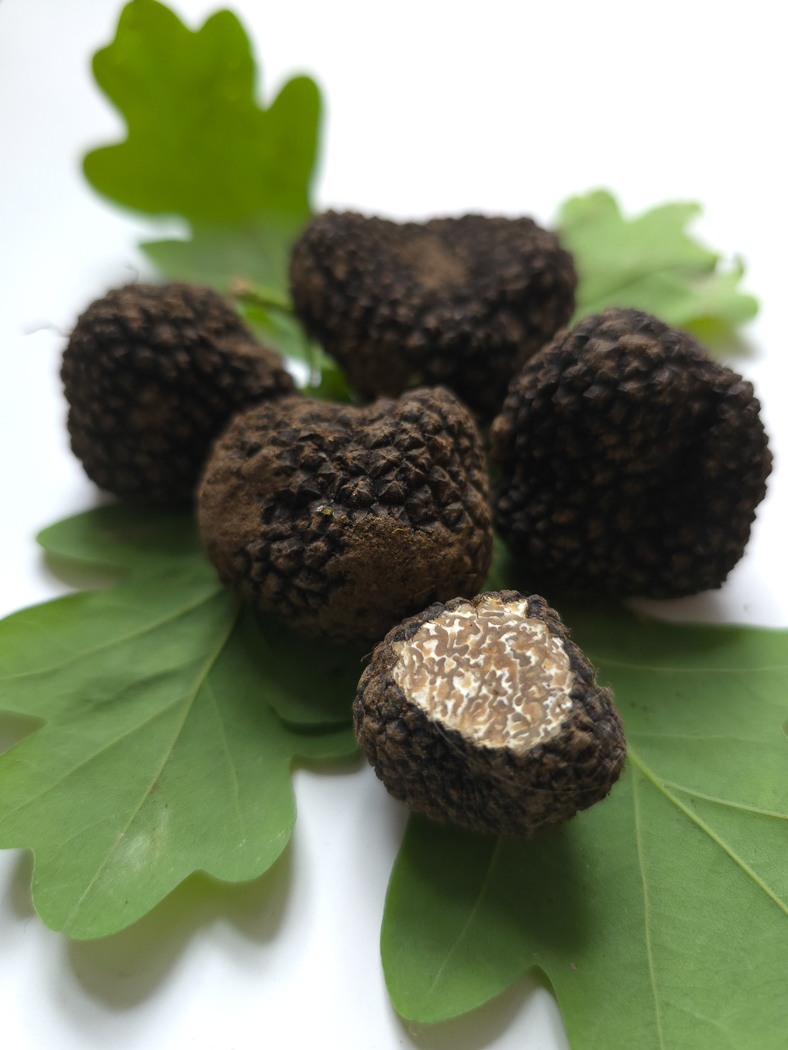 |
June 6th Tuber aestivum (Summer Truffle) Under Oak in Gerrards Cross Jesper Launder noticed various likely 'digholes' where truffles might be lurking and on making a search was rewarded with this selection (the photo taken later at home in order to show the interior). This is the time to be looking for this striking species, particularly under Oak or Beech, and it is probably quite common in our area though we still have only a handful of county sites where it's been recorded. Previous finds |
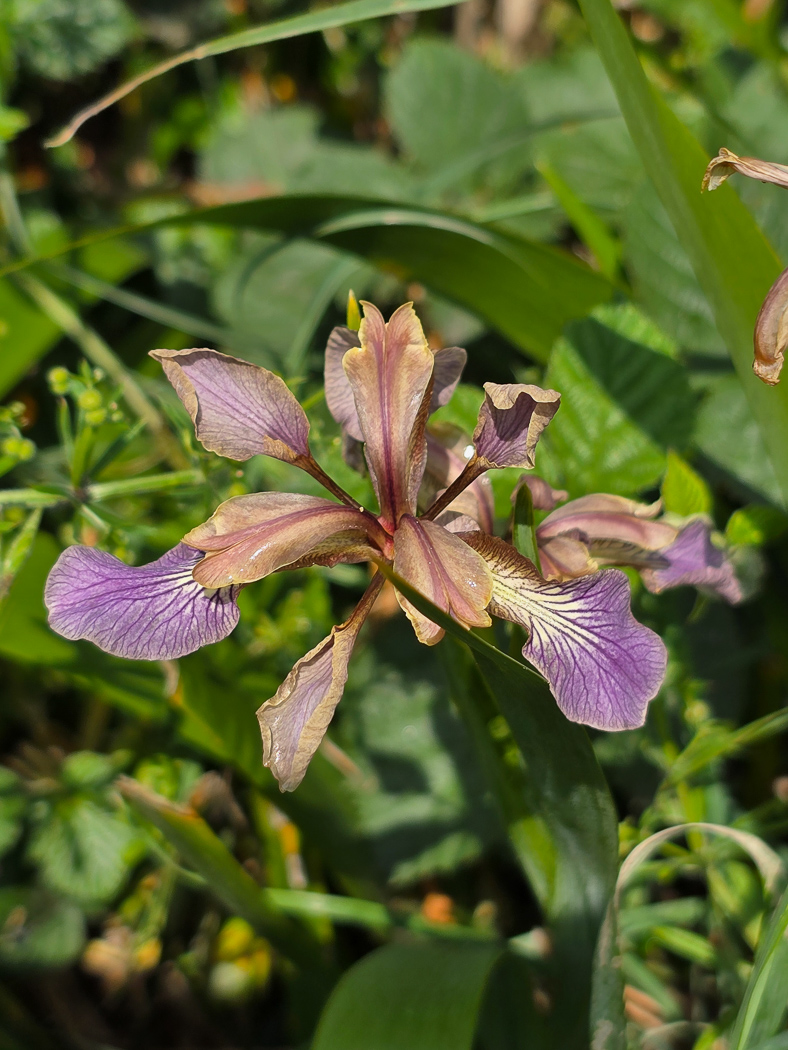
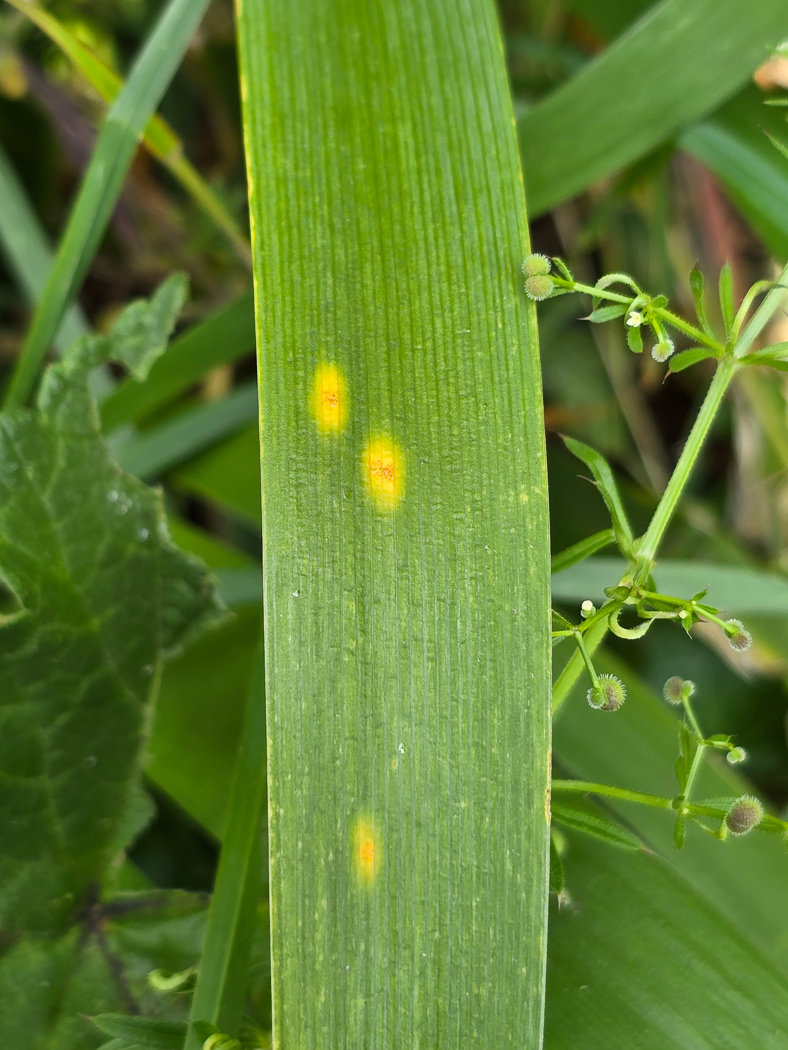 |
June 6th Puccinia iridis a species of rust with no English name Jesper Launder spotted this rust on the leaves of Iris foetidissima (Stinking Iris) in a roadside verge in Jordan Village. This species occurs on several species of Iris, having its initial stage on Urtica (Nettle). Though not at all rare we have only one previous Bucks record made by Derek in his Whitchurch garden in 1999, reflecting the lack of BFG recorders for such species. New find |
June 7th 2025
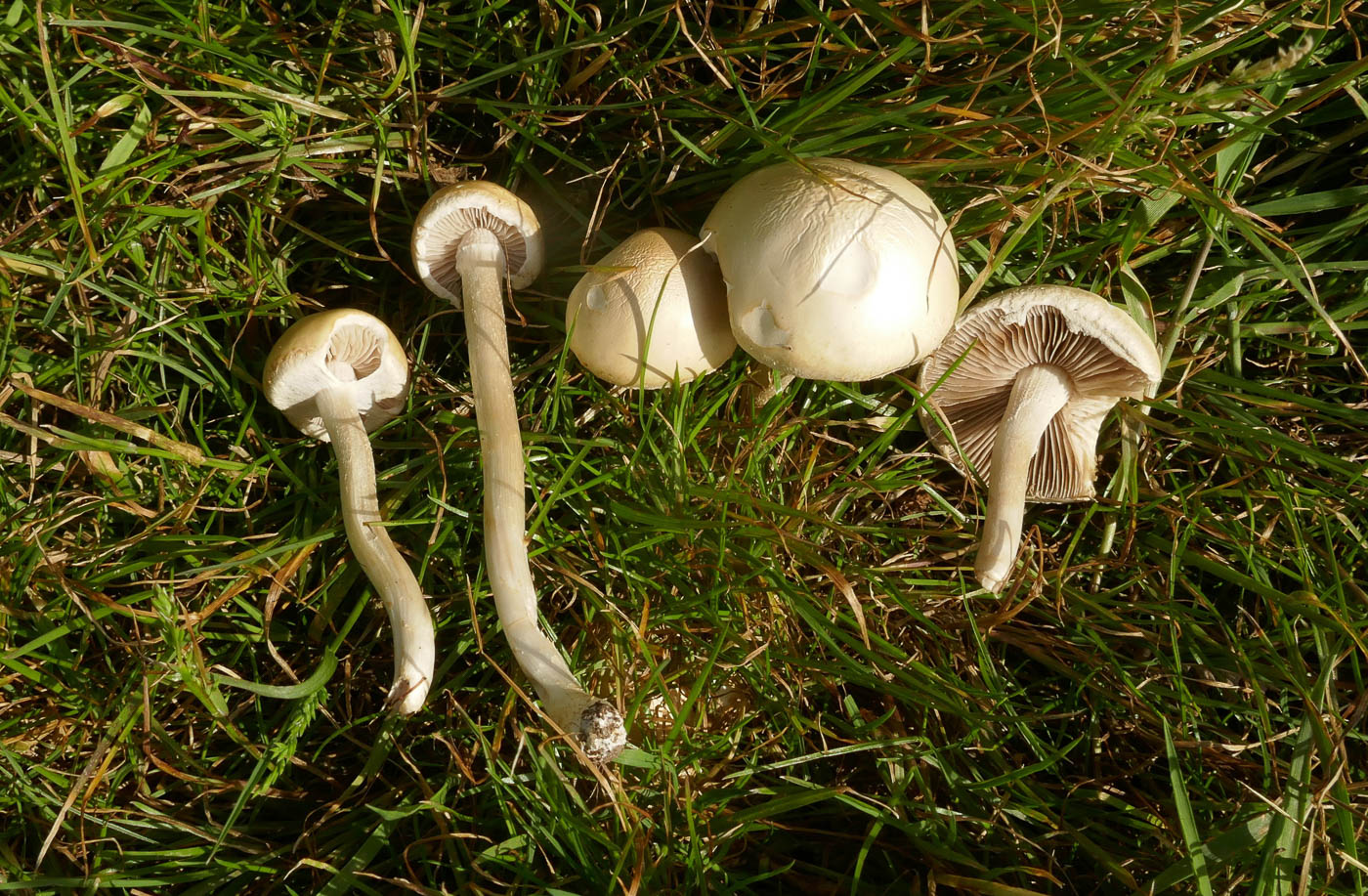 |
June 2nd Agrocybe molesta (Bearded Fieldcap) At Stampwell Farm Jackie Ewan noticed this summertime grassland species in a suitably grassy area and assumed at first that it was likely be one of the other two Agrocybe species which are often found here at this time, but checking later the larger spores eliminated A. praecox and the cap surface beginning to crack with clear hanging veil remnants eliminated A. pediades and pointed to A. molesta, found here also in 2022. We have plenty of county records ranging from May through to August and mainly found at Derek's previous home in Whitchurch where it was clearly a regular! Previous finds |
June 1st 2025
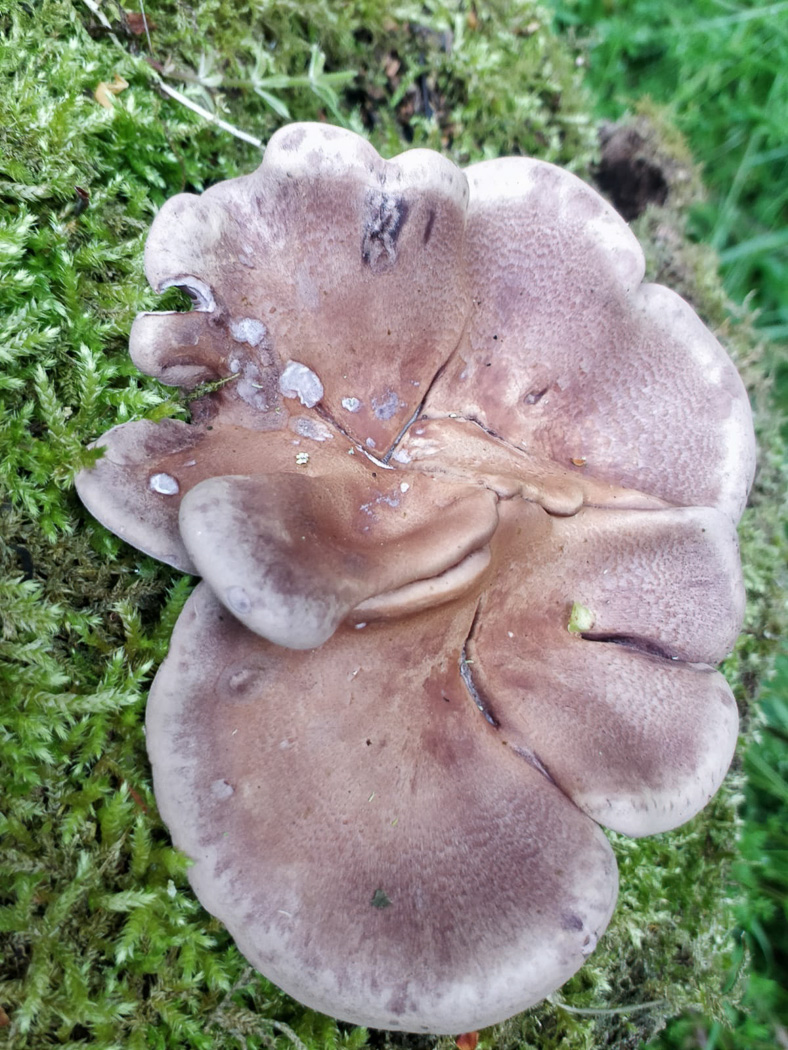
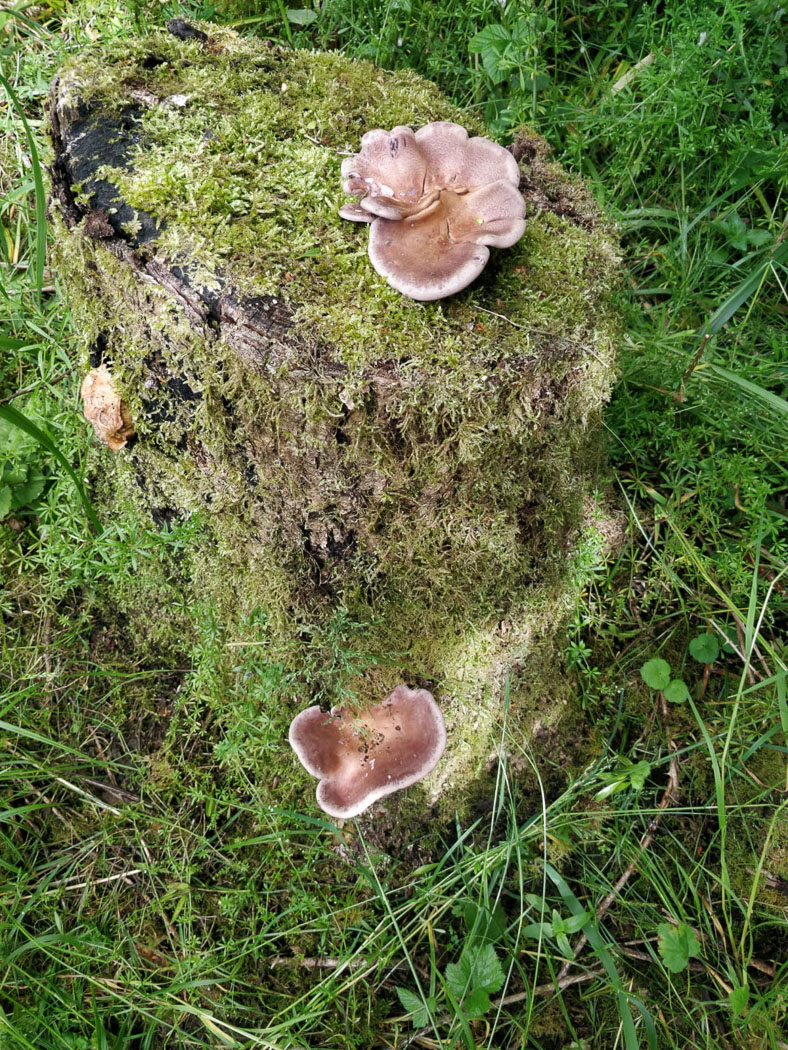
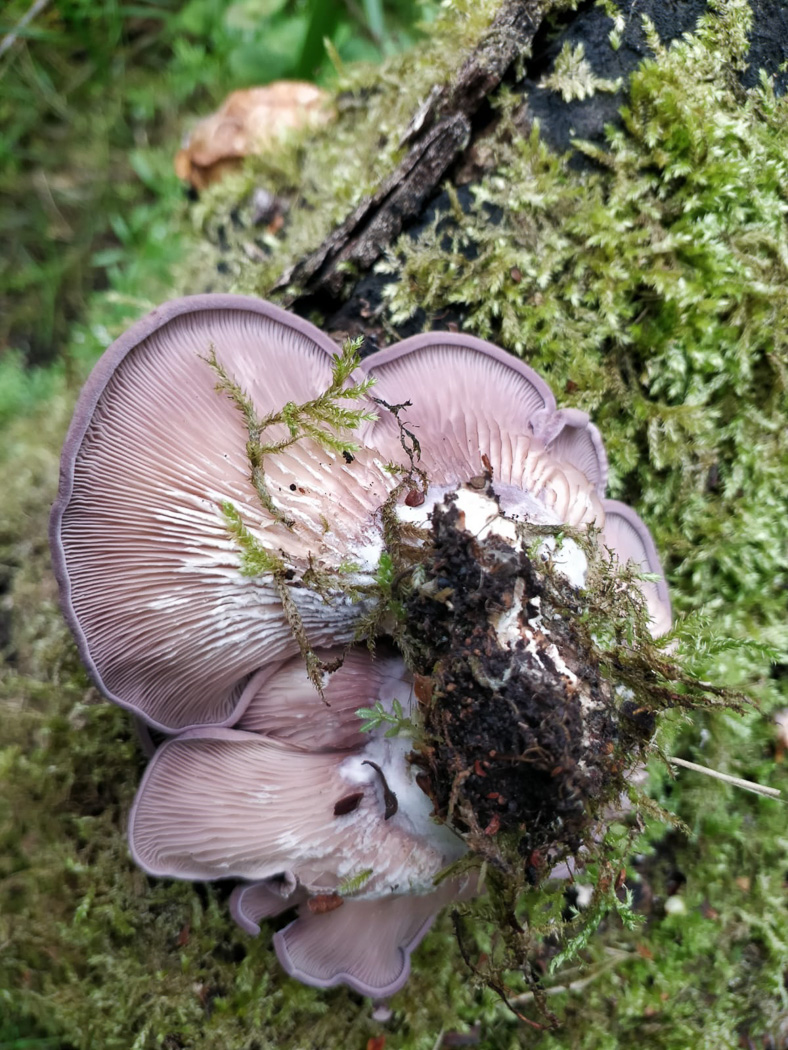
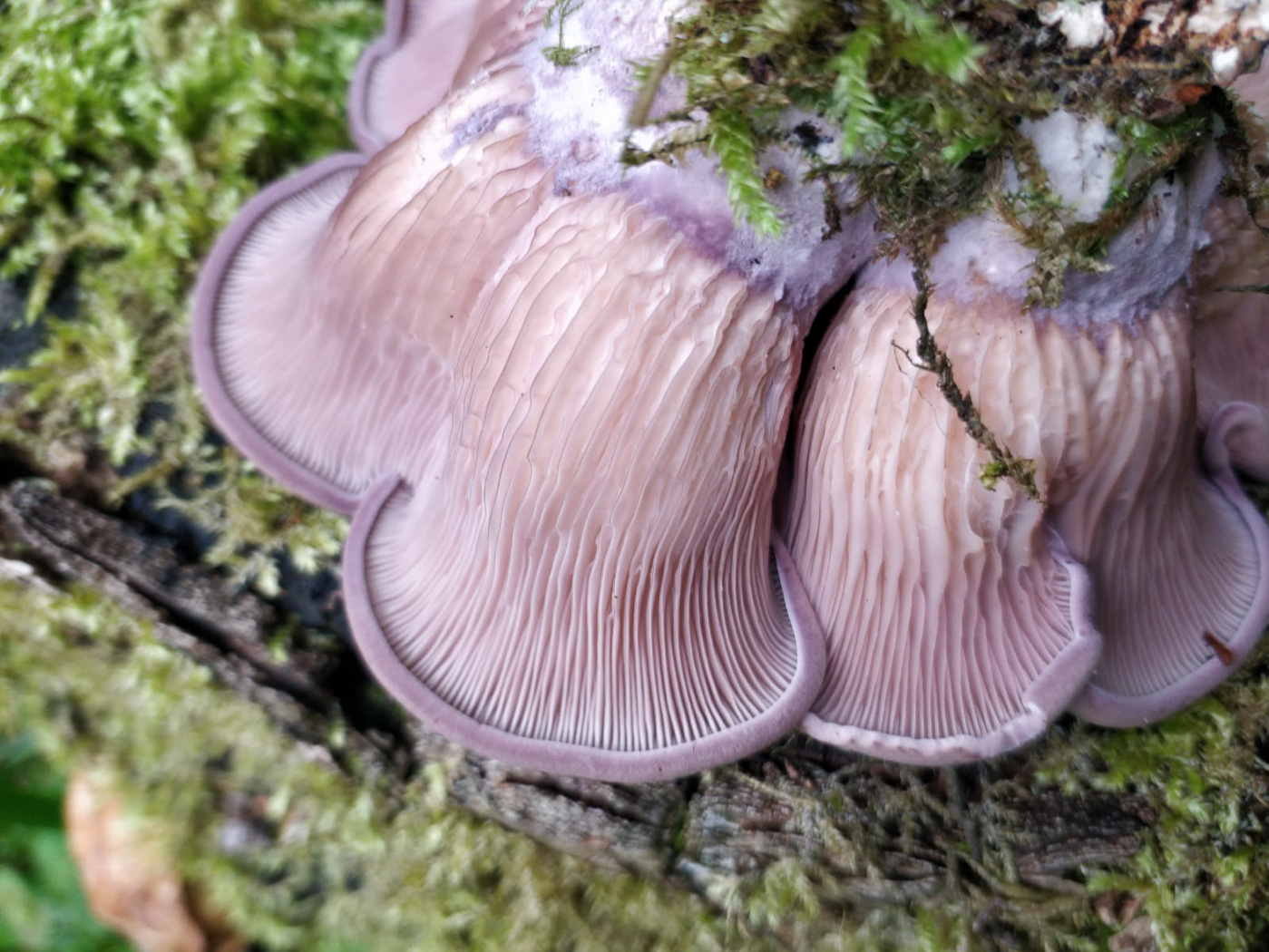 |
May 29th Panus conchatus (Lilac Oysterling) At last a nice fresh fungus as a result of much needed rain! Having found very little in the way of interest so far this spring in his Salden Wood, Bob Simpson was delighted to see this beautiful cluster growing on an old Ash stump. Its distinctive lilaceous colour together with typical 'oysterish' decurrent gills were enough to make his ID but he checked the spores from the white print the following morning which were a perfect match. We have just a handful of previous records though this is not considered a rare species but is certainly an attractive one. Previous finds |
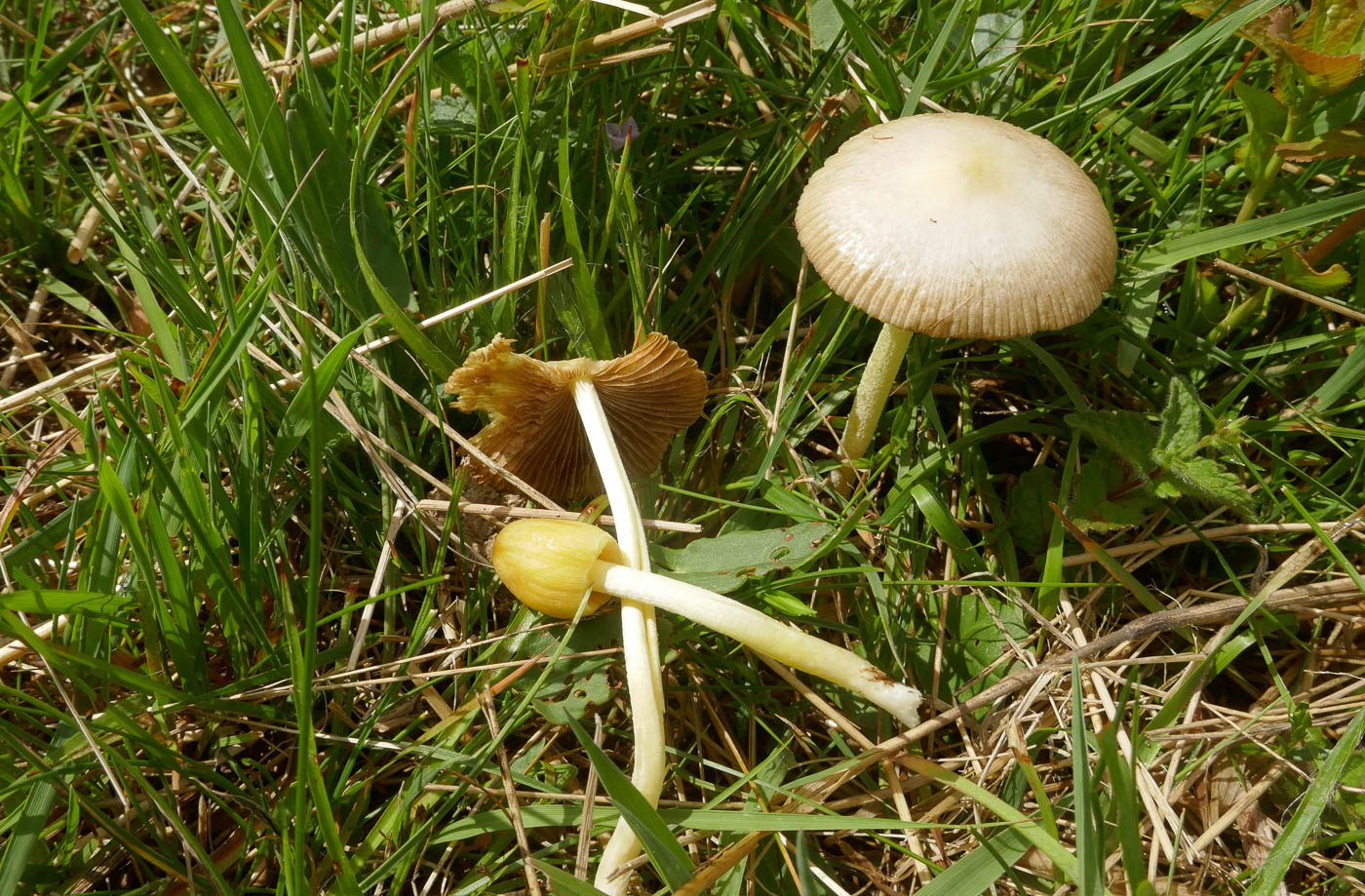 |
May 29th Bolbitius titubans (Yellow Fieldcap) At Stampwell Farm Jackie Ewan was not surprised to find this grassland species appreciating the recent rains. See previous finds for further info on the species. Previous finds |

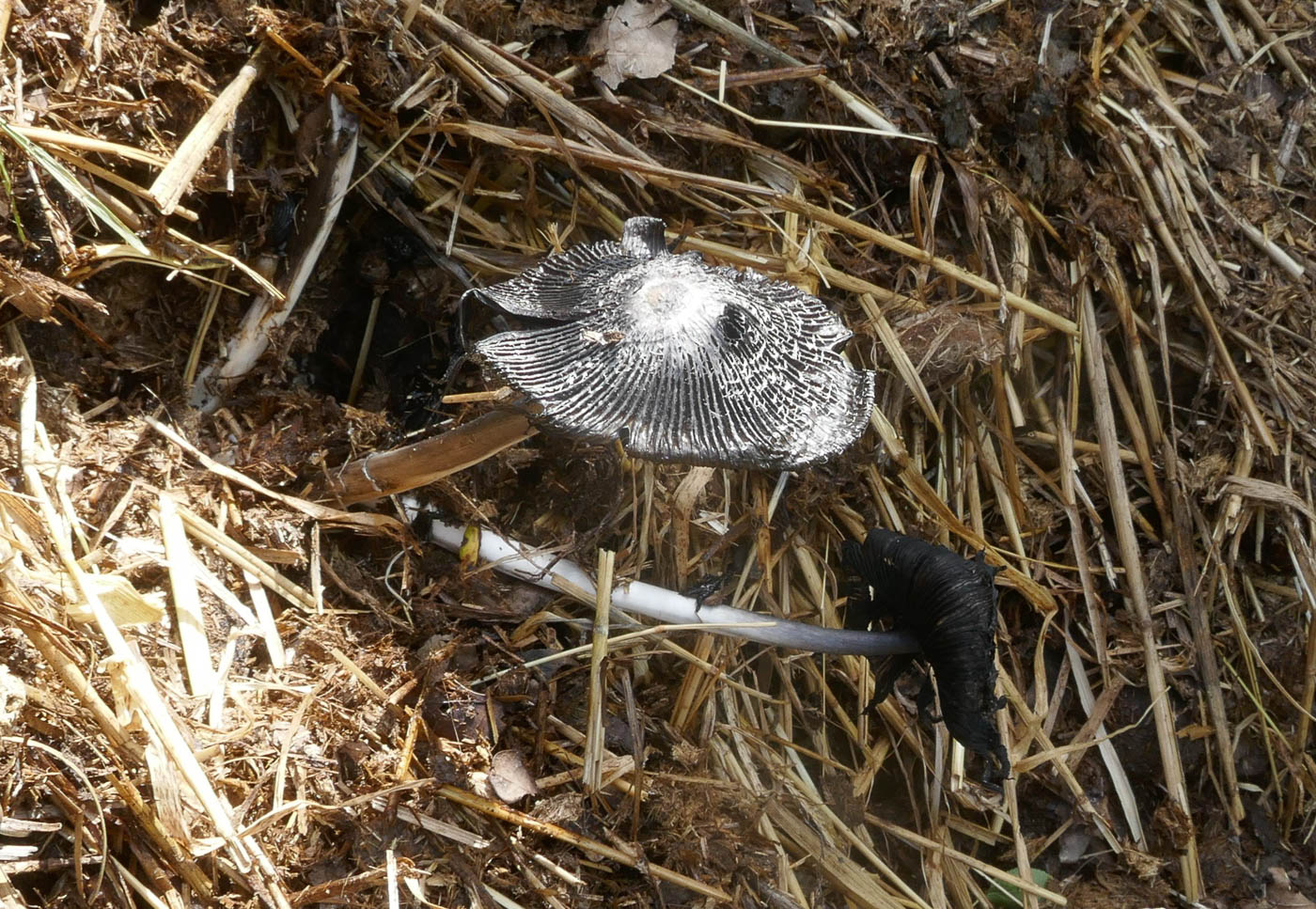
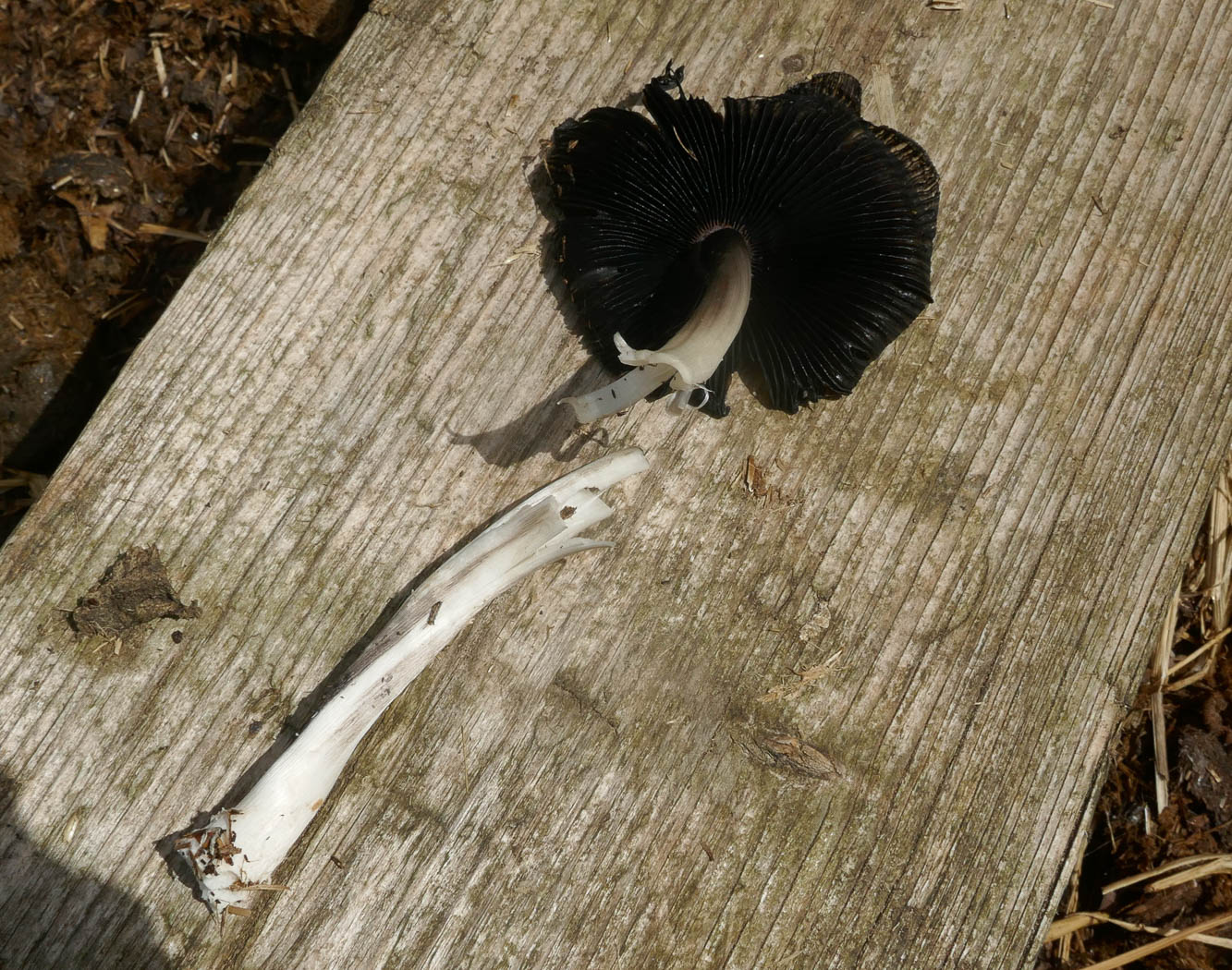 |
May 28th Coprinus sterquilinus (Midden Inkcap) After some much needed rain Jackie Ewan checked the dung heap at Stampwell Farm and was rewarded with this well developed Inkcap which looked unfamiliar. Checking the spores she found they were enormous compared to the commoner dung inhabiting species, also the cap surface was still slightly scaly rather than powdery so she knew she had something interesting. She sent it to Derek who identified it for her. This is not a common species with only around 50 records on FRDBI and a previous Bucks records from Burnham Beeches which is on Finds. So a nice find from Jackie. Previous finds |
May 25th 2025
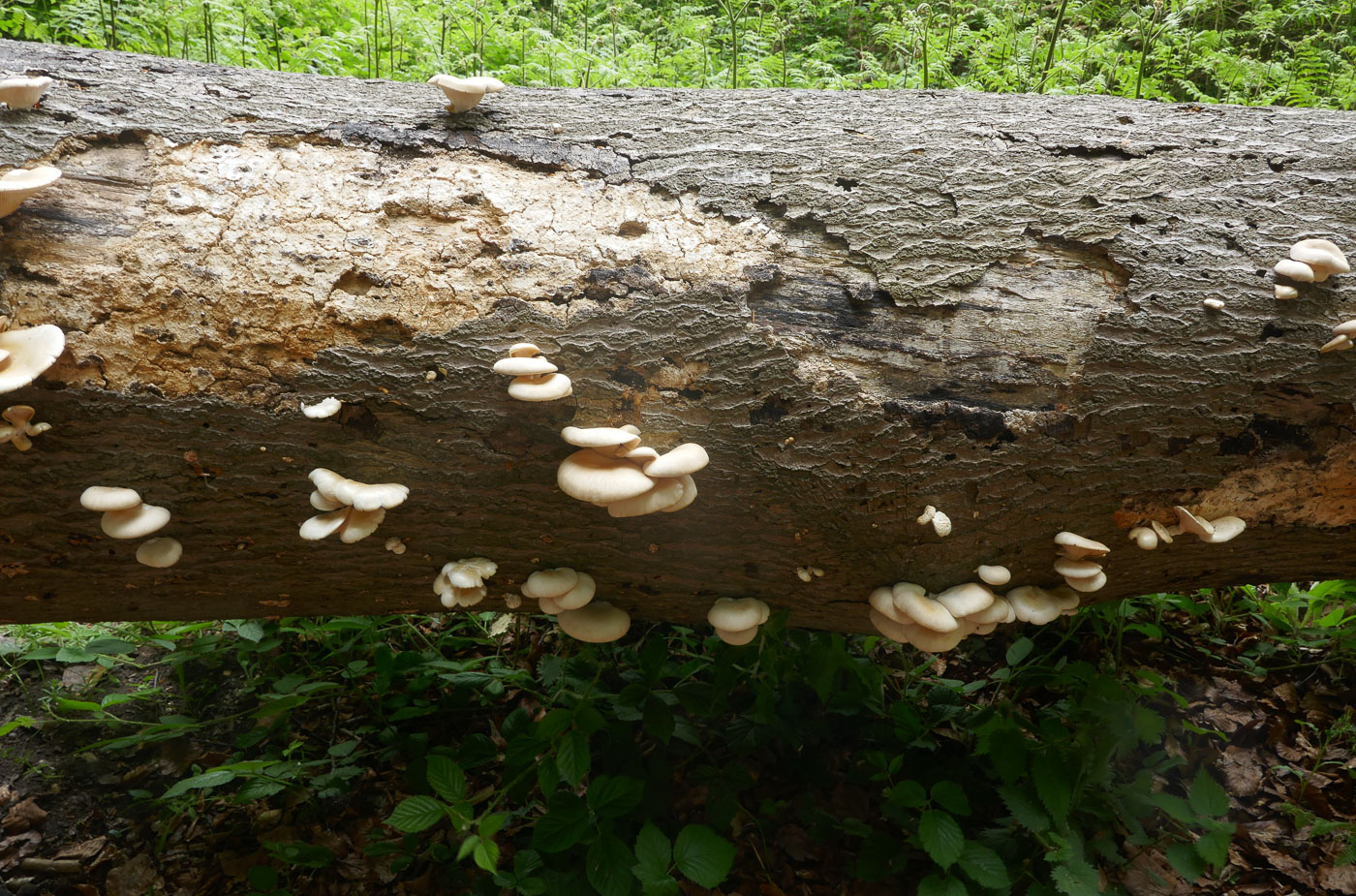
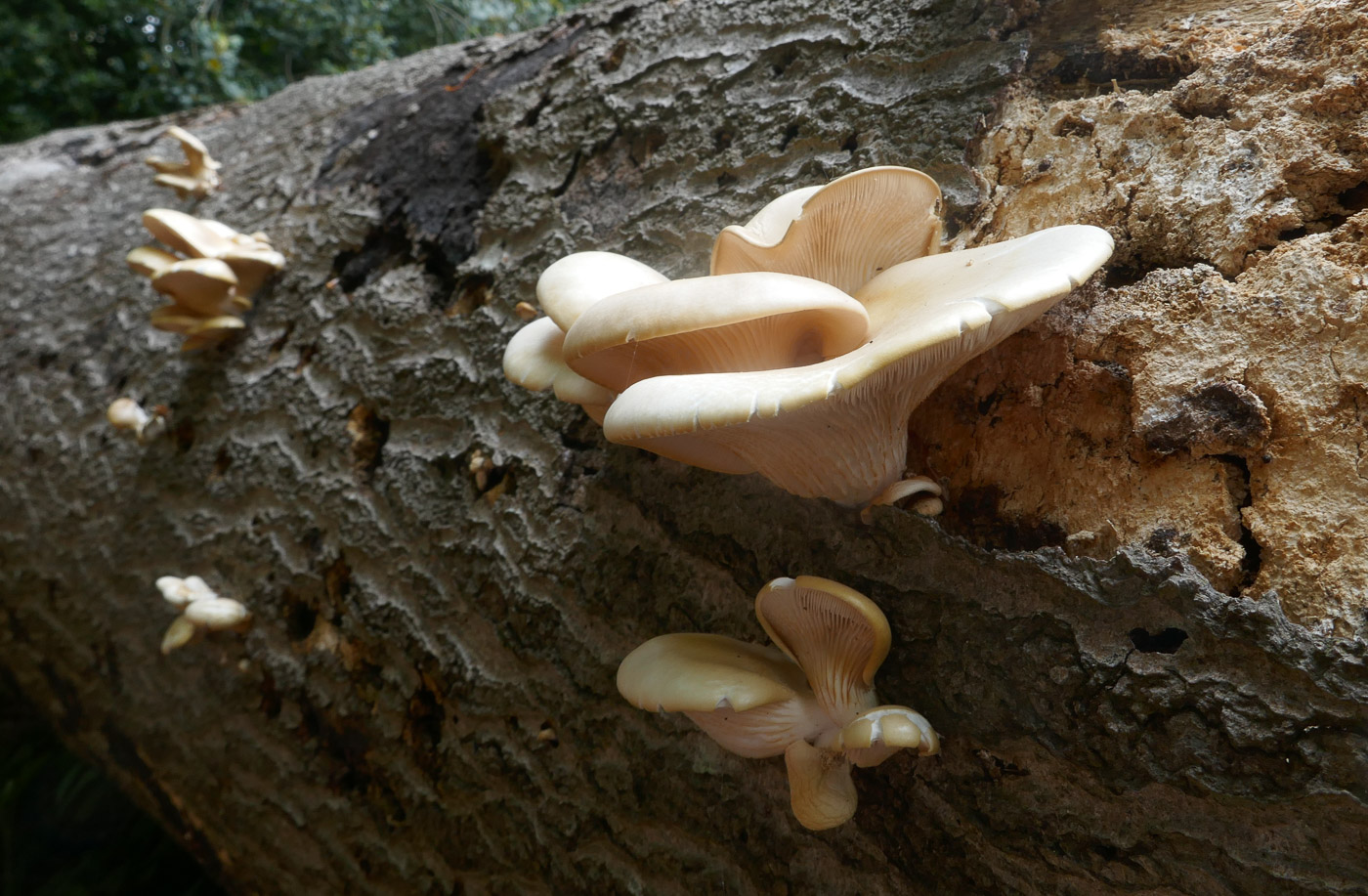
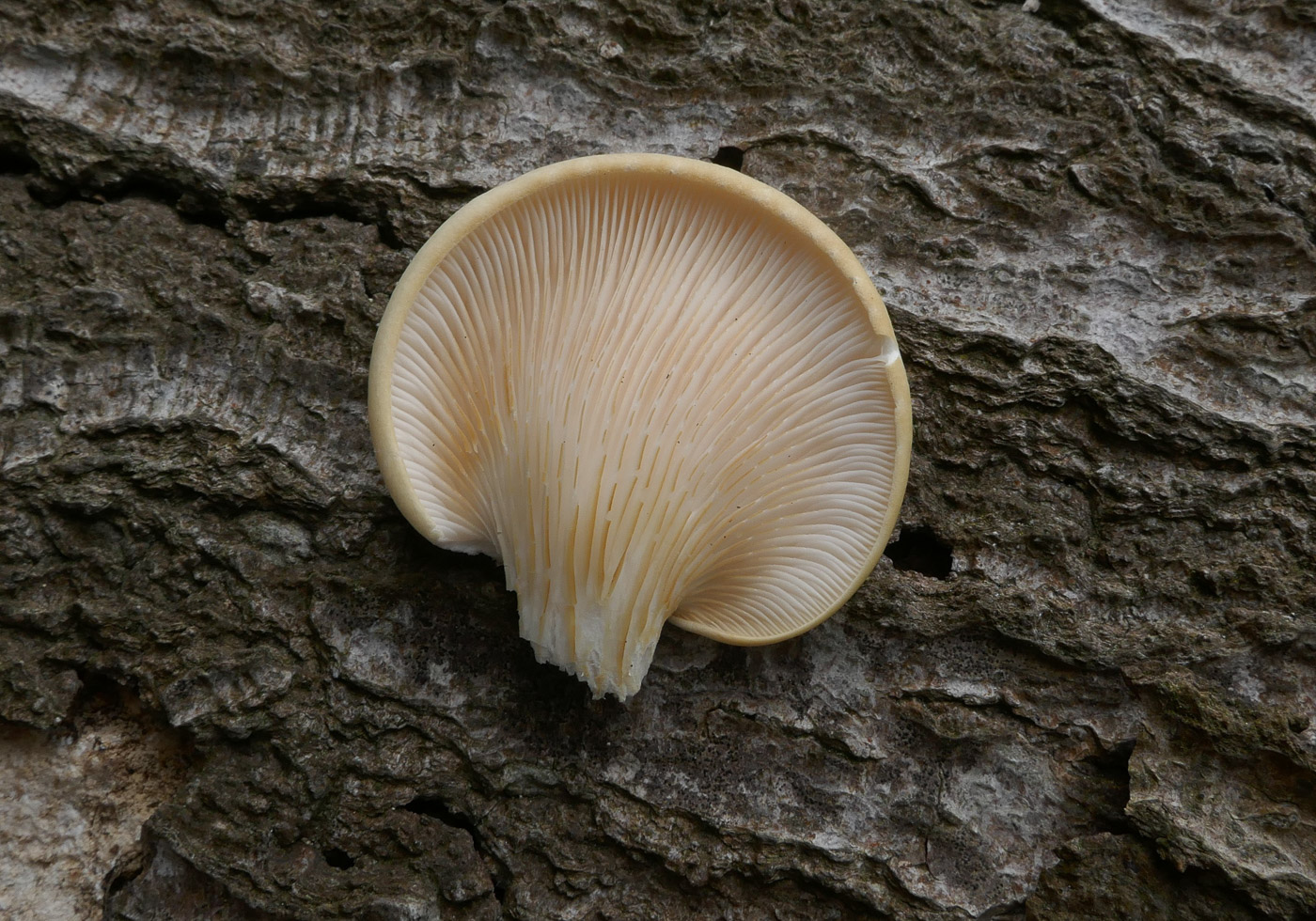 |
May 15th Pleurotus ostreatus (Oyster Mushroom) At Stampwell Farm Jackie Ewan came across this nice fresh crop on a fallen Beech trunk - and anything looking nice and fresh is a treat to see at the moment! At times of drought those species which grow in soil really struggle but those dependent on fallen wood thrive much better. Previous finds |
May 24th 2025

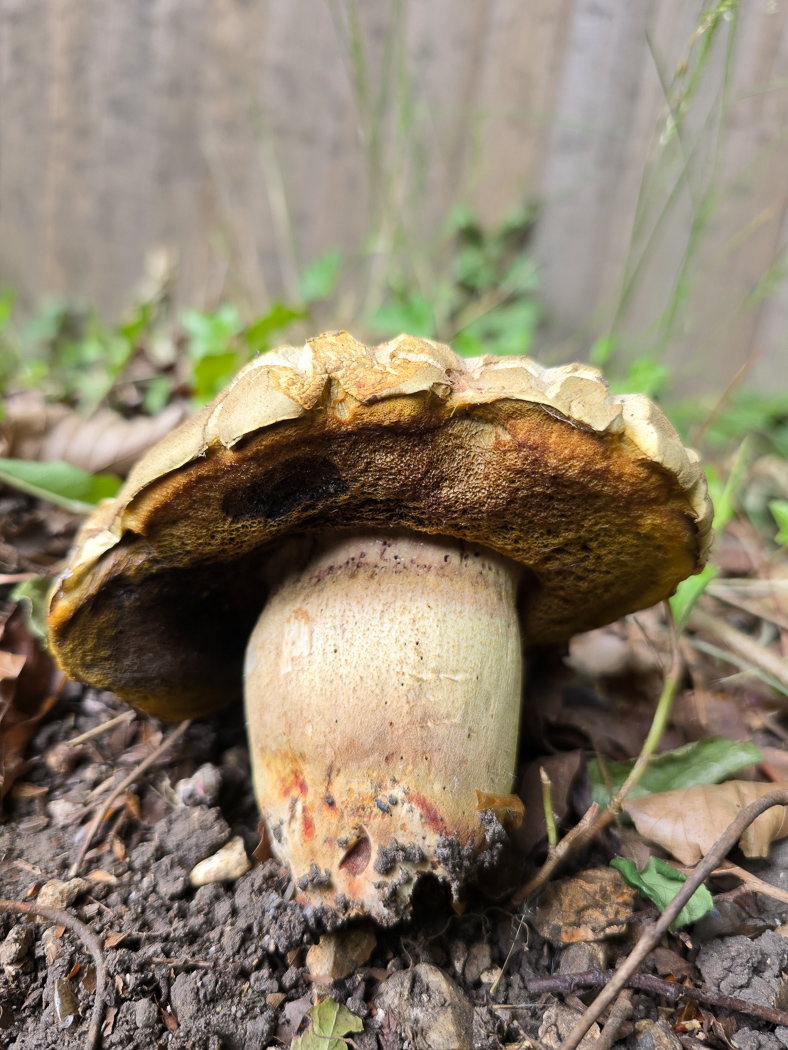 |
May 23rd Hemileccinum impolitum (Iodine Bolete) In Chalfont St. Peter Jesper Launder was astounded to come across this very early bolete which, though somewhat old and cracked, had somehow managed to force its way through the baked dry soil relatively unscathed. The species favours Oak and is one which has fine yellow pores which don't stain blue when pressed or damaged, but the most significant field character is its strong smell of iodine (hence its English name) best detected at the stem base and which Jesper noted was very evident today. Previous finds |
 |
May 22nd Microbotryum tragopogonis-pratensis (Goatsbeard Smut) Jesper Launder, whilst visiting Homefield Wood to enjoy the orchids, found this unusual smut species - a plant parasite - strongly affecting the flower development of Tragopogon pratensis (Meadow Salsify or Goatsbeard). This was a new species to him despite the fact that he has a particular interest in such species, and can apparently affect both T. pratensis and porrifolius (Common Salsify) in May and June. Penny found that under its previous genus name, Ustilago, we have just one previous county record dating from 1990 when identified by Elizabeth Mordue, a recognised authority on rusts and smuts so the record is not to be discounted despite it being 35 years ago! This was a nice find. New find |
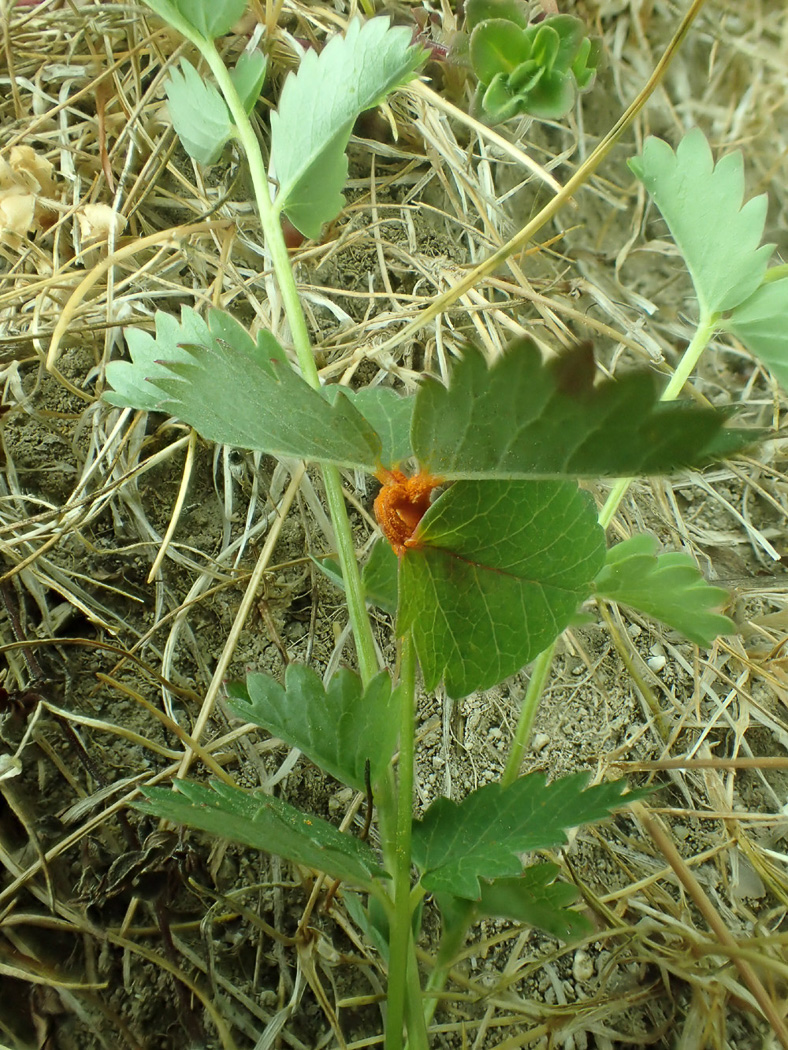
 |
May 22nd Phragmidium sanguisorbae (Salad Burnet Rust) Sarah Ebdon, whilst visiting Homefield Wood to enjoy the orchids, found this rust species which is host specific to Sanguisorba minor (Salad Burnet). This was a new Finds entry in 2024 when she discovered it at this same site just a week later in the year. See the notes on that entry for a little more about the species. Previous finds |
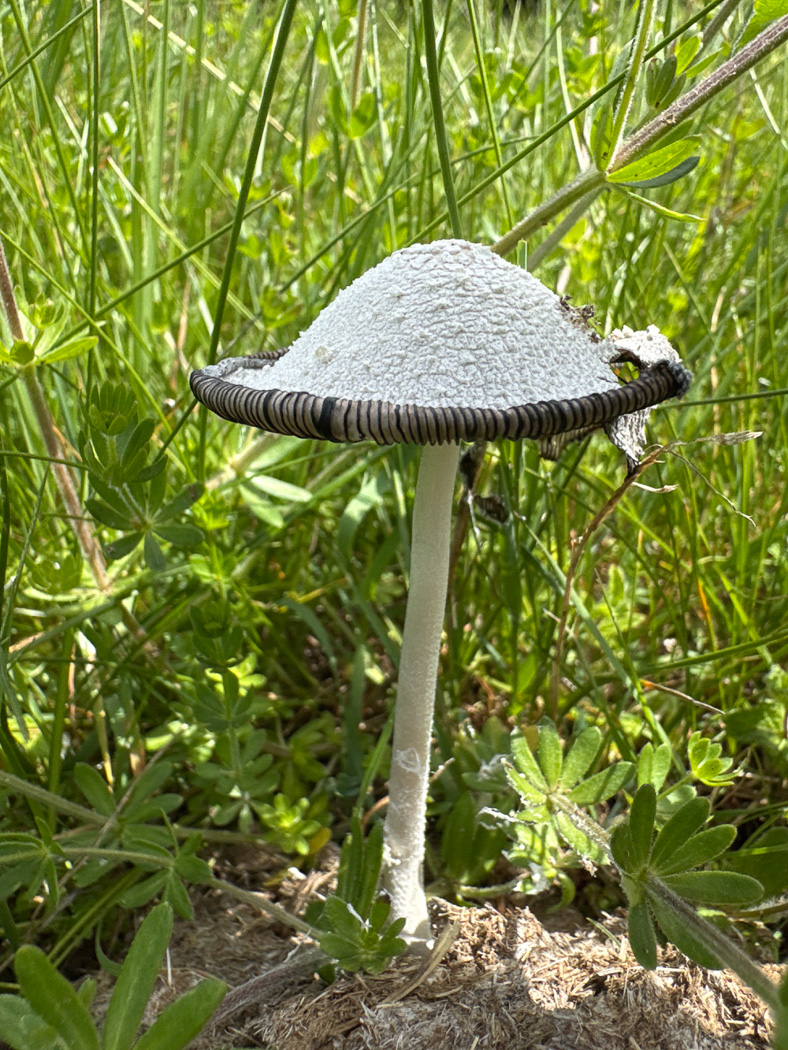
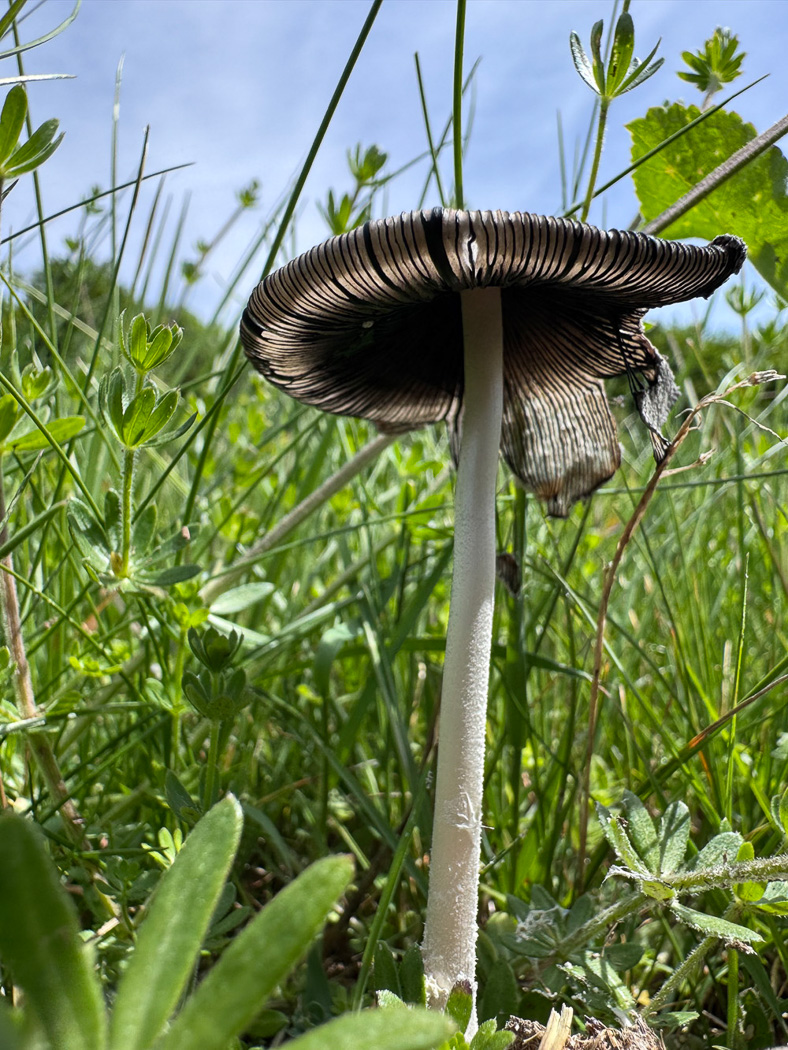 |
May 20th Coprinopsis nivea (Snowy Inkcap) When visiting Yoesden Bank, a BBOWT Reserve near Bledlow Ridge, Jackie Newcombe was surprised to find this Inkcap growing on some very desiccated cow dung. She reports it was a good size, 8cm tall, with a pure white cap, the stem covered in powdery, cottony fibrils and the rim of the conical cap had curled up to reveal the typical dark brown gills. Penny confirmed her ID from the photos and then discovered that though not rare this appears to be a new entry for Finds. It's worth comparing the species with the less common C. pseudonivea, a very similar dung species but which has a pinkish flush to the cap when young rather than pure white of C. nivea. New find |
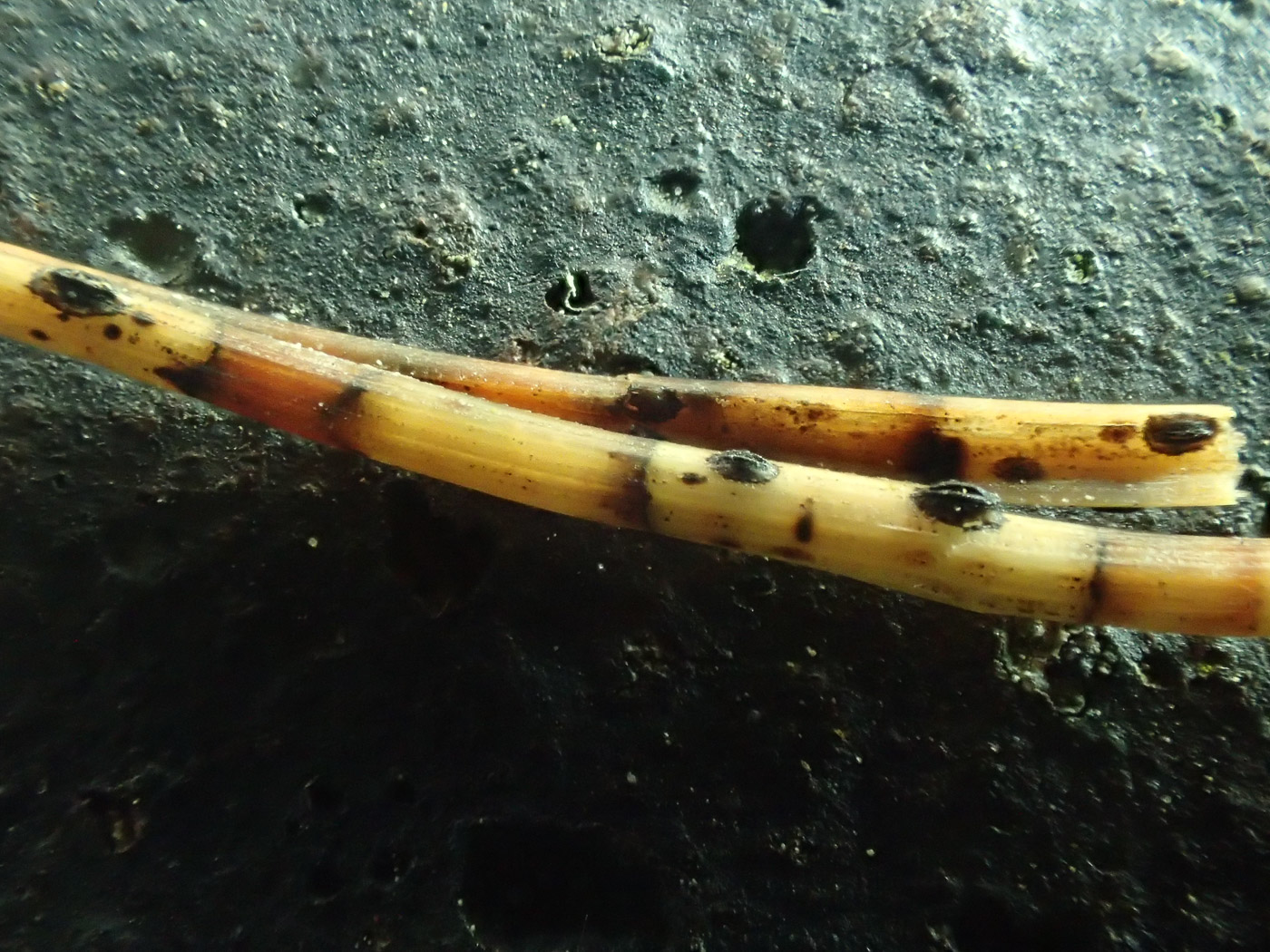
 |
May 18th Lophodermium pinastri (Pine Needle Split) At Burnham Beeches this species, found by Sarah Ebdon on our BFG Walk, didn't make it onto Penny's list but is worth including here as it is a new species for Finds and we apparently have no records of it since 2014 though it is described as very common. It occurs exclusively on fallen Pine needles or cones, looking like tiny raised oblong black 'lips' dotted along the needle, though there are many similar species in the genus which occur on other substrates. New find |
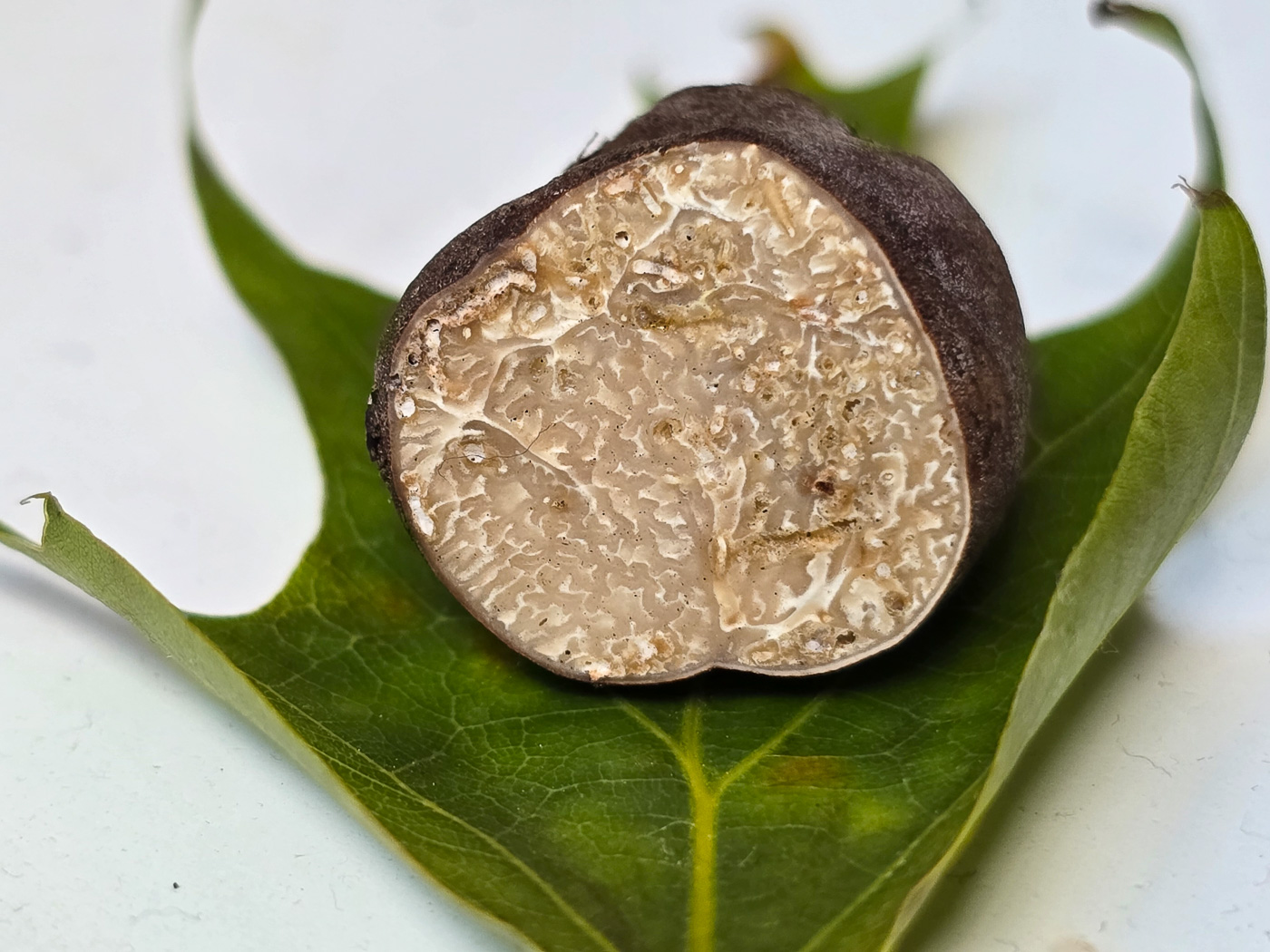 |
May 18th Tuber rufum (Red Truffle) In a lawn under a Red Oak in Chalfont St. Peter Jesper Launder uncovered this truffle, one which he seems to find fairly regularly now in early summer though his last find was earlier this year in February. It is described as occurring mainly in late summer and autumn (under a range of trees, both deciduous and conifer) but records from this period seem less frequent - maybe because the main focus is then on above ground fungi! Previous finds |
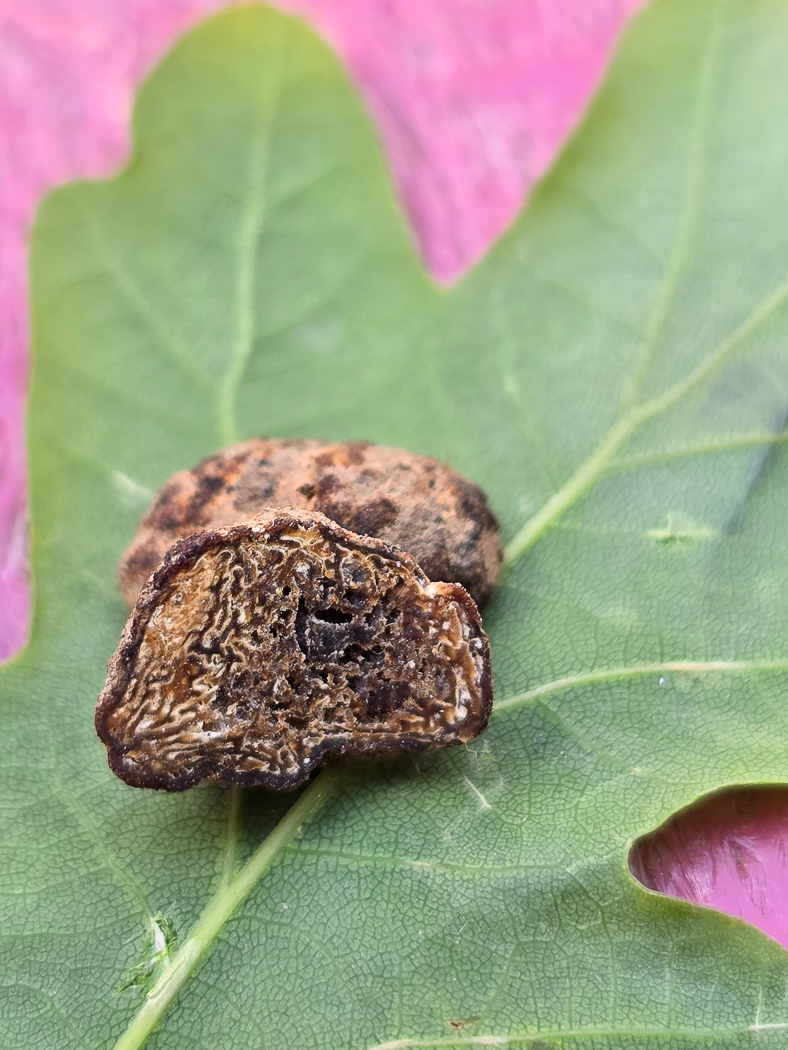 |
May 18th Hydnotrya tulasnei (Red Fold Truffle) Jesper Launder paid a visit to one of his favourite truffle spots, under an Oak in Little Chalfont, and was rewarded with a rare species he found here new to the county last June. (See the notes on that entry for more about its rarity.) The genus name apparently stems from the Greek for truffle: Hydnon - though Penny doesn't follow the link from this stem to those hydnoid basidiomycetes which are above ground with spines rather than gills?! This is one of the 'true' truffles, ie ascomycetes (the 'false' truffles being basidiomycetes) and is separated microscopically from the other three species in the genus by its virtually round spores housed within an ascus which can be either conventionally shaped - like a sausage - or irregularly sacate - rounder. Luckily, as today's specimen failed to yield useful microscopic detail, Jesper was from experience able to identify it securely from its macro-characters. It can apparently occur under a range of different trees, both deciduous and conifer. Previous finds |
May 13th 2025
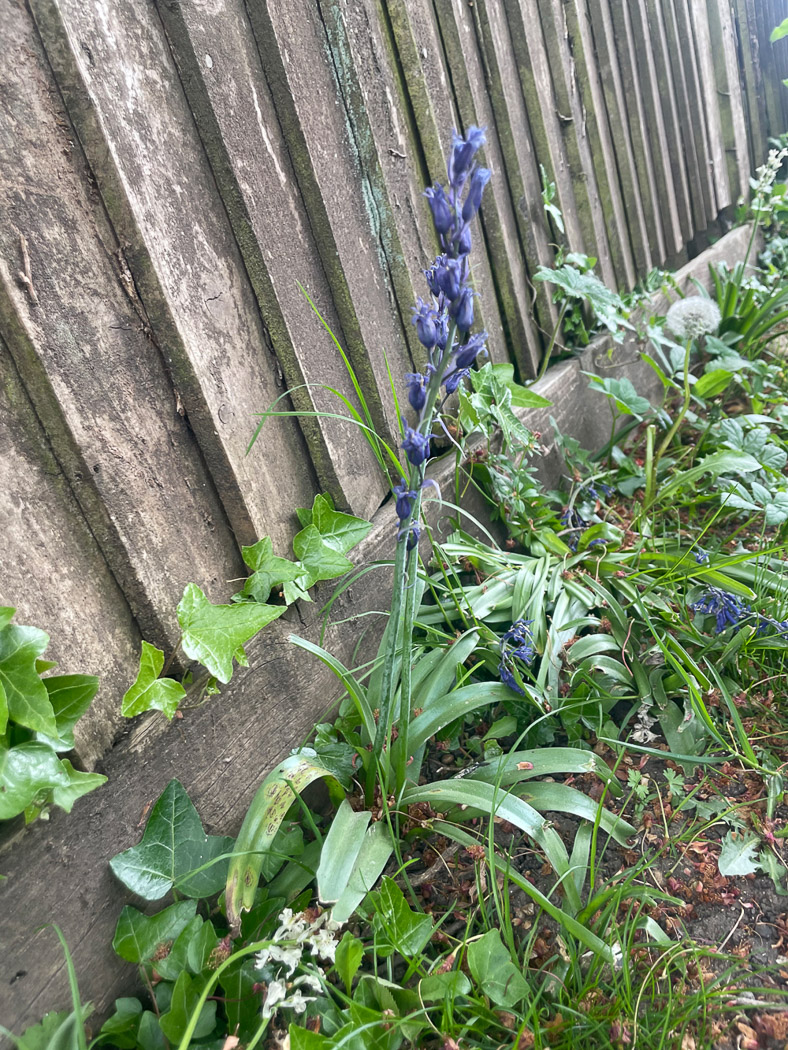
 |
May 8th Uromyces muscari (Bluebell Rust) This is a species Sarah Ebdon found for the first time last spring, and has therefore been on the lookout for. After many recent unsuccessful searches she eventually found it on a native bluebell near a fence in the Amersham area. (Apologies here for a non fungal point of interest: there is often discussion about the detrimental effect the non-native 'Spanish Bluebell' might be having on our native Hyacinthoides non-scripta, but a recent paper has in fact proved otherwise. If interested, click here for more information.) Previous finds |
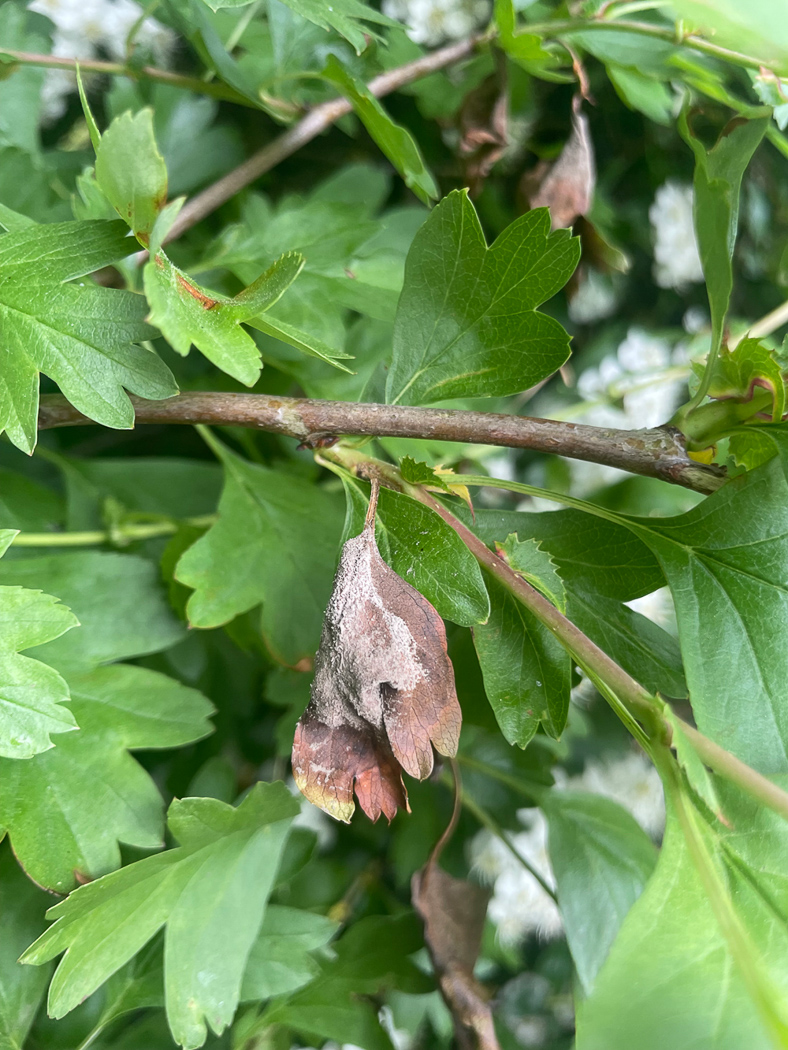 |
May 3rd Monilinia johnsonii (Haw Goblet) Whilst walking near Woodrow Sarah Ebdon smelt a familiar sickly sweet but unpleasant smell which rang a bell! This was from a small fungus which she'd come across last spring and which causes Leaf blight in Hawthorn at this time, the smell of which is thought to mimic that of Hawthorn blossom in order to attract insects. In autumn one can find the small stemmed cups of a further stage of this fungus on the fallen haws. Sarah recognised the smell instantly because though reportedly fragrant and possibly with a Germolene component(!) she actually finds it quite stomach churning! From her reaction to the smell she knew there must be Hawthorn close by, then discovered a bush in the hedge some 20 odd paces behind her, and sure enough there were just a few affected leaves! Previous finds |
May 12th 2025
|
|
May 10th Morchella elata (Black Morel) Jesper Launder was amazed to spot the distinctive shape of these beauties in a mulched flowerbed in the outskirts of Beaconsfield. How they should be managing to fruit so late in spring despite the unfavourably dry conditions over the last month or more is remarkable. All our handful of county records were found in April, the latest being the 23rd, though checking in FRDBI there are a smattering of May records though the vast majority are from March and April so it's not that unusual. But what is surprising is that they should find enough moisture at the moment when fruitbodies of any kind have been conspicuous by their absence. Jesper suggests that the shade from a nearby Beech together maybe with some artificial watering of the bed could be responsible. Whatever the reason, it was a nice surprise! Previous finds |
May 11th 2025
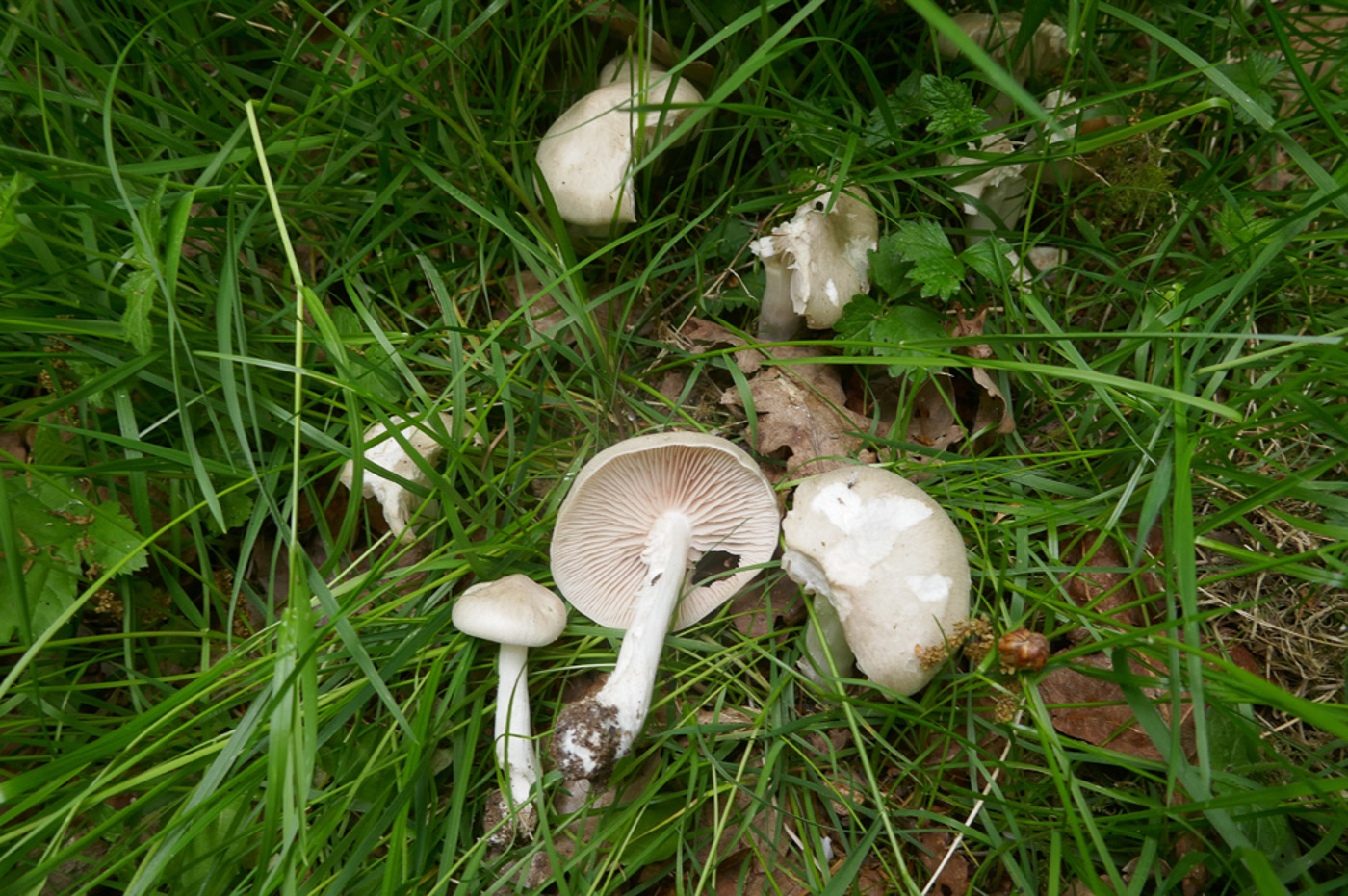
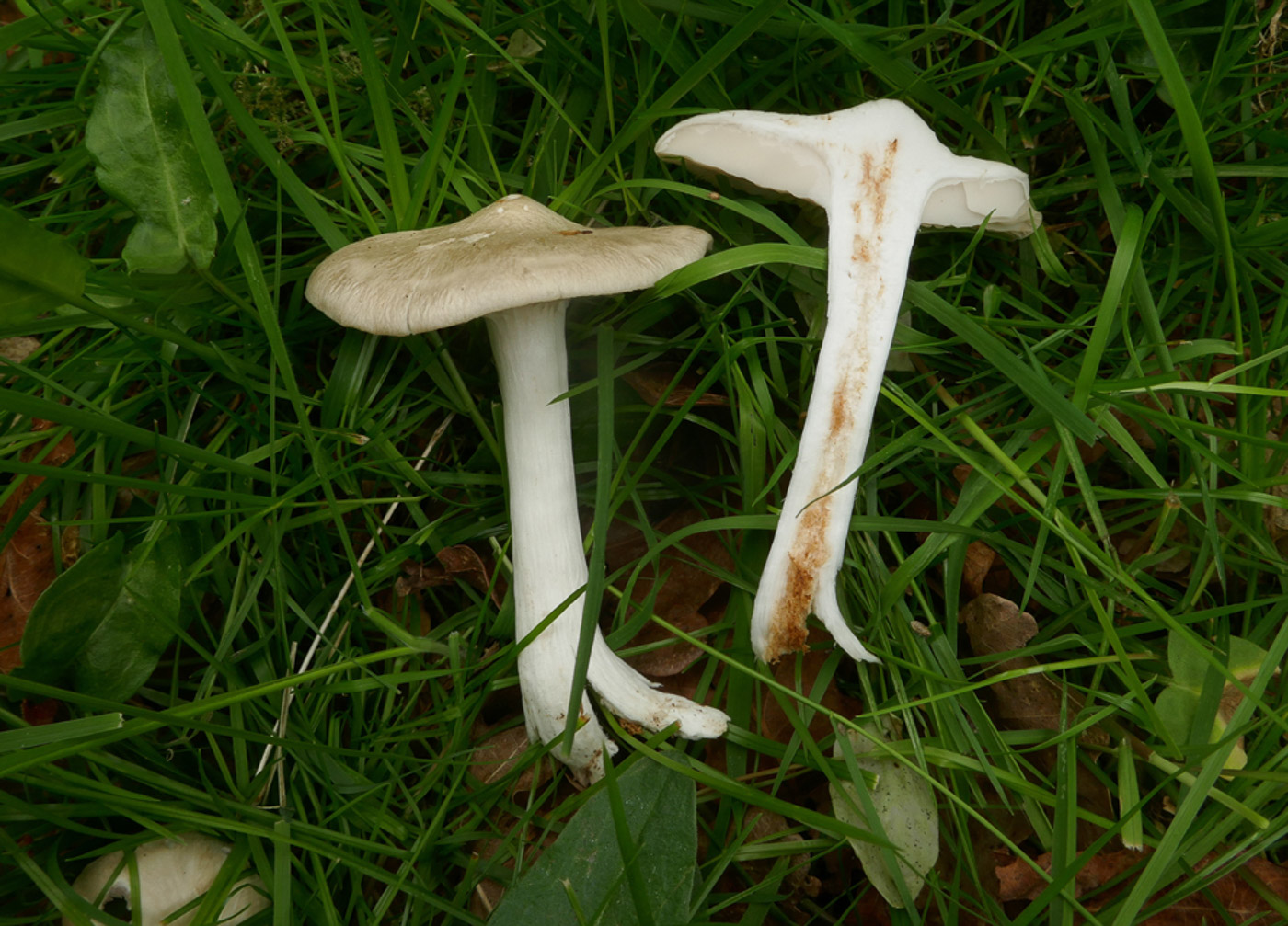
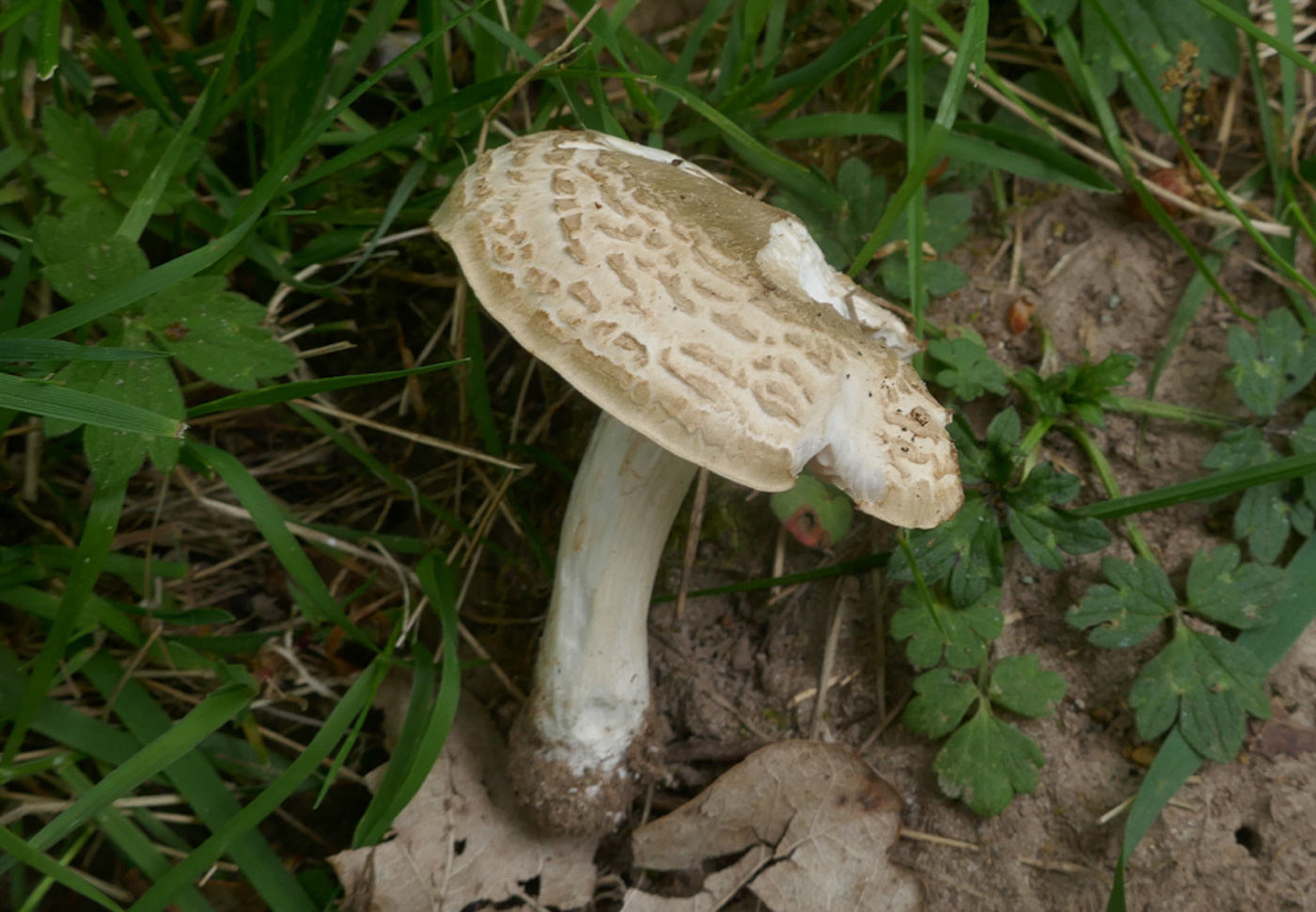 |
May 6th Entoloma clypeatum (Shield Pinkgill) At Stampwell Farm Jackie Ewan was please to find this species beginning to fruit under the Plum suckers in a grassy spot where she's found it for several years at this time. This is quite a sizeable Pinkgill which favours Prunus and occurs in late spring so its timing is spot on here. Note how one of the caps looks unusually broken up and cracked making it more like perhaps an Agrocybe - no doubt as a result of exposure to the hot sun. Previous finds |
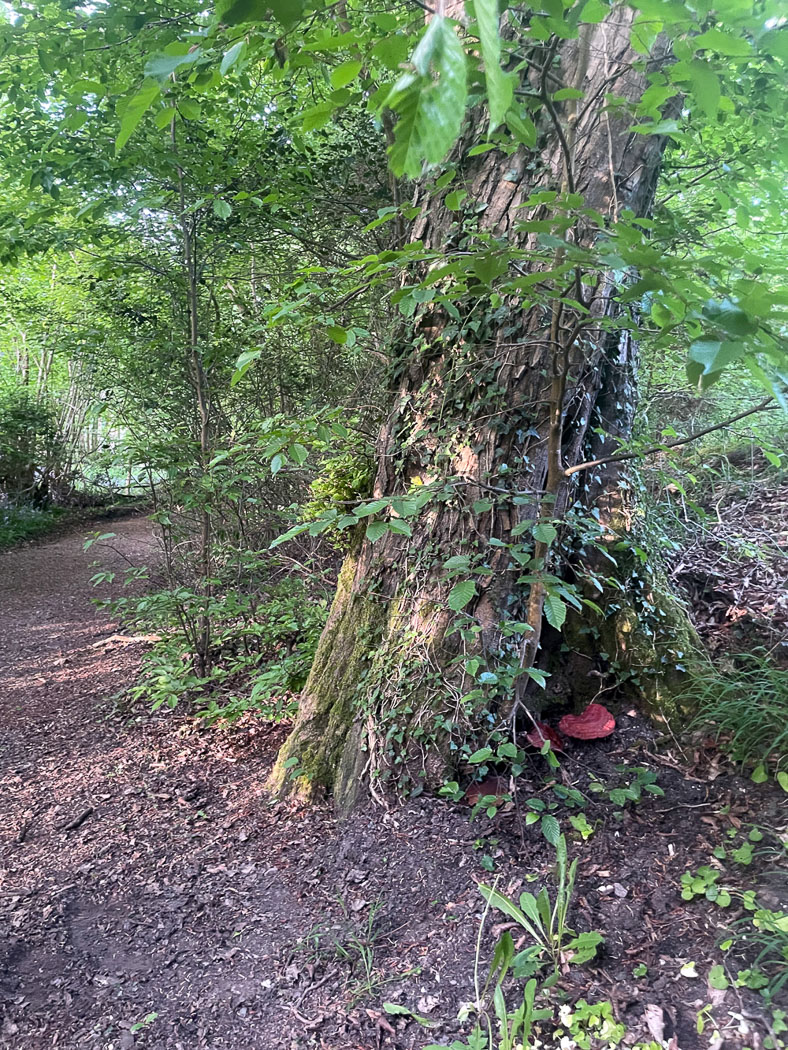

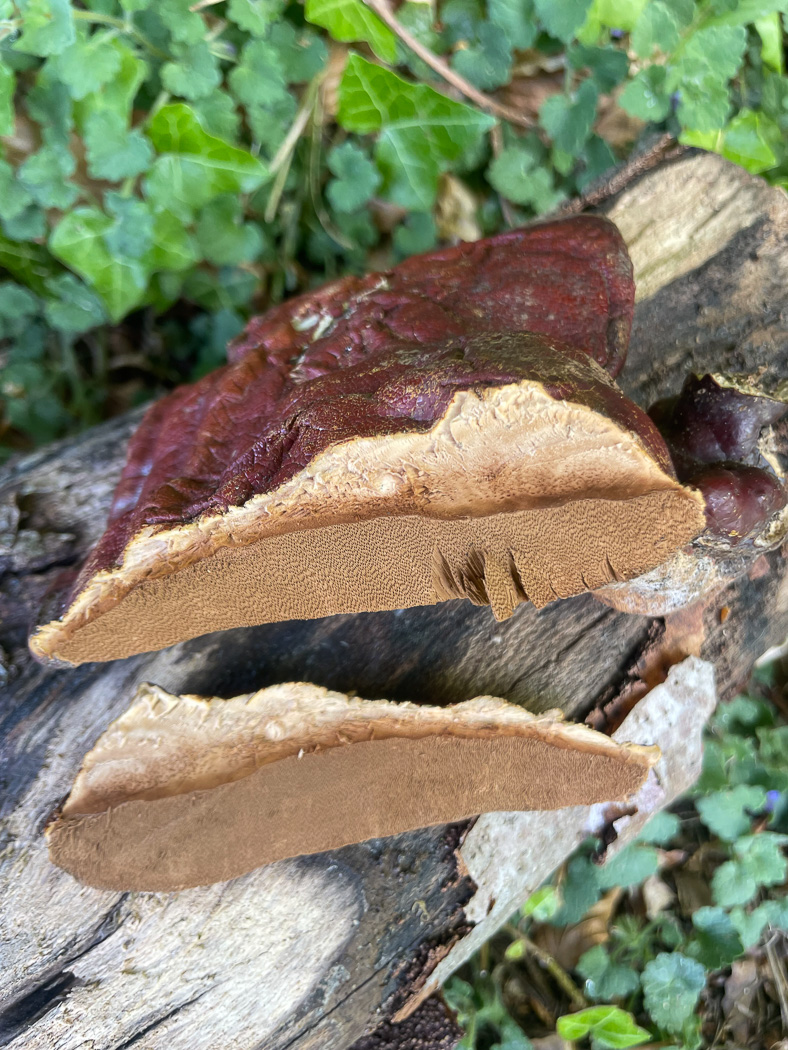 |
May 6th Ganoderma cf. resinaceum (a bracket with no English name) In Gt. Missenden Sarah Ebdon found this smart pair of brackets at the foot of a Hornbeam, and recognising that from its reddish colour and also notable stem it was probably an interesting species of Ganoderma she collected one to check later. The reason for the 'cf' in the name here is that she found some conflicting characters which made it tricky to be confident whether this was G. resinaceum or the rarer G. lucidum (Lacquered Bracket). G. lucidum is known to be the species within this genus which has a distinct stem, therefore this collection fitted that particular to a T; however, Sarah found not only that the spores were a better fit for G. resinaceum but also the dark line she found within the context (see photo 4) when cut open together with the slight bubbling of the upper surface when put near a flame were not characteristic of G. lucidum. From its appearance both Penny and Derek are leaning towards G. lucidum, so a sample will be sent for sequencing which we hope will resolve the matter. Watch this space! Previous finds |
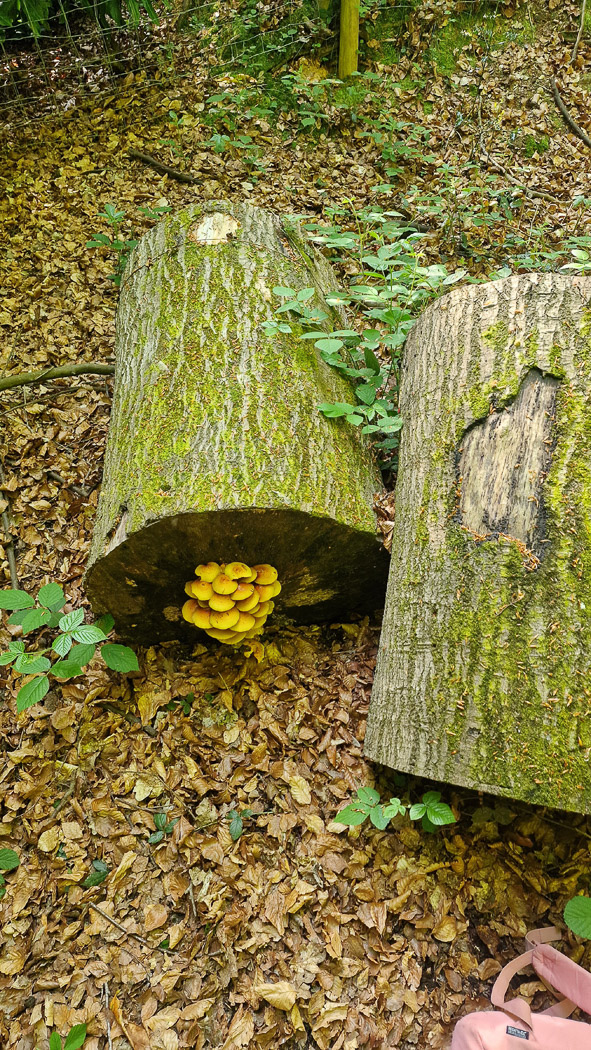
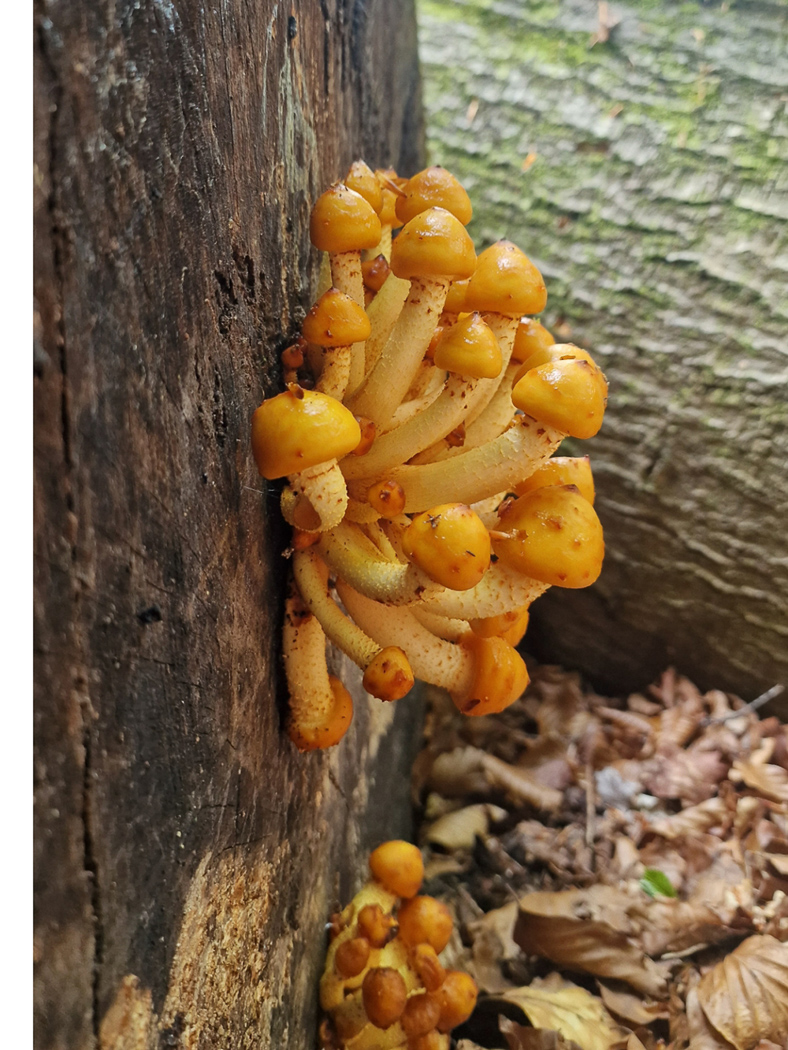
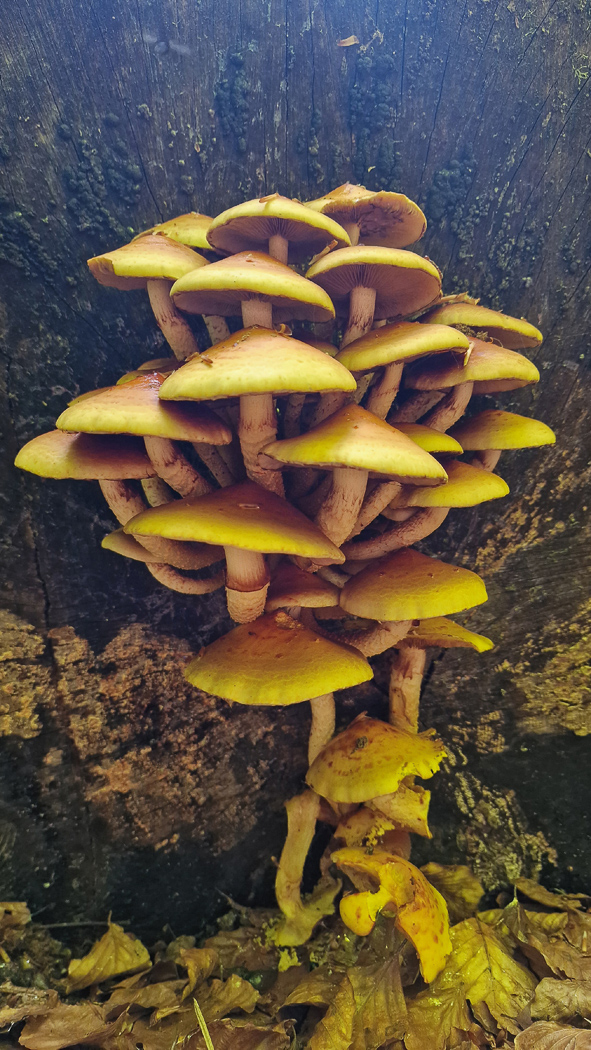
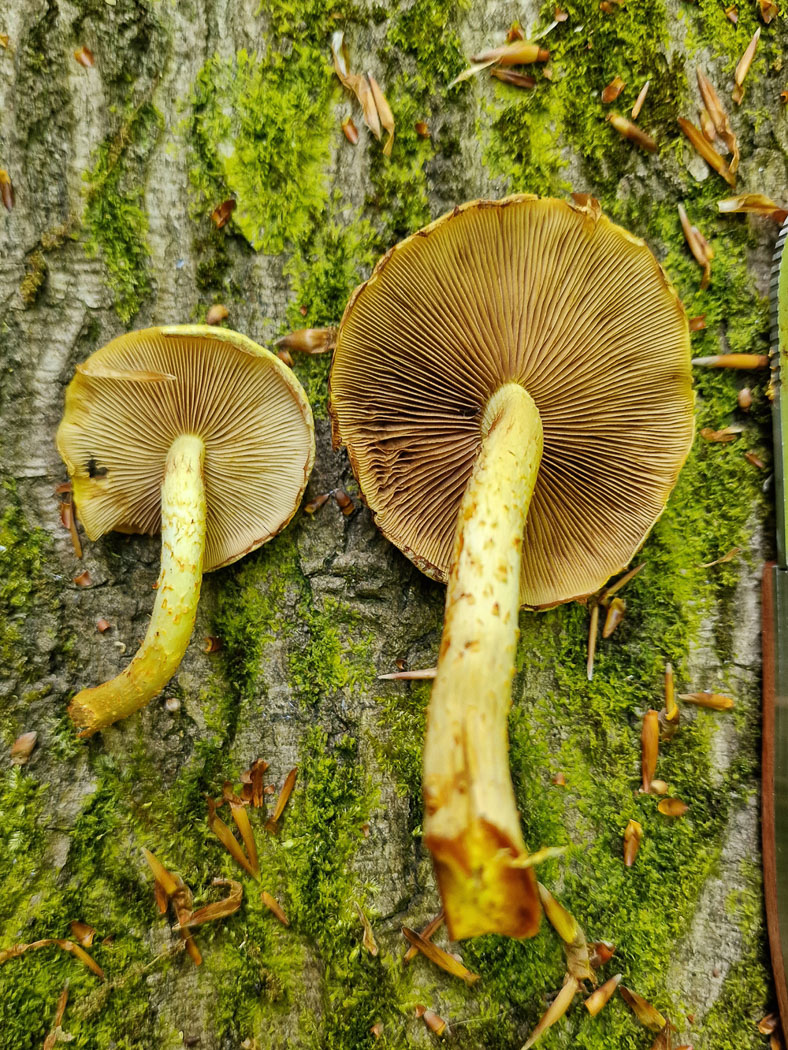 |
April 27 Pholiota adiposa (a species of Scalycap with no English name) Lisa Rock was walking in Lower Woodend (nr Marlow) and her attention was drawn to this stunning tight cluster just forming on the sawn off end of a Beech log. She returned a few days later when the cluster had developed further with caps now fully open and other features now better visible. Unlike the much more common P. squamosa which has a dry scaly cap, this species has a sticky greasy cap though in dry weather this feature becomes less obvious. Note the stem is also scaly and the gills are rusty yellow. It favours Beech and is often in tight clusters as here. Previous finds |
April 24th 2025
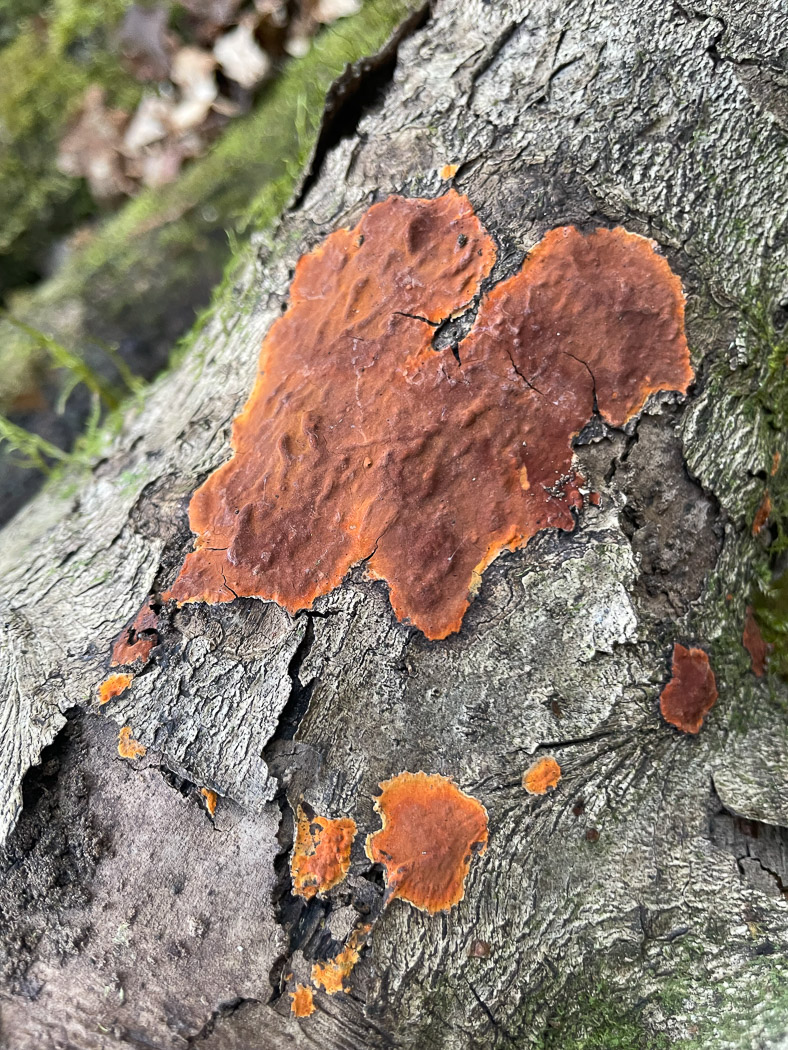 |
April 9th Hypoxylon subticinense (a rare Woodwart with no English name) At Burnham Beeches Sarah Ebdon and Jesper Launder made a B-line for a particular log pile, mainly Beech, where we'd found several interesting species on our Walk here last April including this unusual Hypoxylon which was then new to the county (see my report for April 17th, 2024) .Sure enough, after turning various logs they found it fruiting in abundance on the fallen Beech branches. Sarah says that her photo shown here really doesn't do justice to its brilliant ochre-orange colour which singles out this species from others, nor does it form the typical round 'warts' with which we are familiar in the much more common species of Hypoxylon. So this is our second county record but the first entry for Finds, last year's collection was not included here as Finds is reserved for those collections made in the county apart from on our Walks. New entry |
April 22nd 2025
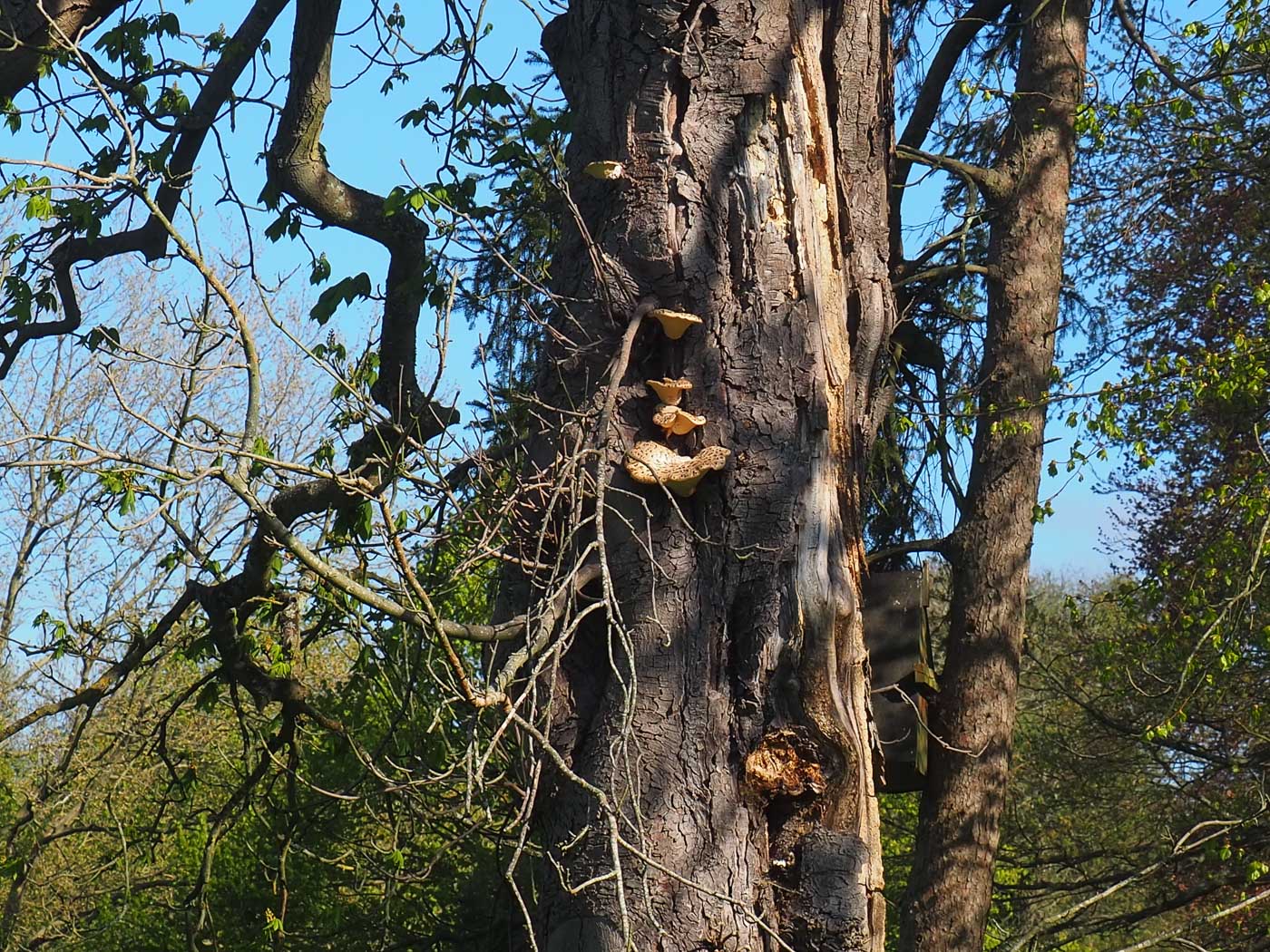
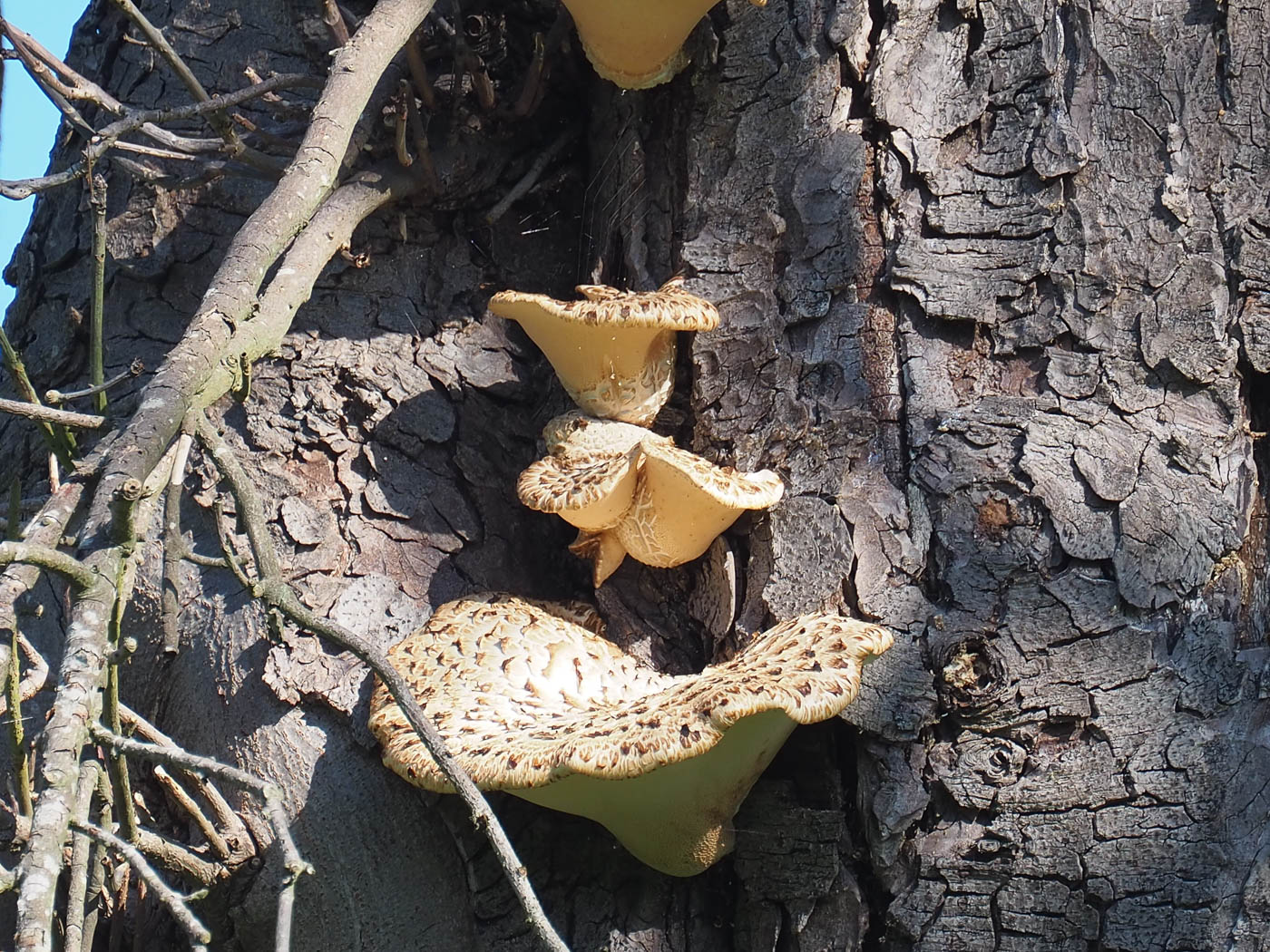 |
April 20th Cerioporus squamosus (Dryad's Saddle) In Hughenden Park John Catterson noticed this bracket on a standing Horse Chestnut trunk. Probably more familiar by its previous genus name Polyporus, the species is one of our most charismatic with its scaly upper surface, often becoming the size of a horse's saddle before ending up fallen to the ground. Often one can then detect its original spot where attached to the tree - often Ash - high up in the canopy. Previous finds |
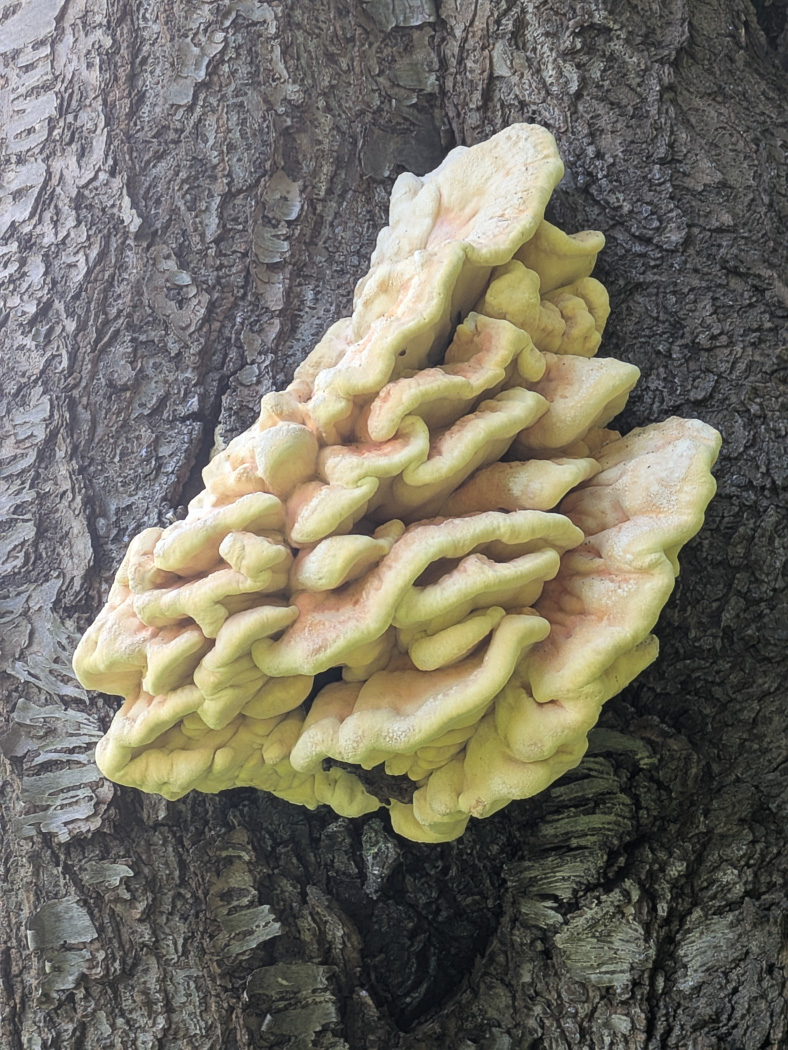 |
April 19th Laetiporus sulphureus (Chicken of the Woods) In High Wycombe Lisa Dodd noticed this fresh and sizeable bracket on a standing Wild Cherry. This is an attractive species which often fruits quite early in the year and certainly in our area seems to favour Cherry though it is not unusual to find it on other hosts. (The photo is Andrew Dodd's) Previous finds |
April 1st 2025
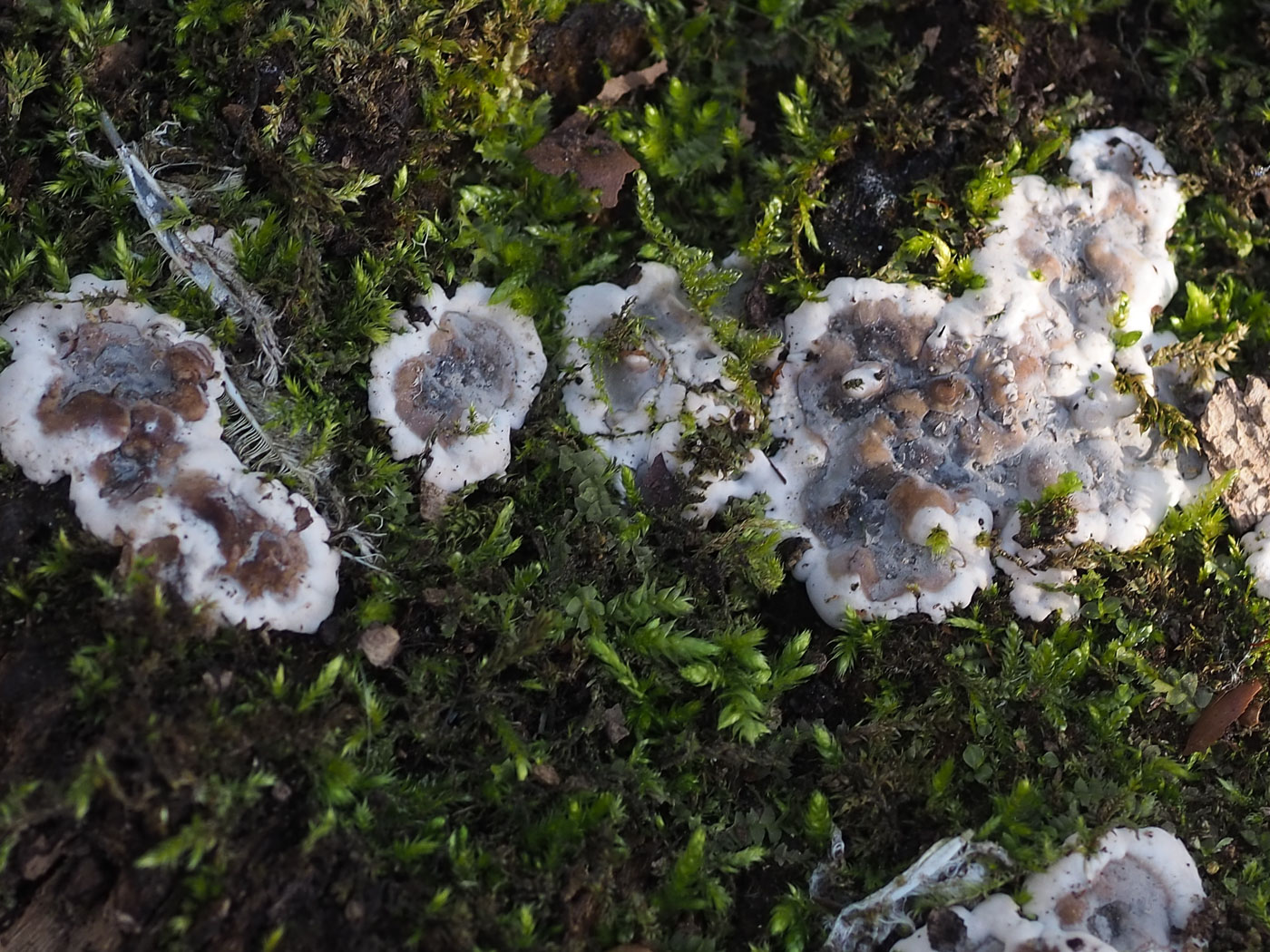
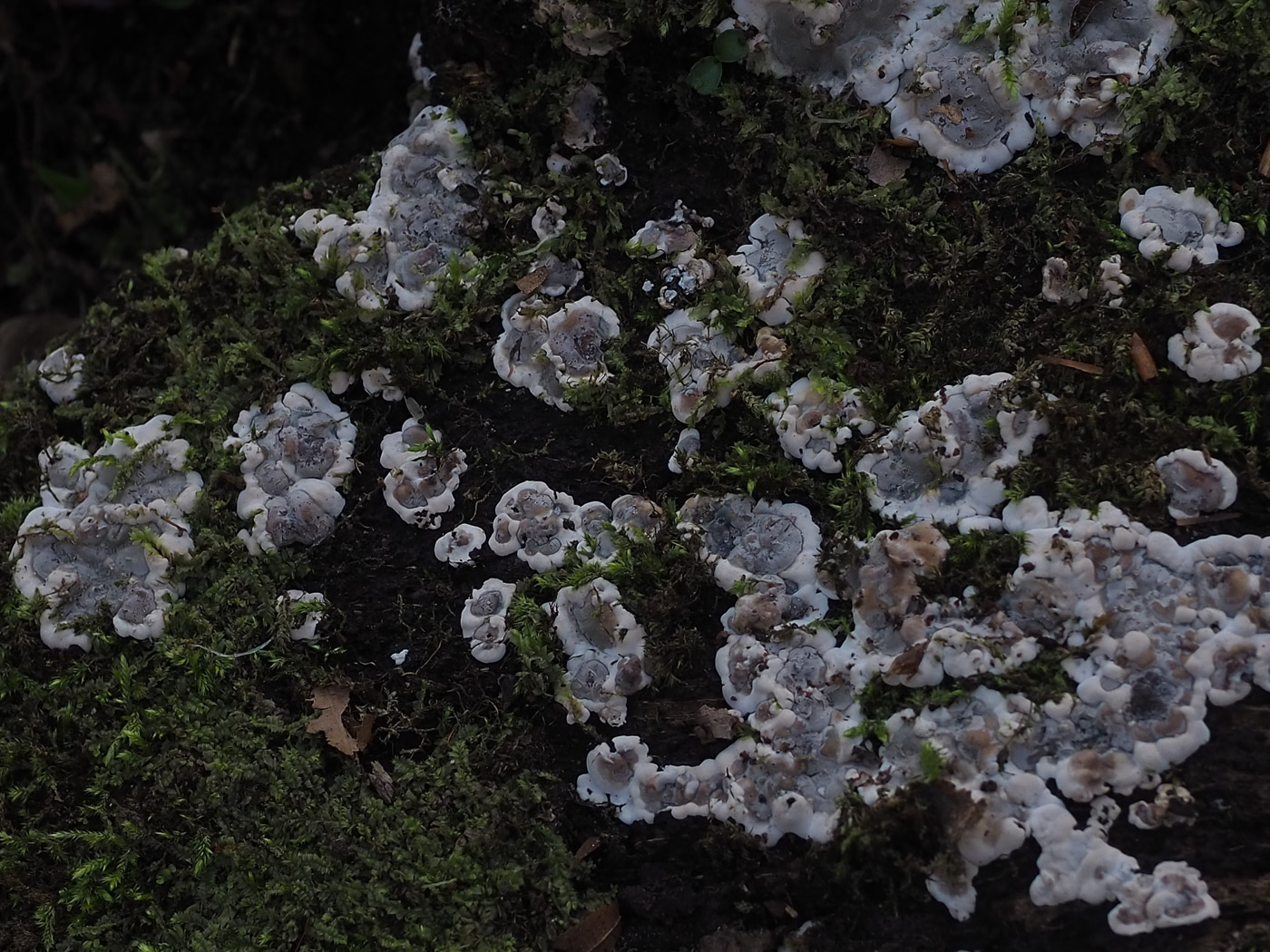 |
March 31st Kretzschmaria deusta (Brittle Cinder) In Tinkers Wood John Catterson struggled to find anything fungal of interest apart from some freshly fruiting Brittle Cinder on a mossy deciduous log. When at this early stage of development this pyrenomycete species looks nothing like the typical patches of black crumbly cinders which form later on. Previous finds |
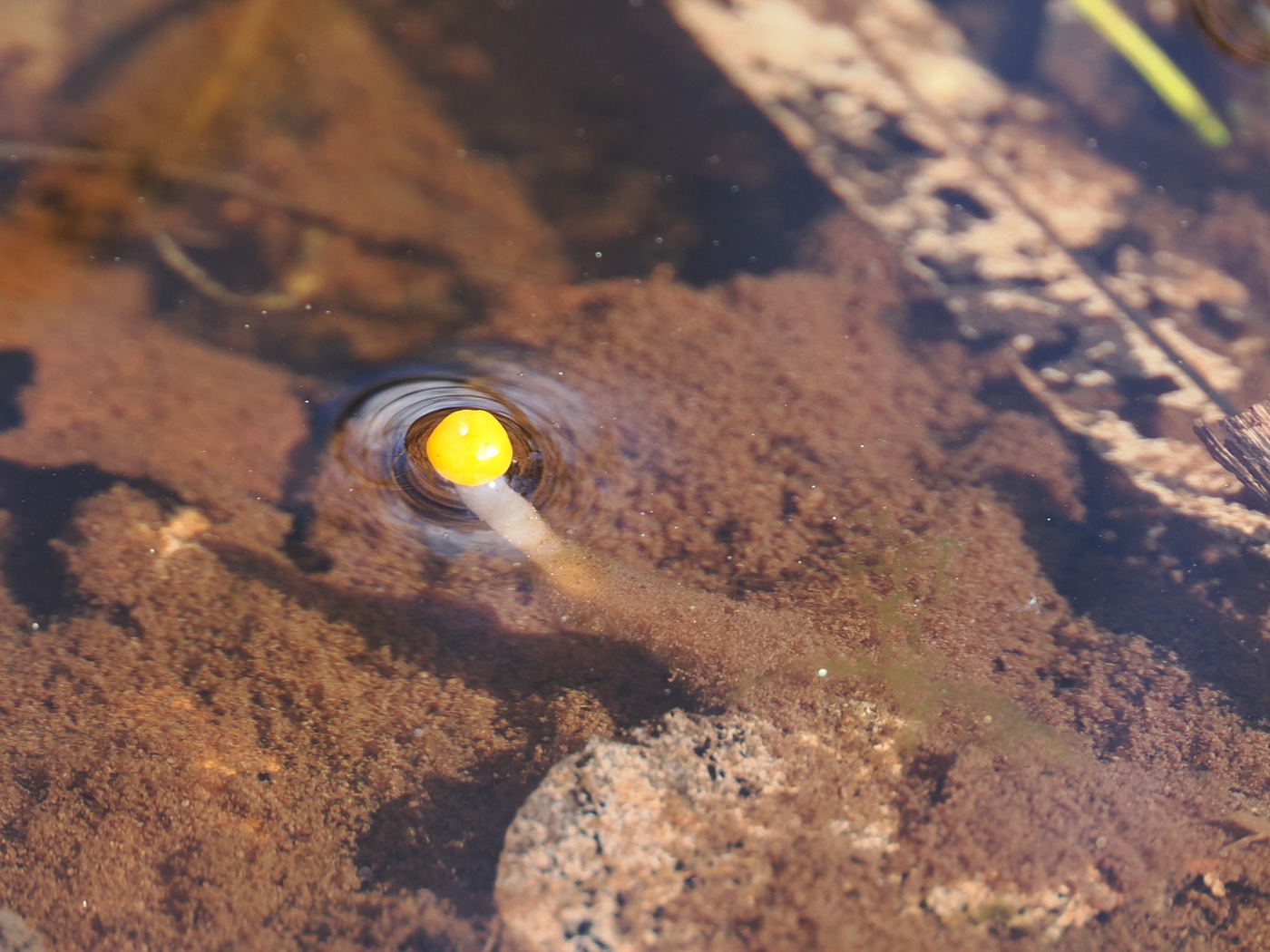 |
March 26th Mitrula paludosa (Bog Beacon) Claire Williams was on the look-out at Burnham Beeches for early signs of this springtime species and was rewarded with just this single example. We have plentiful records of it from the Mire - an area which provides the perfect habitat for this marsh-loving ascomycete, but this just beats last year's March record by several days! It remains to be seen whether it continues fruiting through till June as in some previous years. Previous finds |
March 26th 2025
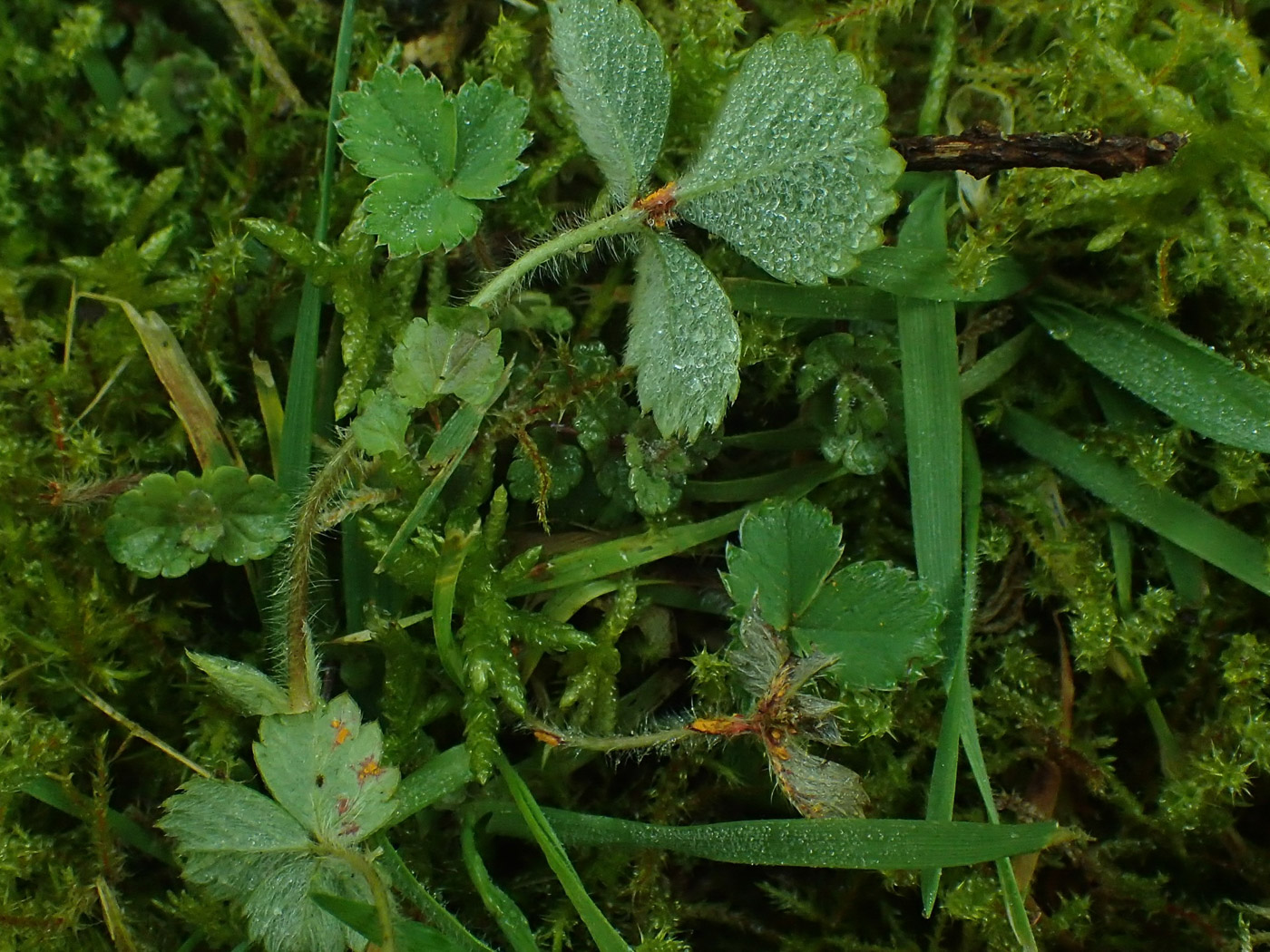
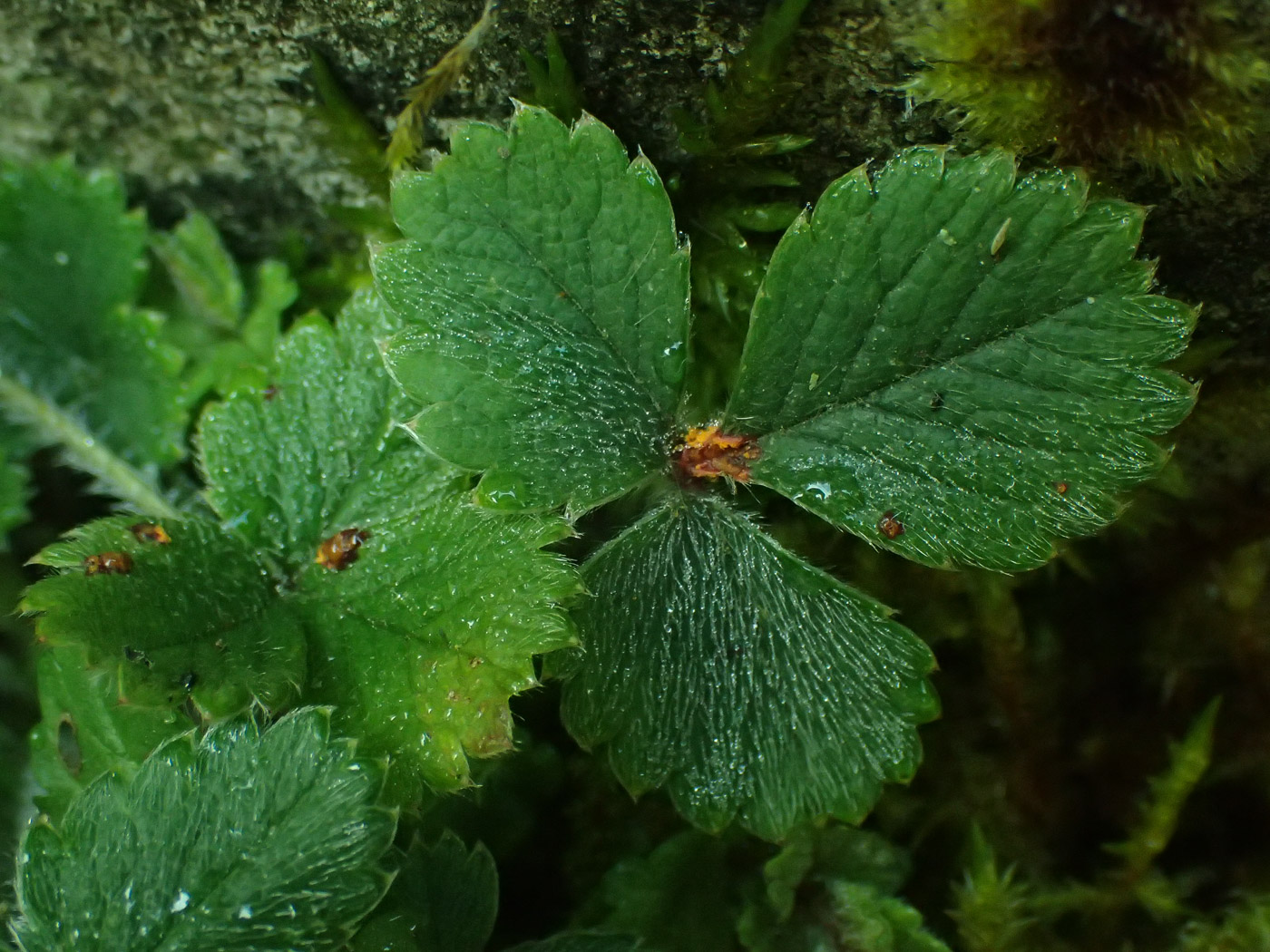

|
March 25th Phragmidium fragariae (a Rust species on Barren Strawberry) In Lacey Green Churchyard Sarah Ebdon noticed the distinctive leaves of Strawberry and on closer inspection she noticed the telltale orange 'dust' of a rust fungus forming on the leaves and petioles. (This is the time of year for such fungi.) To get to the name of this rust it is necessary to be able to recognise the difference between Fragaria vesca (Wild or Alpine Strawberry) and Potentilla sterilis (Barren Strawberry) which at first glance look vitrually identical! However once one realises that it only occurs on the Potentilla (despite its Latin species name suggesting otherwise!) you're pretty well home and dried. This is not a rarity though we have only one other known county site, however Sarah tells me that there is also a much rarer rust on this host so she intends investigate further just to confirm the later stages of development continue to match P. fragariae. Previous finds |
March 22nd 2025
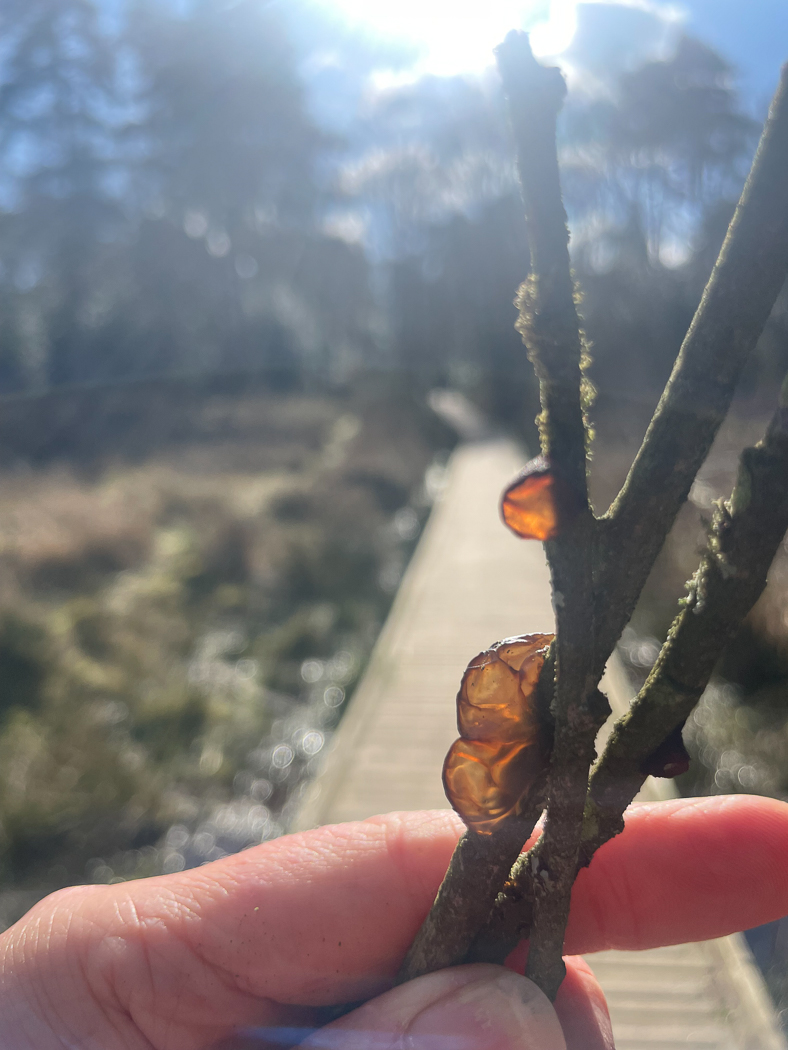
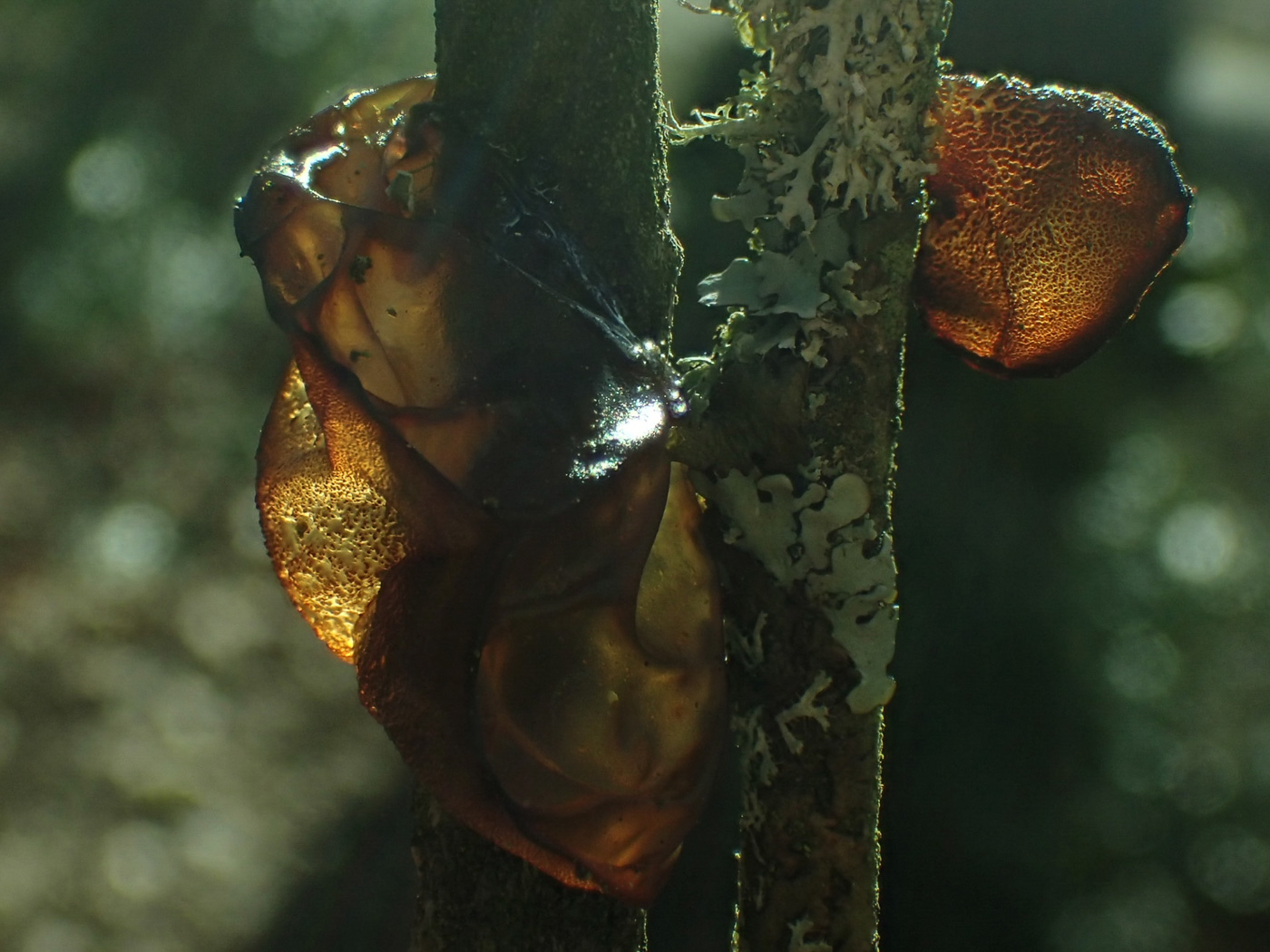
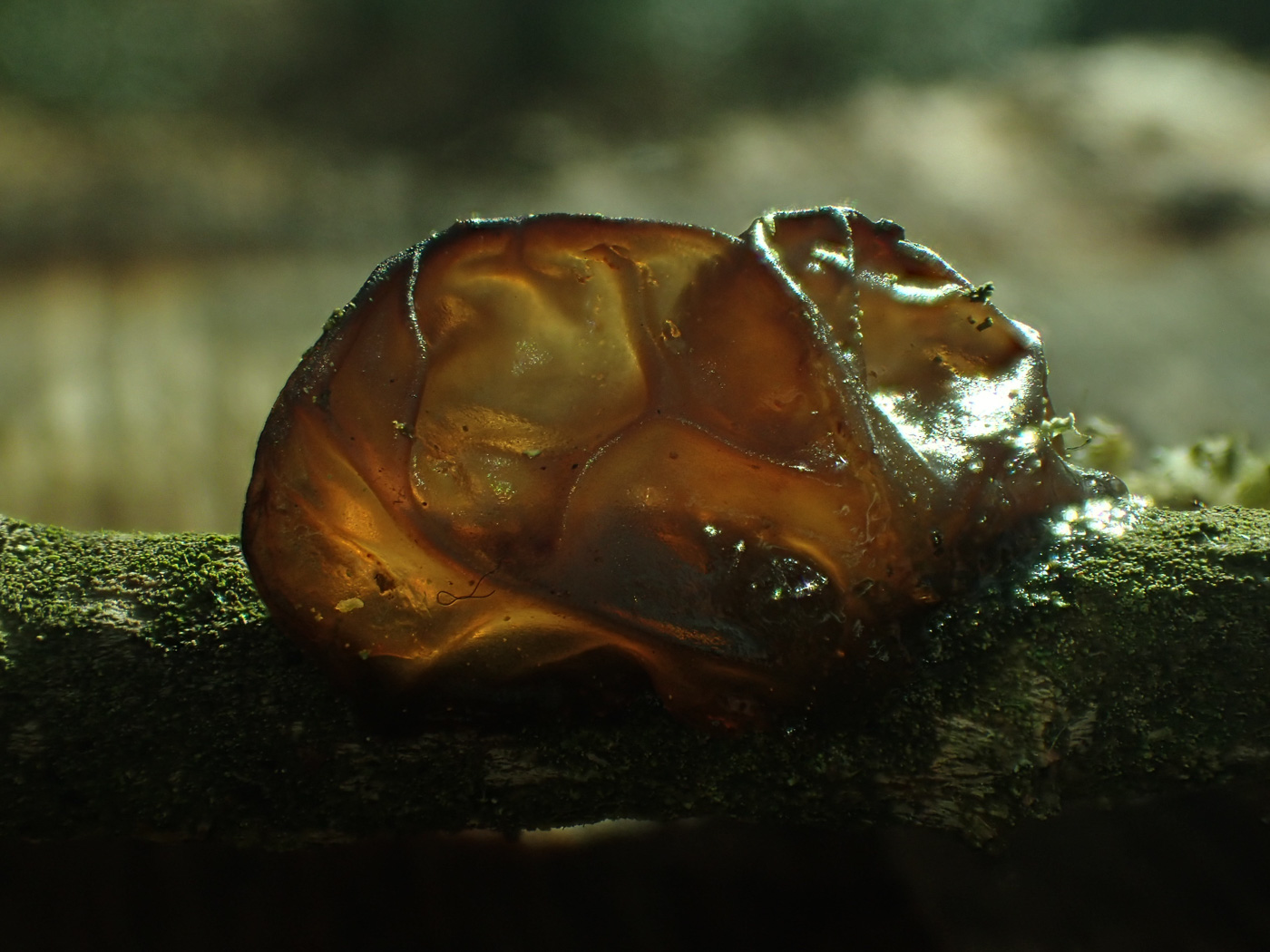
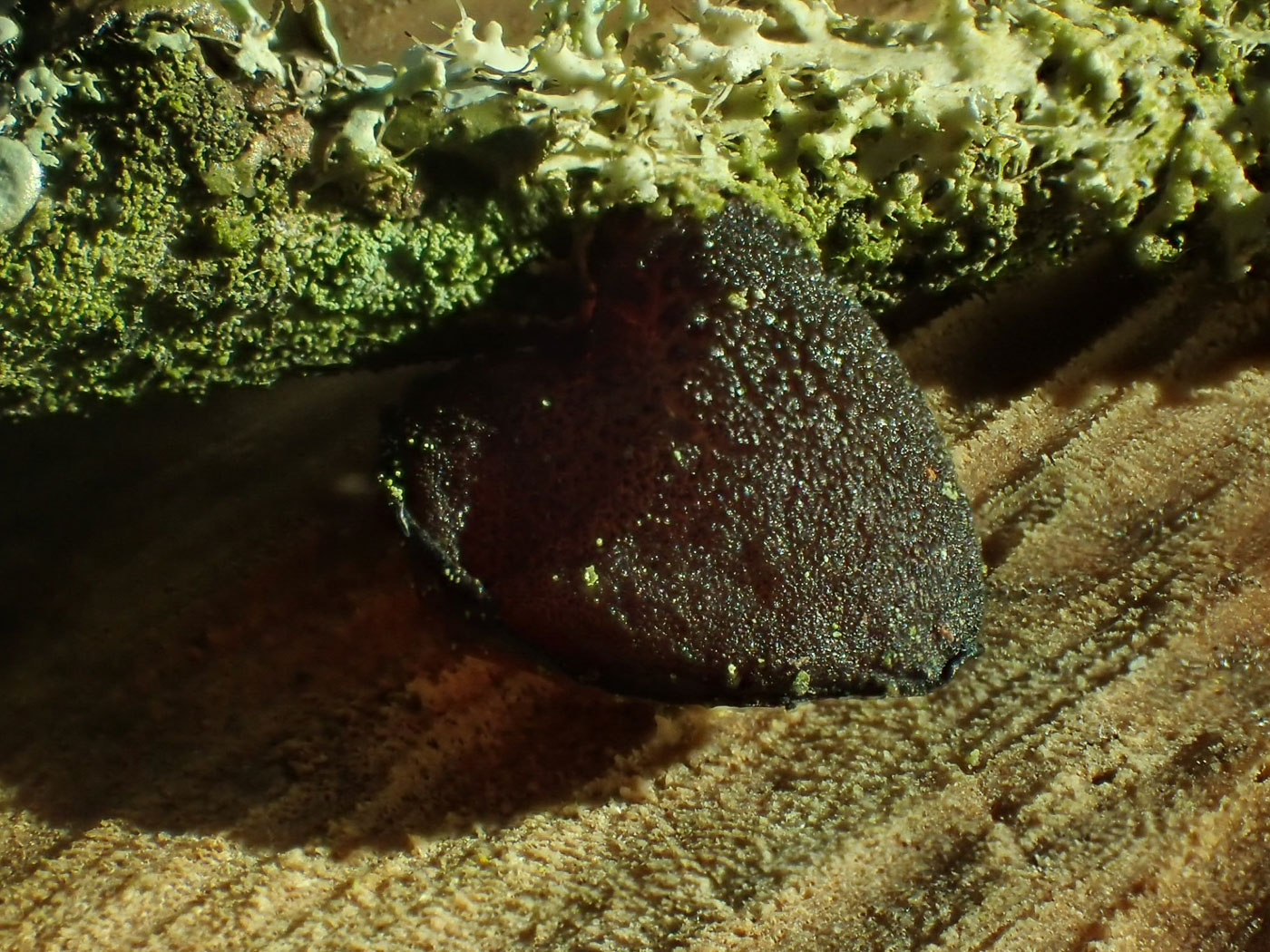
|
February 27th Exidia recisa (Amber Jelly) In Burnham Beeches Sarah Ebdon caught sight of this translucent jelly with the light behind it when on the boardwalk in the mire. It was on an attached Willow branch and from its unusual colour and the host wood (with which it is host specific) she suspected it was this quite unusual species - certainly much less common than the blackish members of this genus we find regularly on Oak. Checking at home later (though the material was then well past its best) the features she could find fitted fine, confirming her first thoughts. Note the bumpy underside surface - a characteristic of several Exidia species though E. recisa is alone in having amber coloured fruit bodies. We have just four previous county records, one notably also from the Beeches in 2000 found and identified by Kew Exidia expert Peter Roberts when on the BMS organised foray here as part of their successful project to collect 2000 species for the Kew Fungarium that year. Sarah is in good company! This is a new entry for Finds. New entry |
March 1st 2025
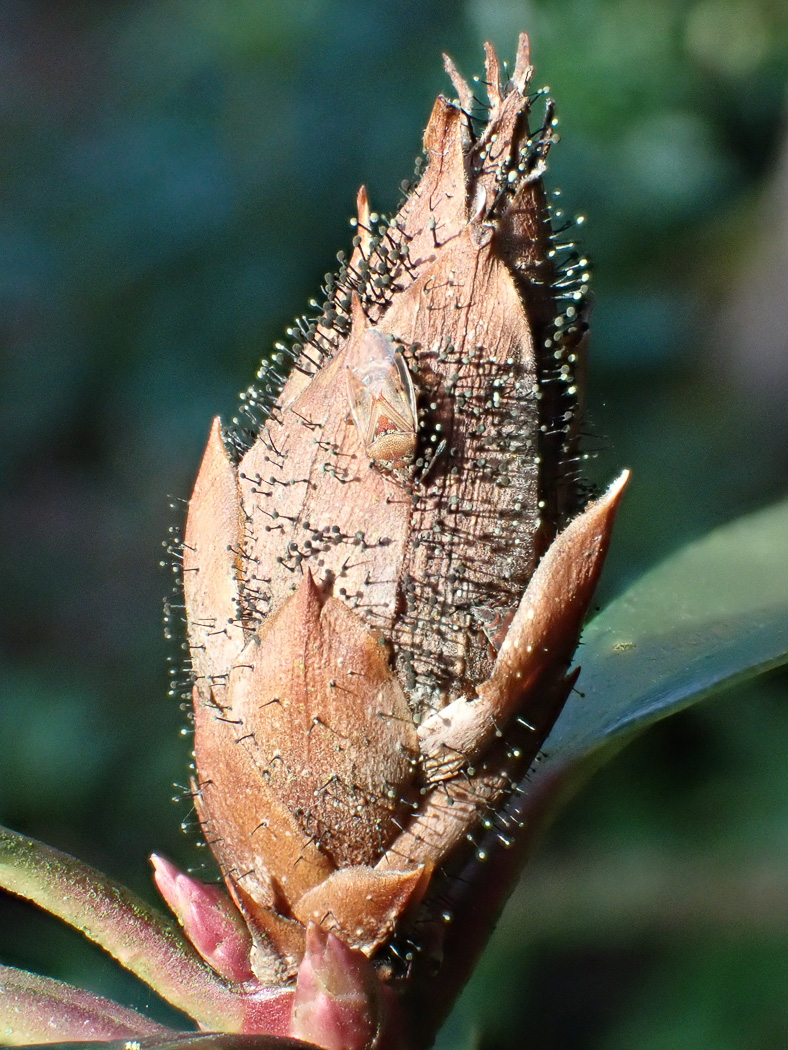

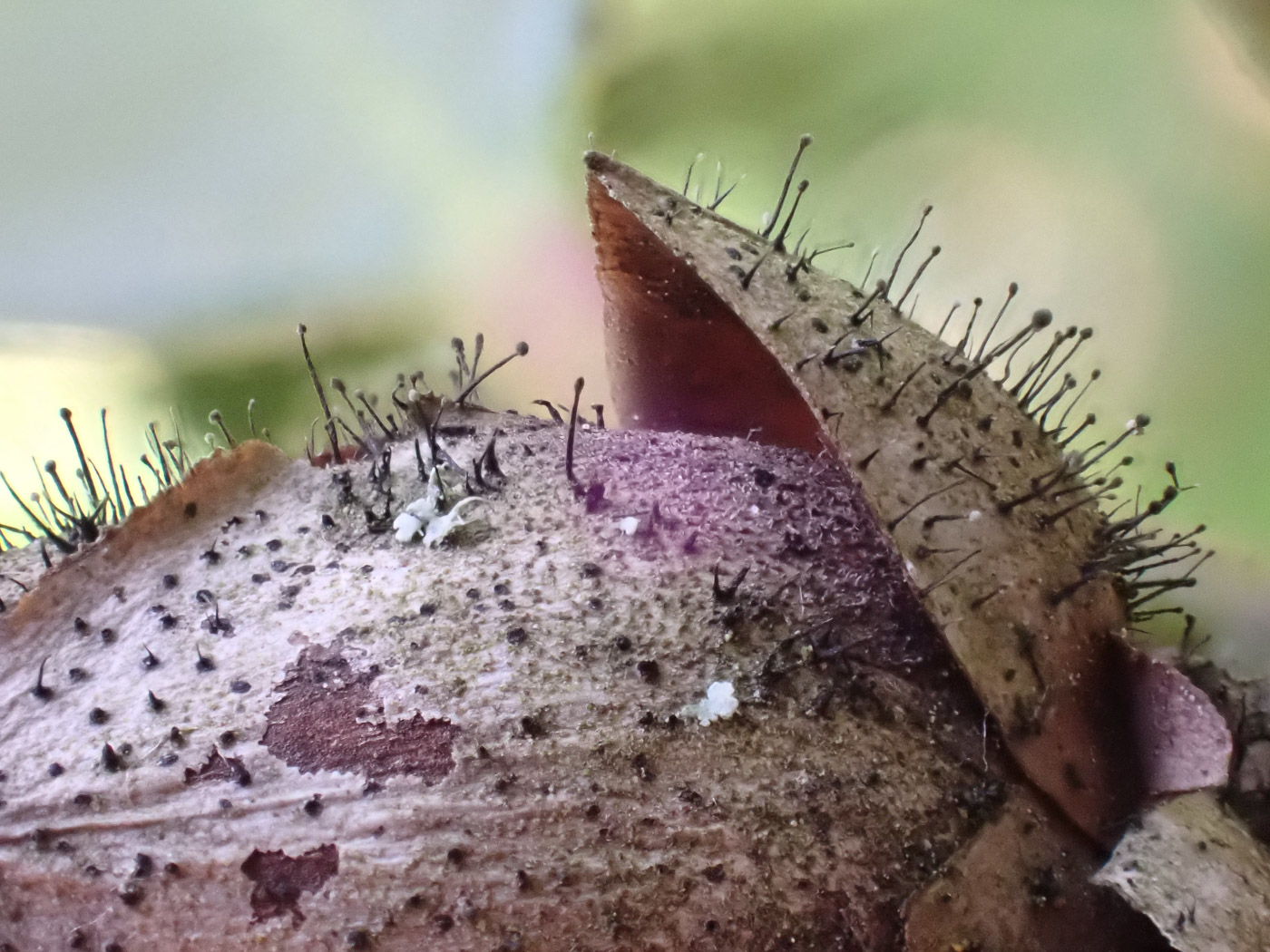 |
March 1st Seifertia azaleae (Bud Blast/ Rhododendron Blight) In Rushmere Country Park Stephen Plummer found good examples of this common plant pathogen which affects the buds of both Rhododendron and Azalea at this time of year and prevents them from developing further. Previous finds |
February 21st 2025
 |
February 21st Basidioradulum radula (Toothed Crust) On a fallen Prunus branch at Stampwell Farm Jackie Ewan found this toothed resupinate corticioid which however is very similar to Radulomyces molaris (Oak Toothed Crust) and from Jackie's photo Penny was not confident to confirm which of the two species we have here. The latter tends to occur high up on attached deciduous branches - not necessarily Oak despite the name - but after strong winds it can often be found on the ground. However, when Jackie learnt of Penny's doubts she then checked the spores which luckily differ in shape between these two similar species and was able to confirm her initial ID! Previous finds |
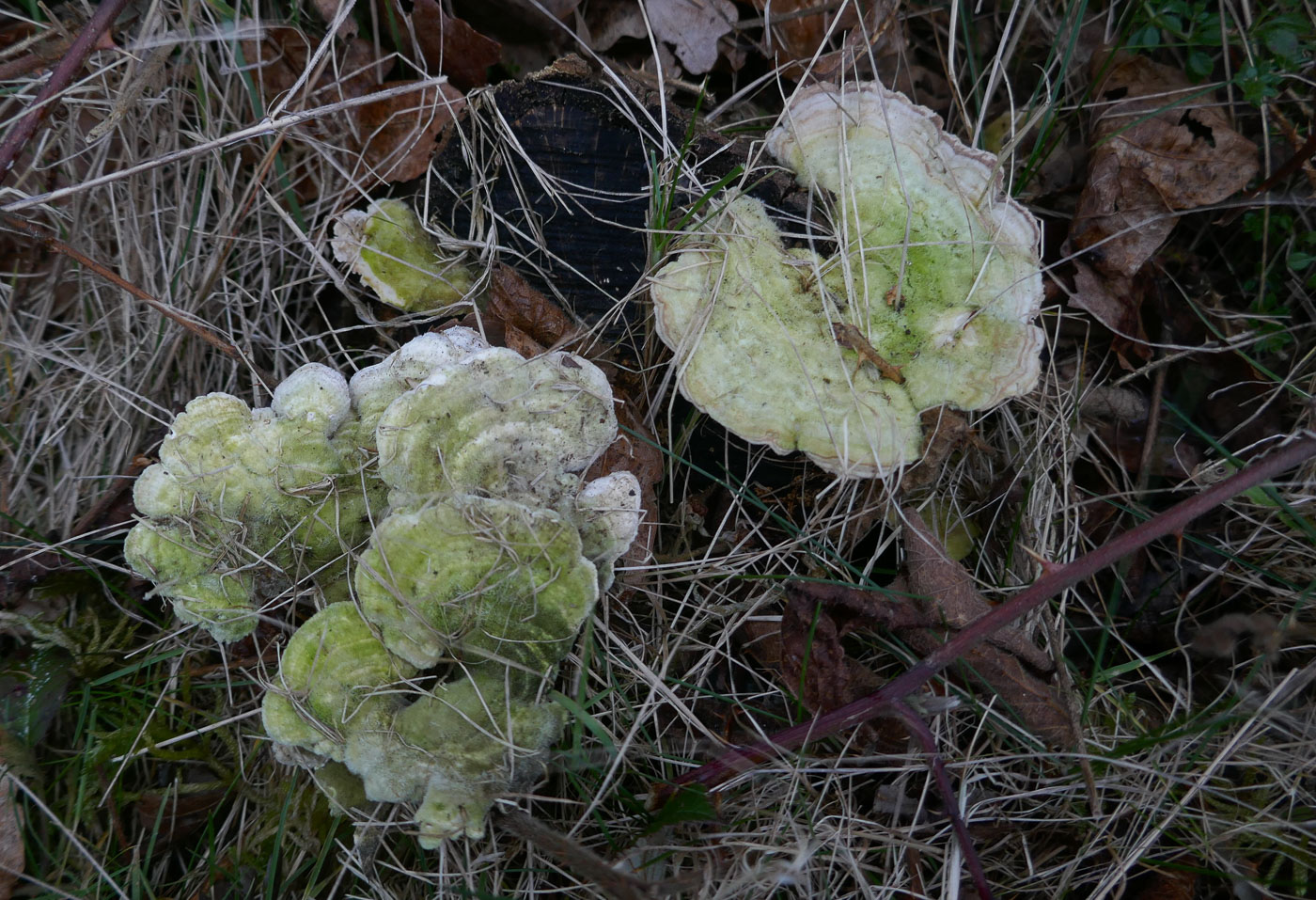
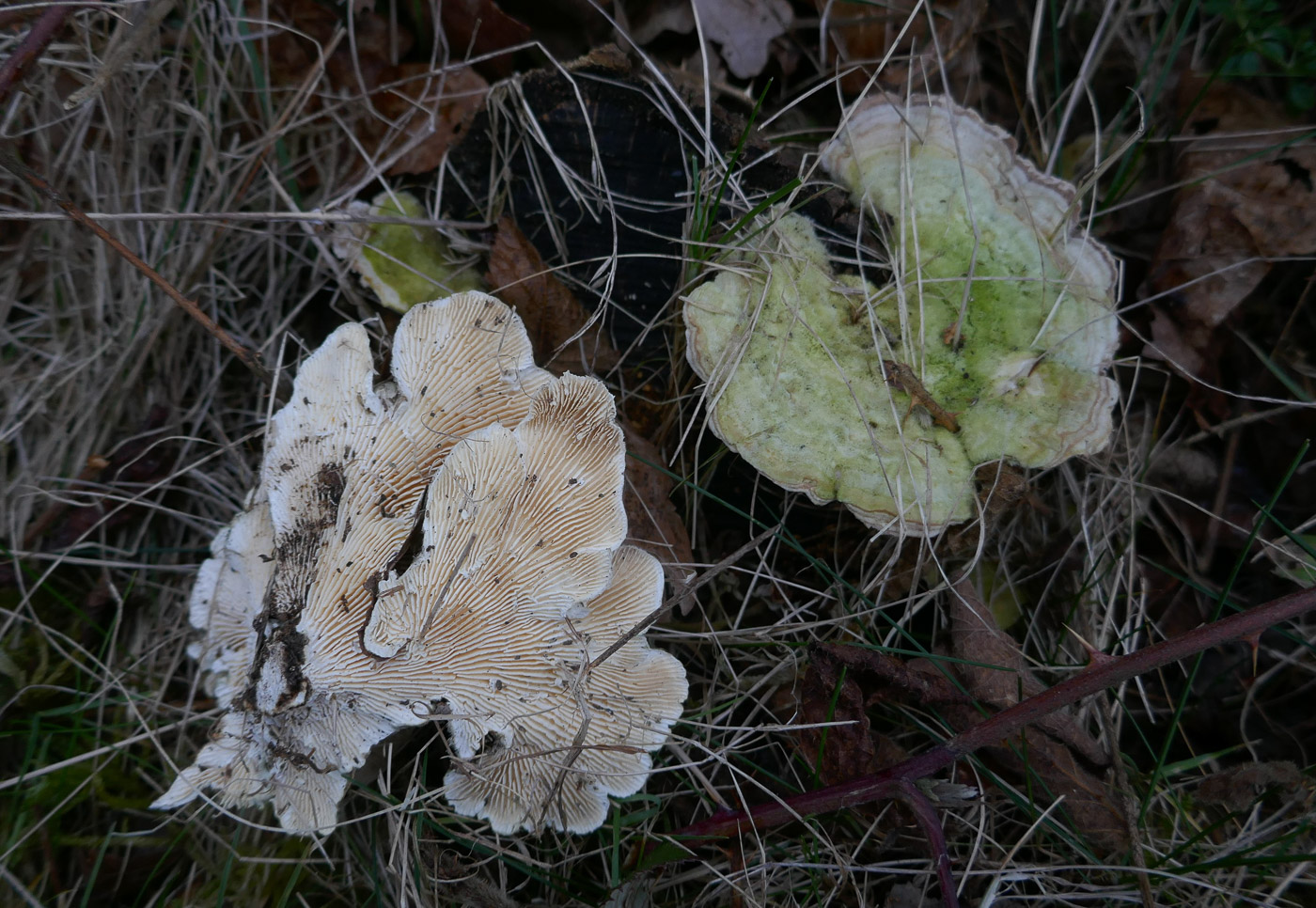 |
February 21st Lenzites betulinus (Birch Mazegill) At Stampwell Farm Jackie Ewan spotted this cluster of brackets which had become detached from a sawn off deciduous log but still produced spores later for her to check the ID. The species occurs on other deciduous fallen woods though is commonest on Birch as its name suggests. Other brackets can look similar with typical zoning and even with a coating of algae above as here, but the almost gill-like underside in place of obvious pores separates it though Trametes gibbosa also shares this feature but the English name of that species, Lumpy Bracket, describes its upper surface well and it tends to be large and much tougher and harder than today's species. Previous finds |
February 18th 2025
February 16th 2025
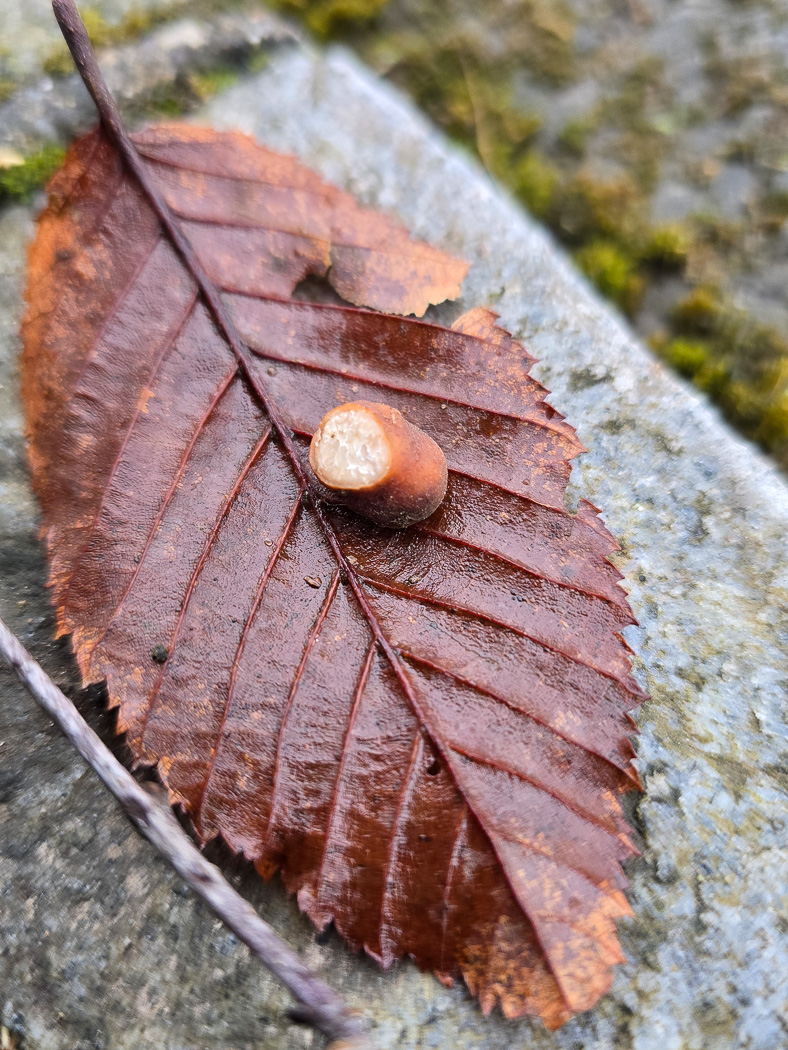
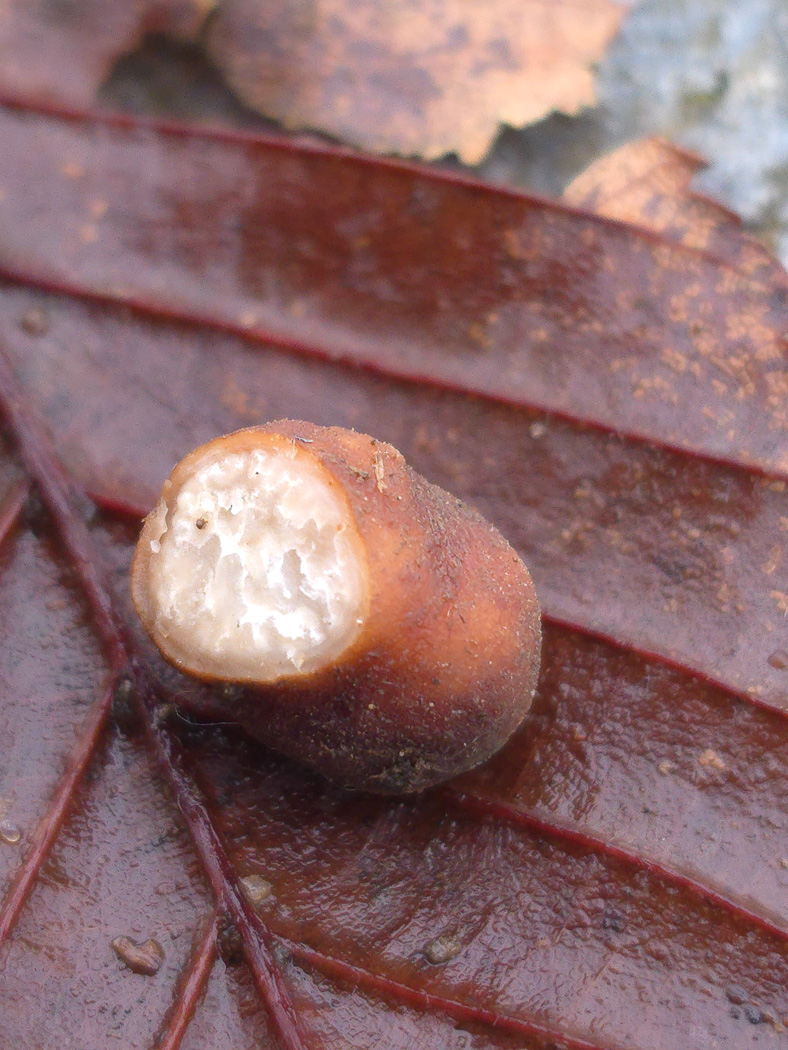 |
February 13th Tuber rufum (an ascomycete truffle with no English name ) In Chalfont St.Giles Jesper Launder found this small truffle just submerged in soil under Hornbeam. He reports that although early in the year to find this species, it was already developing a smoky aroma and the 'marbling' effect within was well defined. This appears to be just our fourth county record though it is probably not particularly rare, it's just that not many people go looking for truffles, nor have Jesper's knowledge and experience. He is almost singlehandedly responsible for our growing list of truffle records over the last few years. Previous finds |
 |
February 12th Encoelia furfuracea (Spring Hazelcup) In Jordans Village on dead but attached Hazel Jesper Launder spotted this somewhat inconspicuous ascomycete which however is not rare wherever Hazel is present. One needs to know to look out for it on this host in Spring otherwise it is very easily missed. Previous finds |
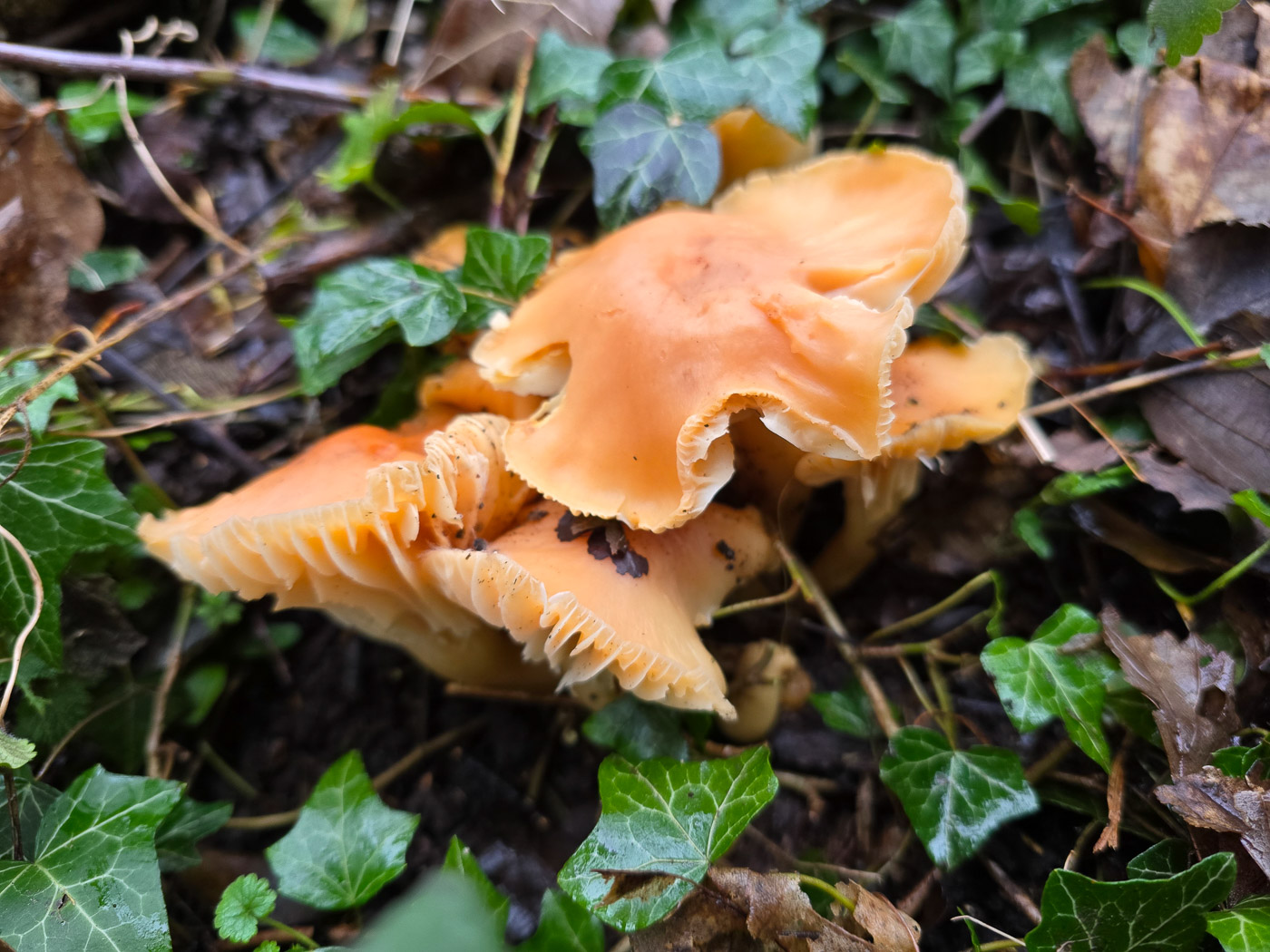 |
February 12th Cuphophyllus pratensis (Meadow Waxcap) Here we have a common Waxcap but it is surely unusual to see it fruiting in February! It was spotted by Jesper Launder in Jordans Village where lurking under some Ivy, which was presumably offering some protection, and adjacent to a meadow where the species fruits regularly in autumn. Previous finds |
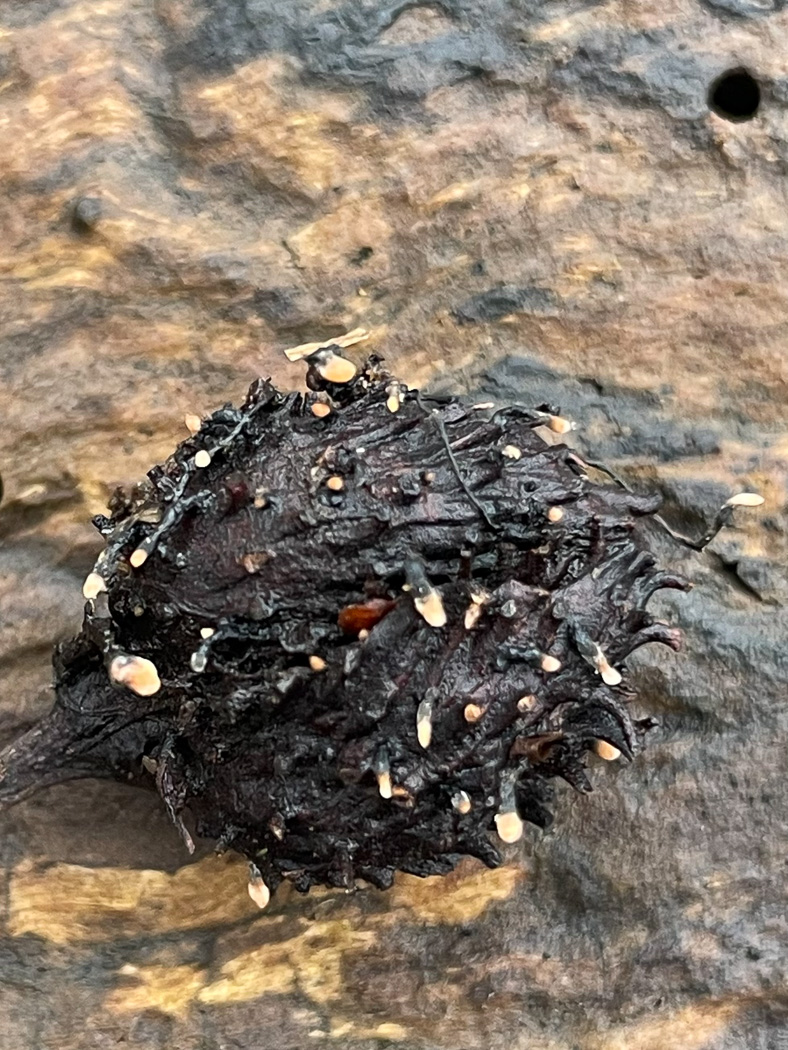
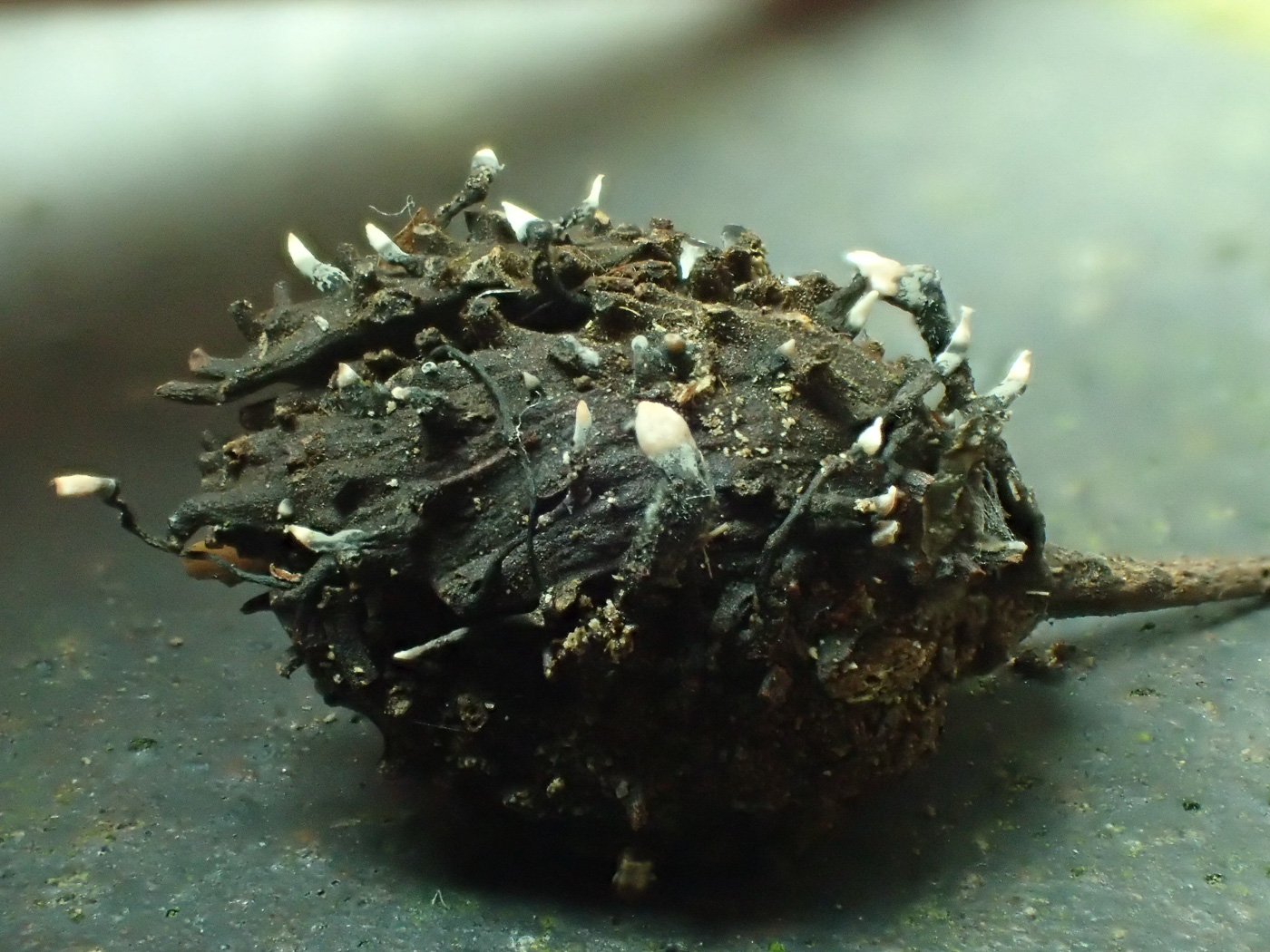
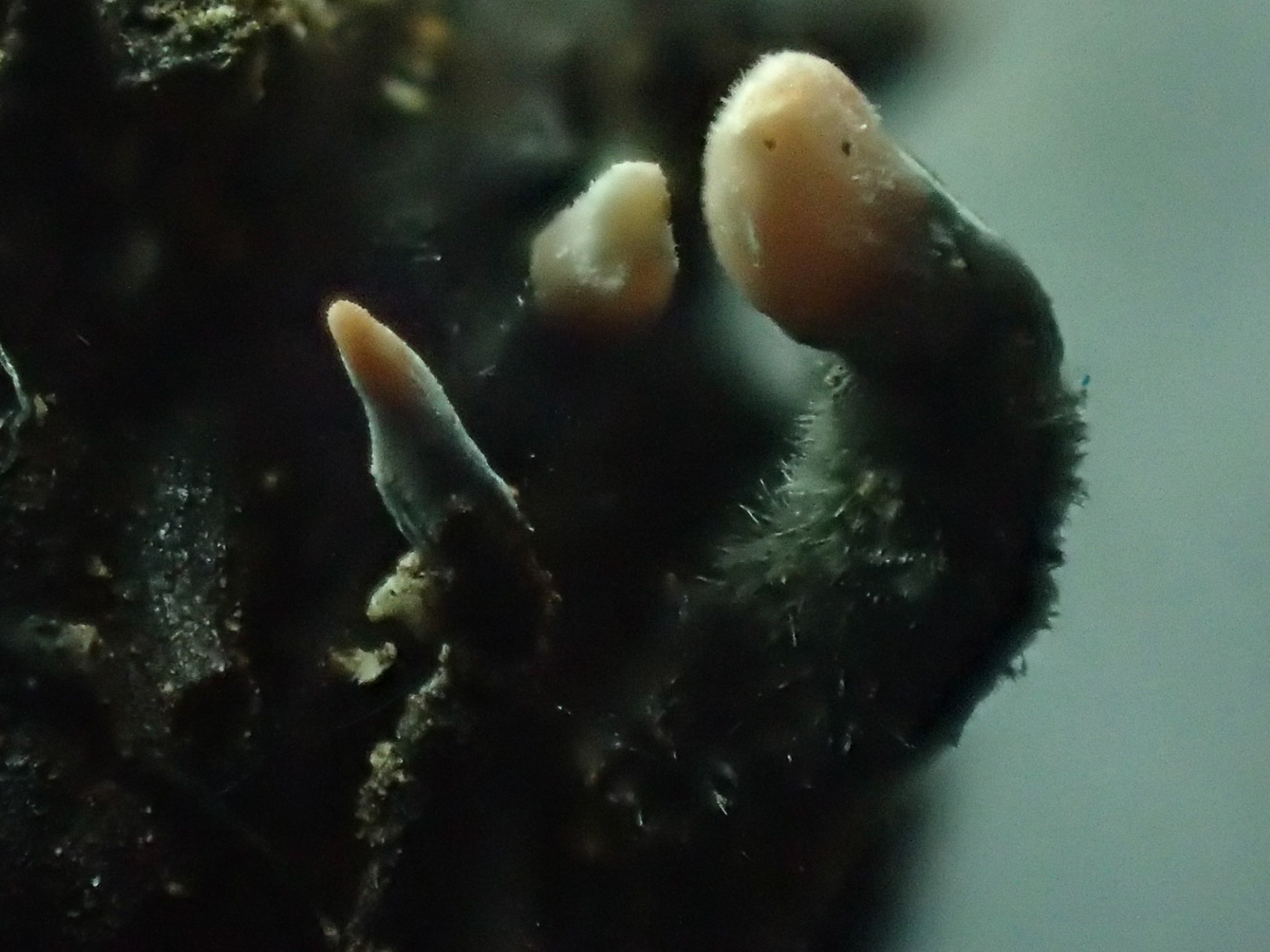 |
February 9th Xylaria carpophila (Beechmast Candlesnuff) On farmland near Saunderton Sarah Ebdon found this delightful material of a springtime smaller version of our common Xylaria hypoxylon (Candlesnuff). As the name suggests it grows only on Beechmast and is therefore common in our area where Beech predominates.To find it you need to dig about in thick litter under Beech, looking for the telltale pink tips on the top of thin black strands, when young and fresh quite finely hairy as can be seen from Sarah's photos. Previous finds |
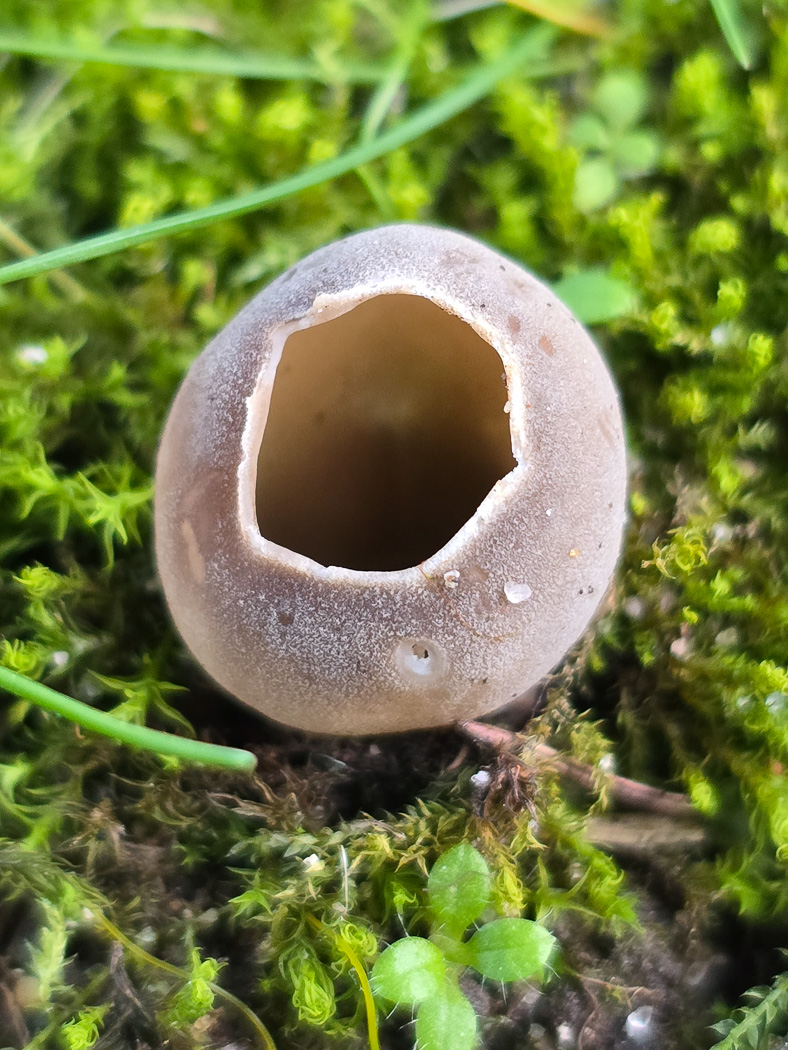 |
February 2nd Dissingia (previously Helvella) leucomelaena (Sooty Cup) Today's find makes the third consecutive year that Jesper Launder has found this rare ascomycete under the same Pine in Gerrards Cross - twice now in February and once in April. In appearance very similar to the genus Peziza, the species has been in various different genera and is not covered in any available hand books, but appears to be a spring fruiting cup found under conifer and tends to develop greyish black colours internally with a paler outer surface and a whitish stem. The American name for this species is 'White-footed Elfcup'.This is the third county record. Previous finds |
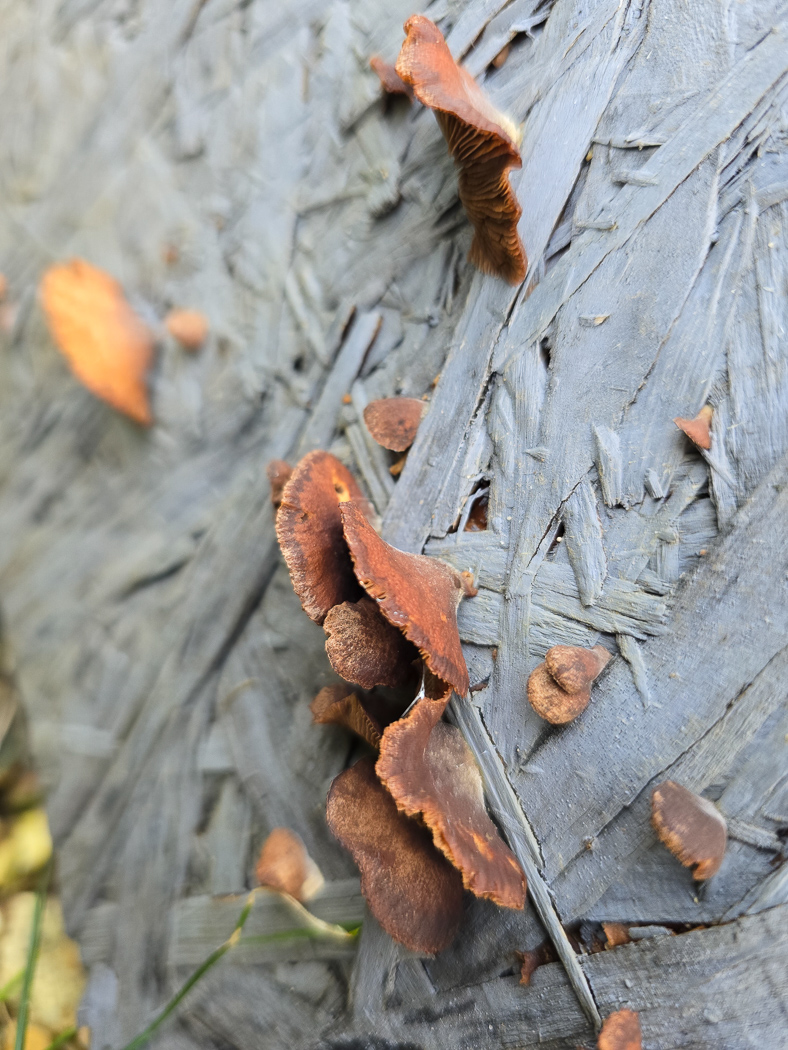
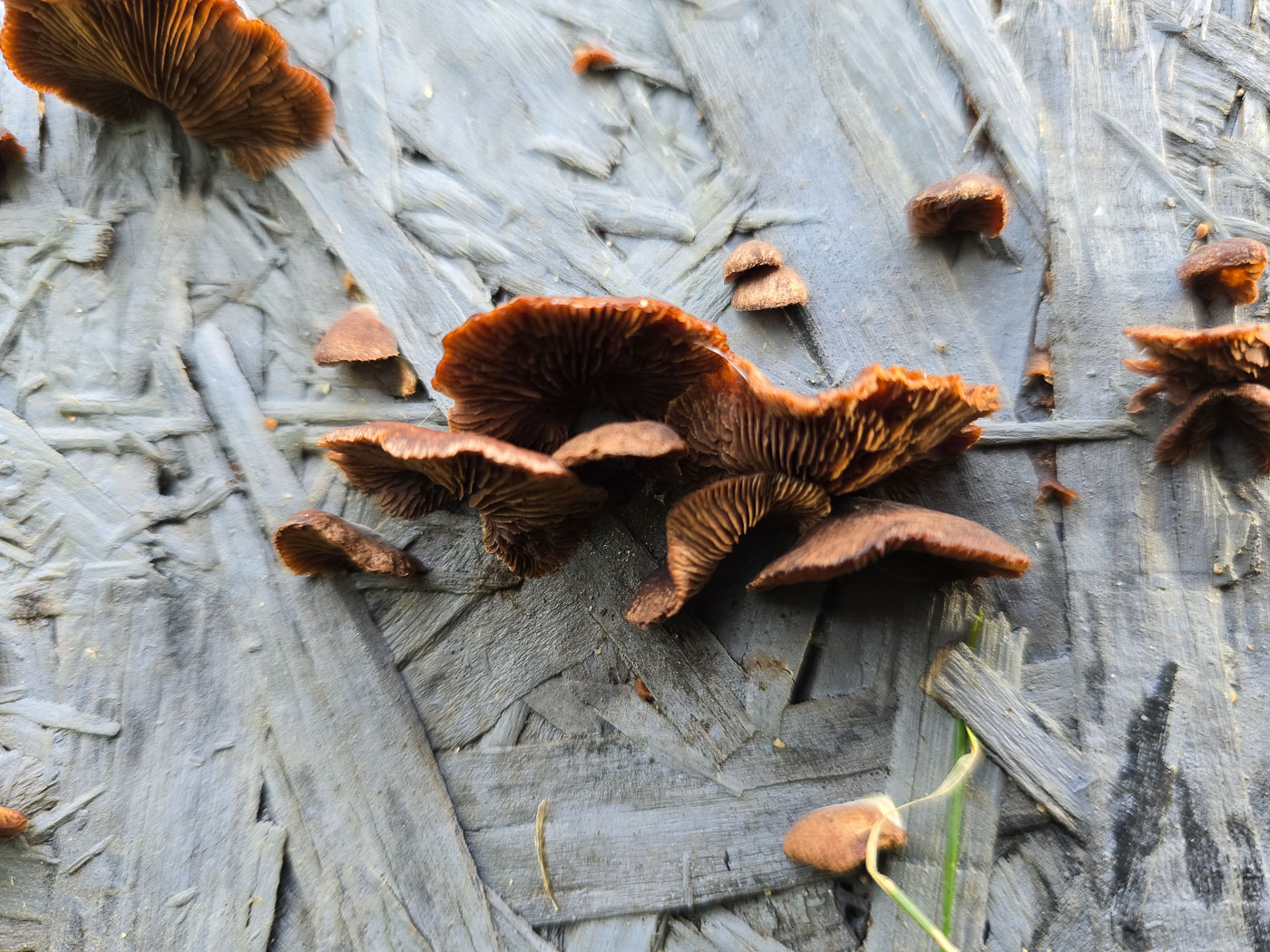 |
January 30th Deconica horizontalis (Wood Oysterling) In Gerrards Cross Jesper Launder noticed this fungus on a somewhat surprising substrate: painted chipboard! Not unlike Panellus stipticus, ie brown and similar in shape and size to some species of Crepidotus, it is often found on unusual woody substrates of all sorts, also old rope, even old carpet. It lacks the sticky gill surface of P. stipticus which should help to separate the two in the field though D. phillipsii is also similar but has a more distinct eccentric stem. We have plenty of county records but this is a new entry for Finds. New entry |
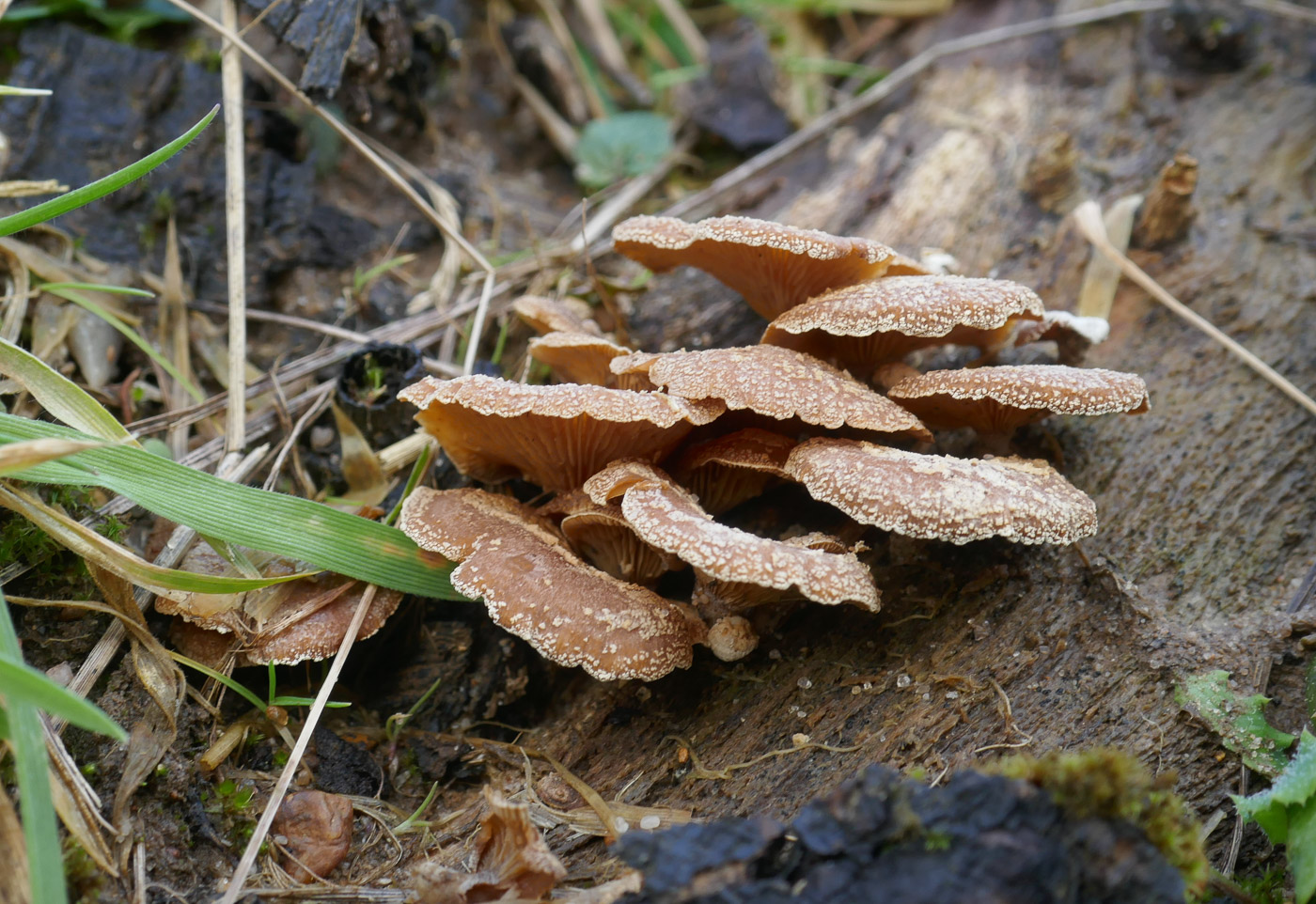
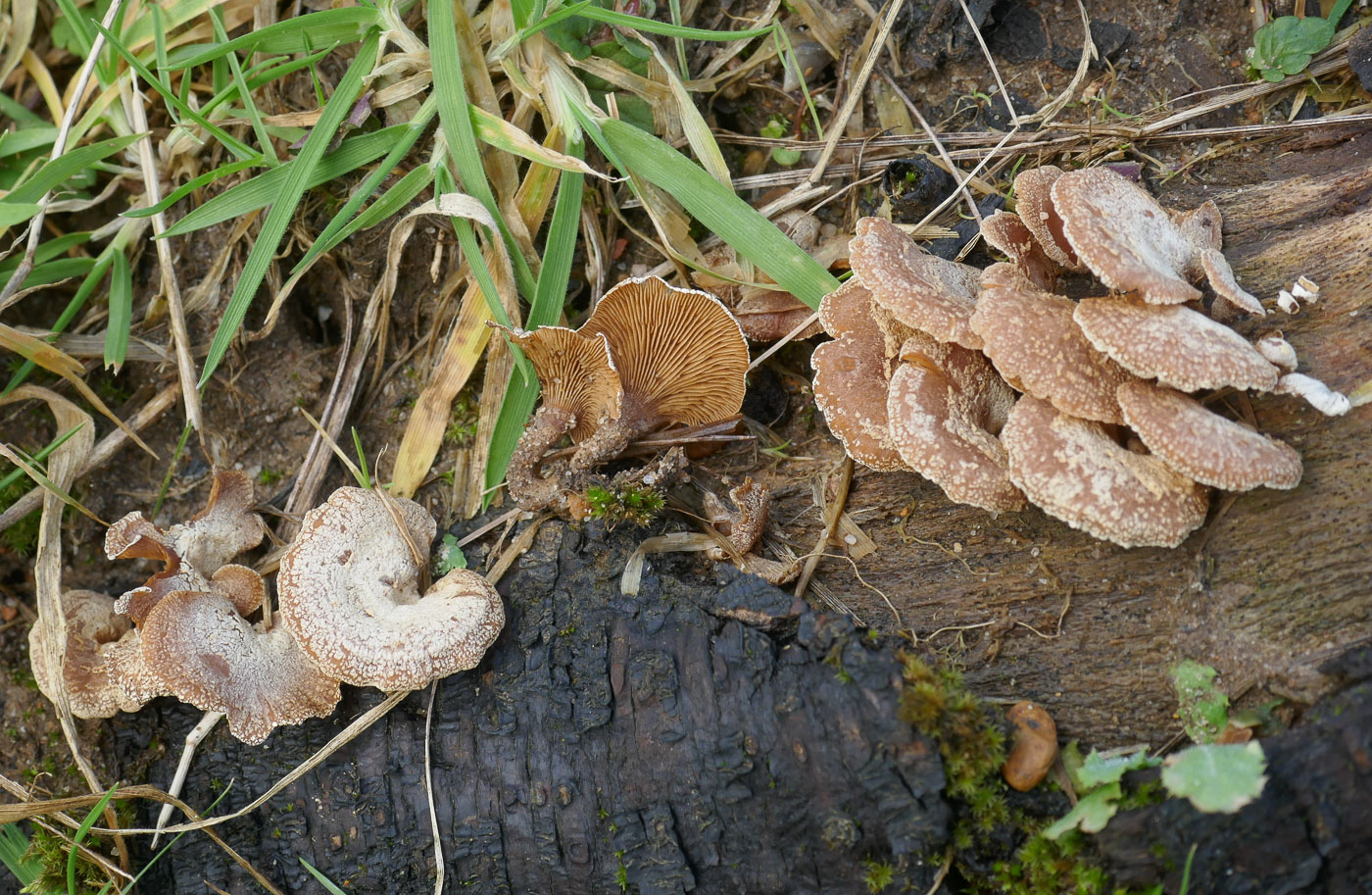 |
January 24th Panellus stipticus (Bitter Oysterling) At Stampwell Farm Jackie Ewan noticed this cluster of stemless mushrooms on a fallen Plum tree. She did the 'sticky gill' test (ie pinching a fruit body with thumb and finger, then putting that thumb and finger together afterwards which reveals a sticky substance left by the gill surface and makes them adhere slightly) and this was enough to confirm the ID. This seems to be a unique feature and useful in the field to eliminate maybe a species of Crepidotus, Pleurotus or even Deconica. It is common on sawn ends of wood piles but also often on dead or dying deciduous wood, though nice to find in January. Previous finds |
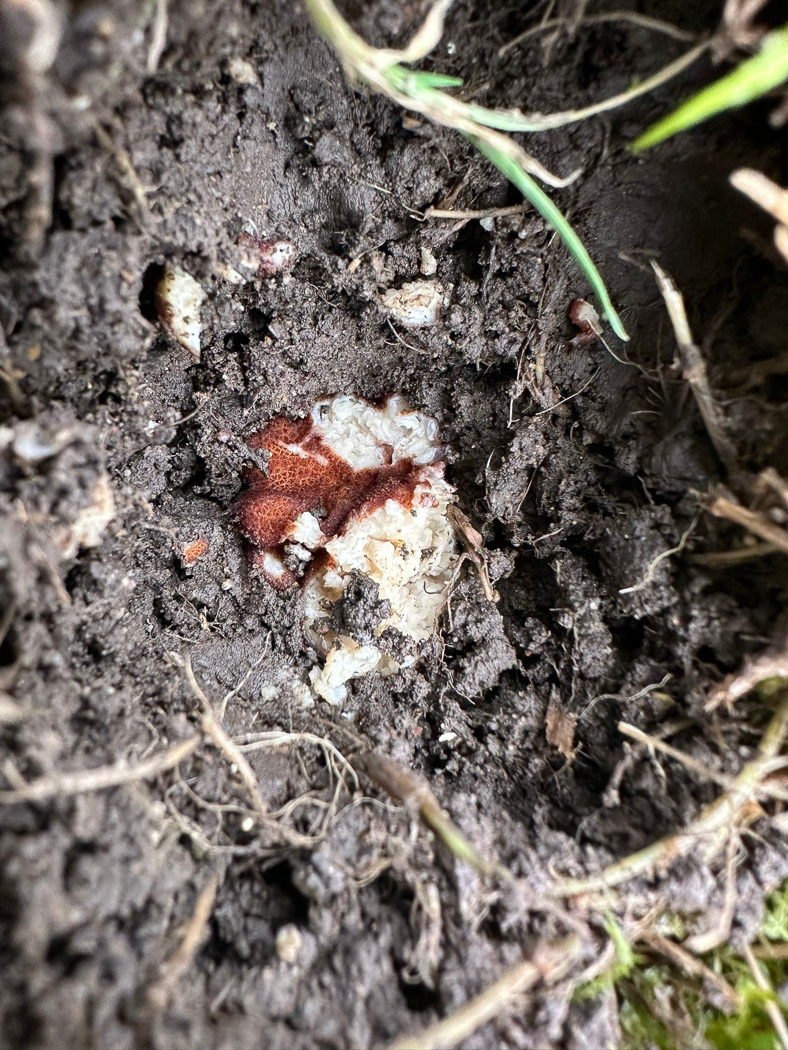
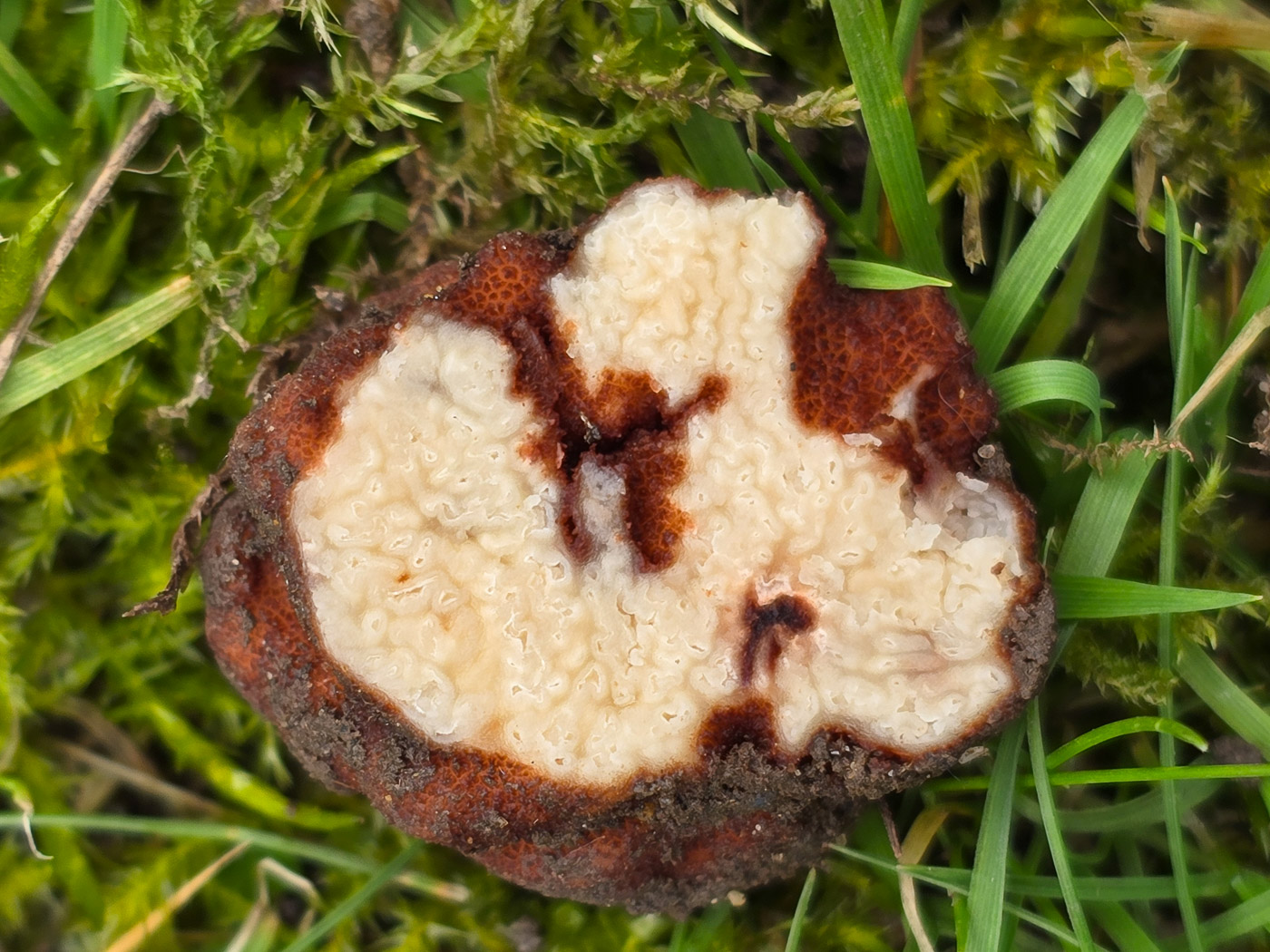 |
January 17th Balsamia vulgaris (a rare ascomycete truffle with no English name) In Gerrards Cross Jesper Launder found this knobbly whopper (his description!) partially showing through the soil surface under a deciduous tree, also partially eaten by a squirrel (detected from its toothmarks!). He was surprised by its size (more than 3 cm across) which was not fully revealed until excavated, and was the largest and also the smelliest he'd encountered (described by him as 'truffly and pleasant'). This is his second find of this species from Gerrards Cross where the number of truffle records - entirely down to him - is growing rapidly, and is the second county record. Previous finds |
January 22nd 2025

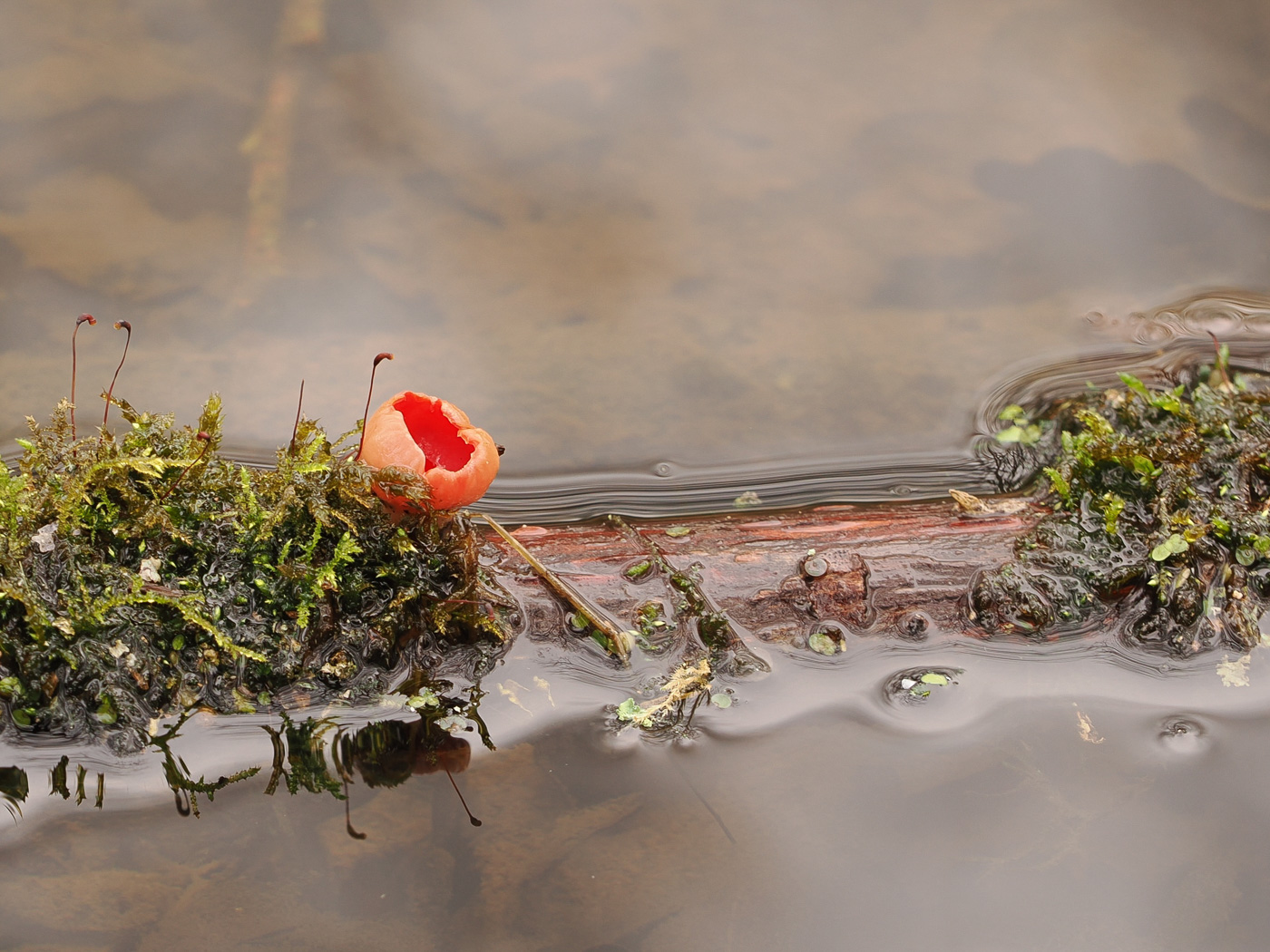 |
January 22nd Sarcoscypha austriaca (Scarlet Elfcup) Whilst walking in Lott Wood near Stokenchurch, Jackie Newcombe noticed this bright red fruit body on a mossy bank and on closer inspection noticed its smooth red interior, pale downy exterior with only a very short stem, the cup being no more than 15mm across. It was growing on woody litter in a suitably damp spot though the wood was indeterminate but the area is mainly Beech and Ash with some Willow present - the likeliest host. She was concerned as to which of the two species of Sarcoscypha this might be, and without a scope it is not possible to be certain but S. coccinea is now considered so much rarer than the common S. austriaca which appears to be more or less replacing it in the UK that one can fairly safely make the assumption that this is the commoner species - one well worth looking out for now in damp areas where fallen wood is in contact with the soil. Photo 2, taken by Claire Williams in Naphill Common on Feb 16th, is unusual because the stick on which it's fruiting is floating in a pond! This was explained, however, by the stick being one of several thrown onto the ice when the pond was frozen! Previous finds |
January 8th 2025
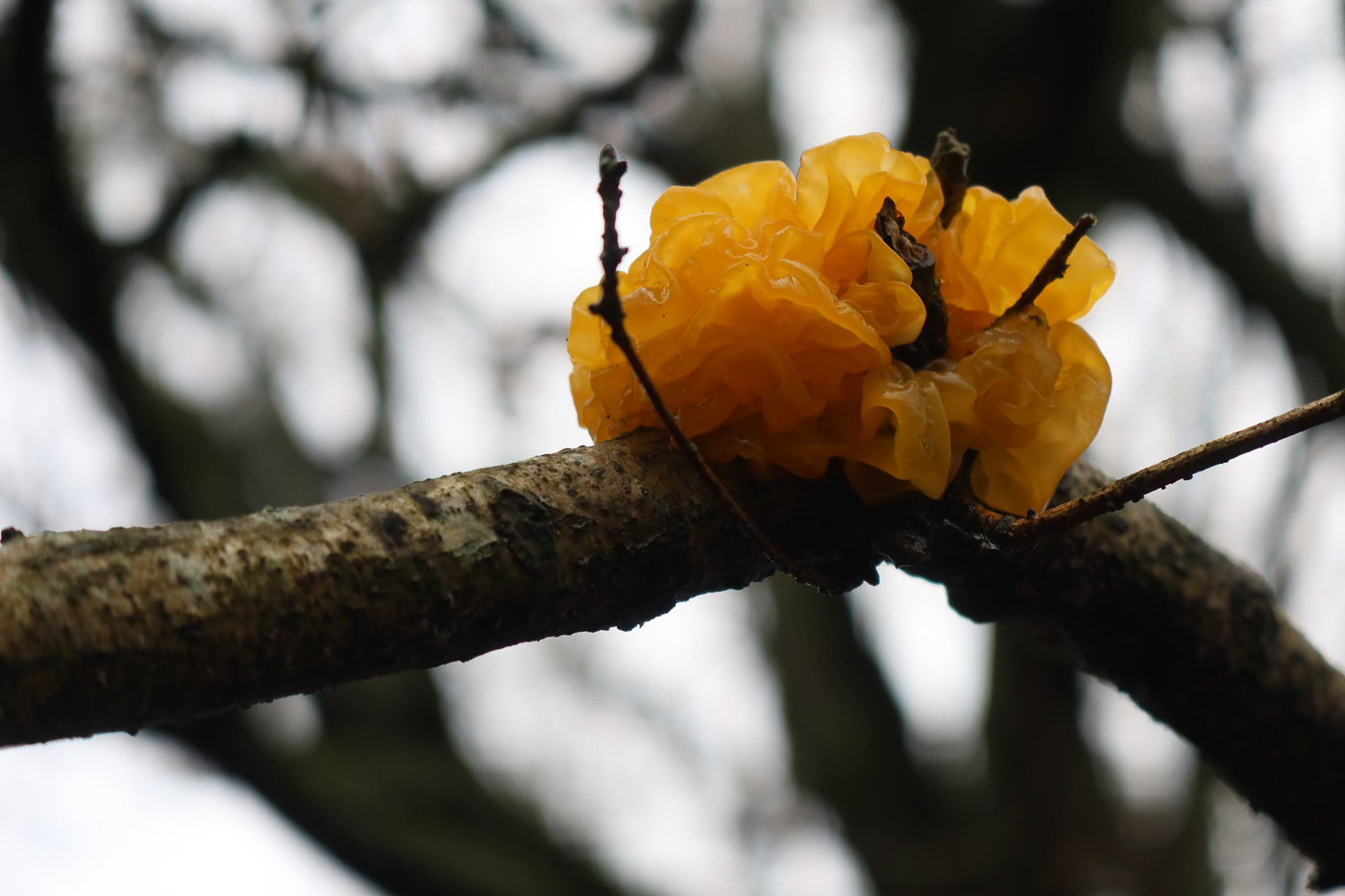 |
January 7th Tremella mesenterica (Yellow Brain) In Downley Wood Claire Williams was pleased to spot this bright jewel on a lower branch of a large Oak. Her description: 'gorgeous golden' fits the bill nicely, especially at this time of the year when woodland tends to be somewhat drab and devoid of colour. This is one of the jelly fungi as touching it will soon confirm. It favours Oak but is also quite common on Gorse and tends to become more orange as it dries out. It parasitises species of the corticioid genus Peniophora though this host is often not visible underneath but no doubt its mycelium is hidden within the wood. Previous finds |
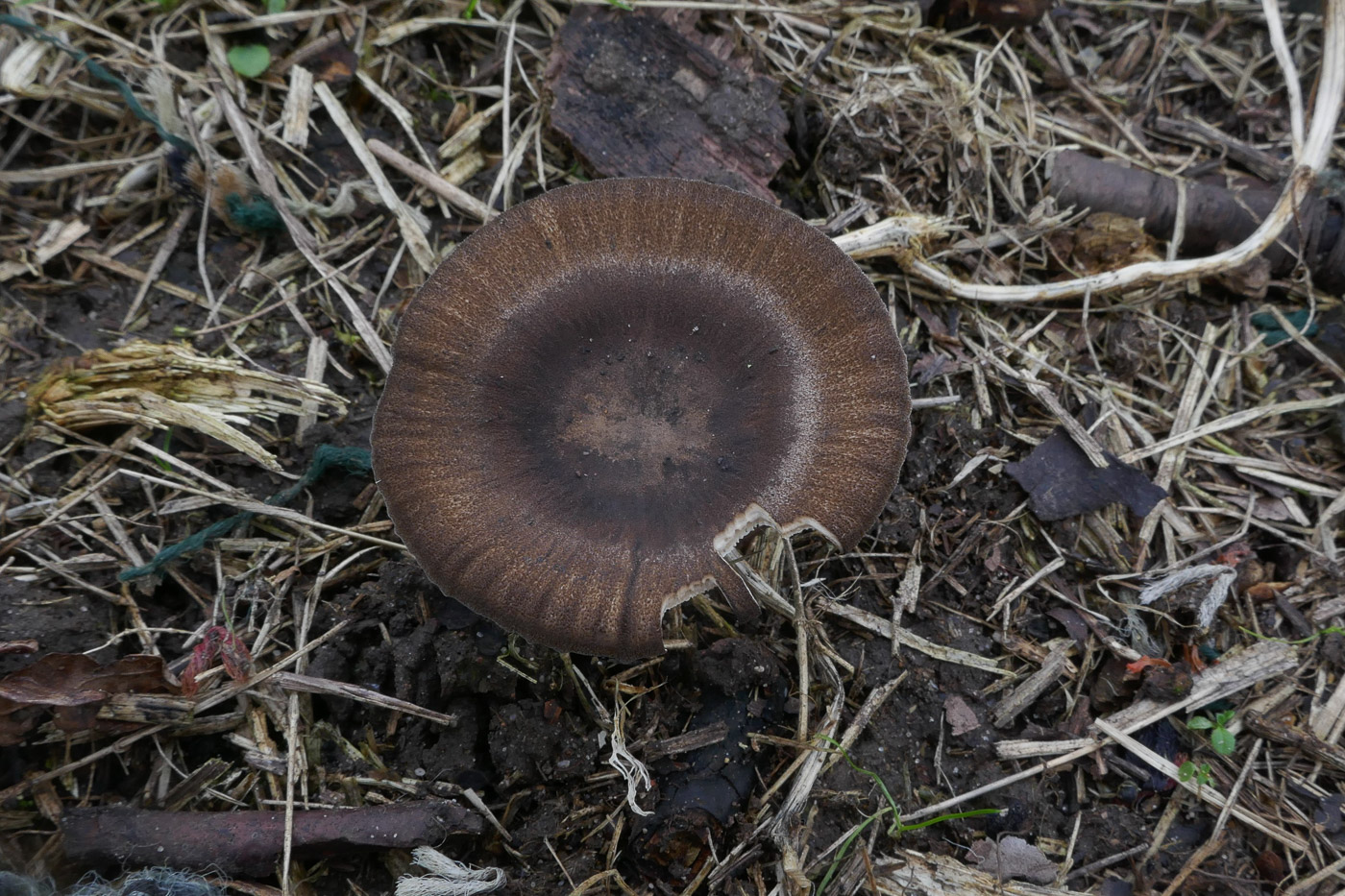
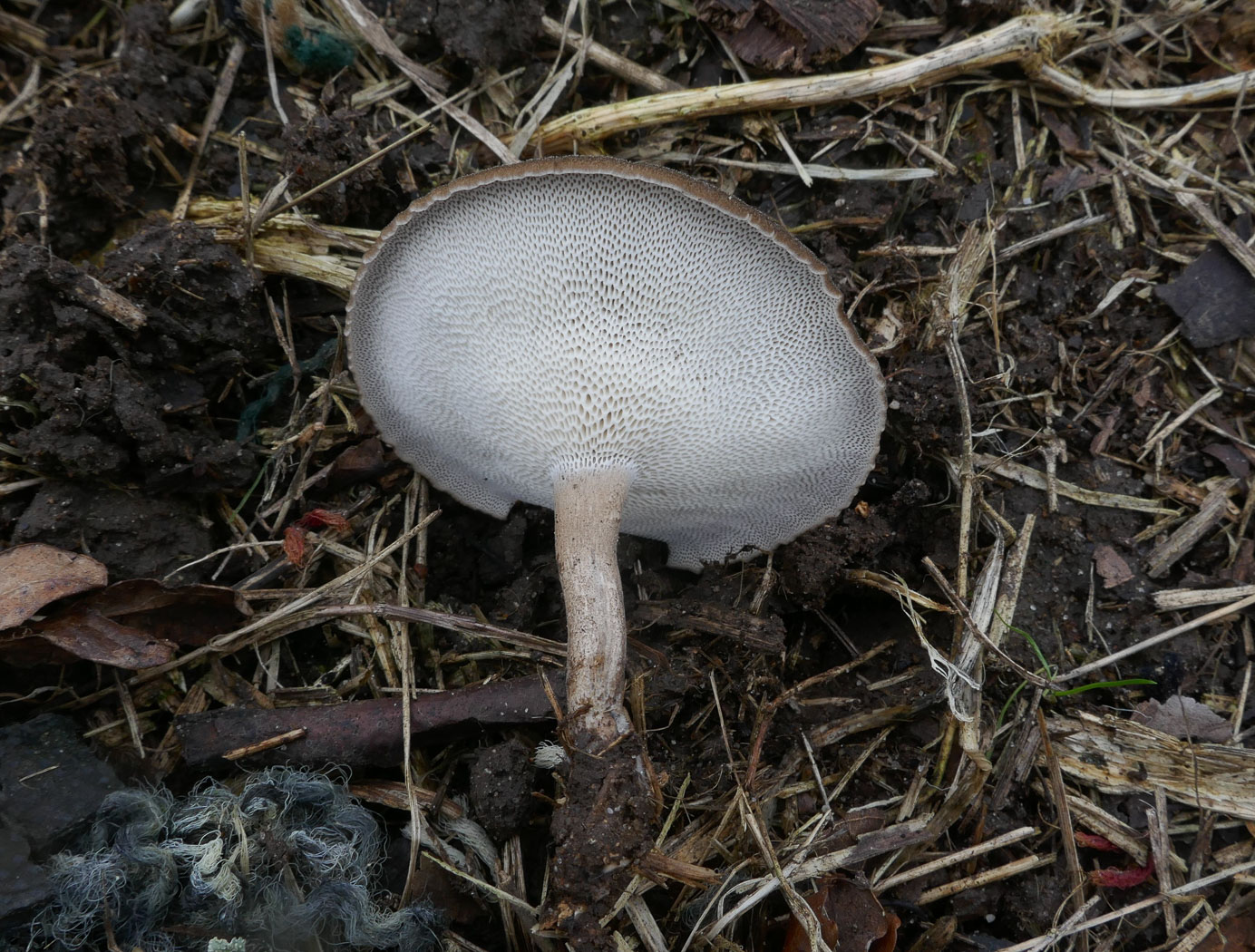
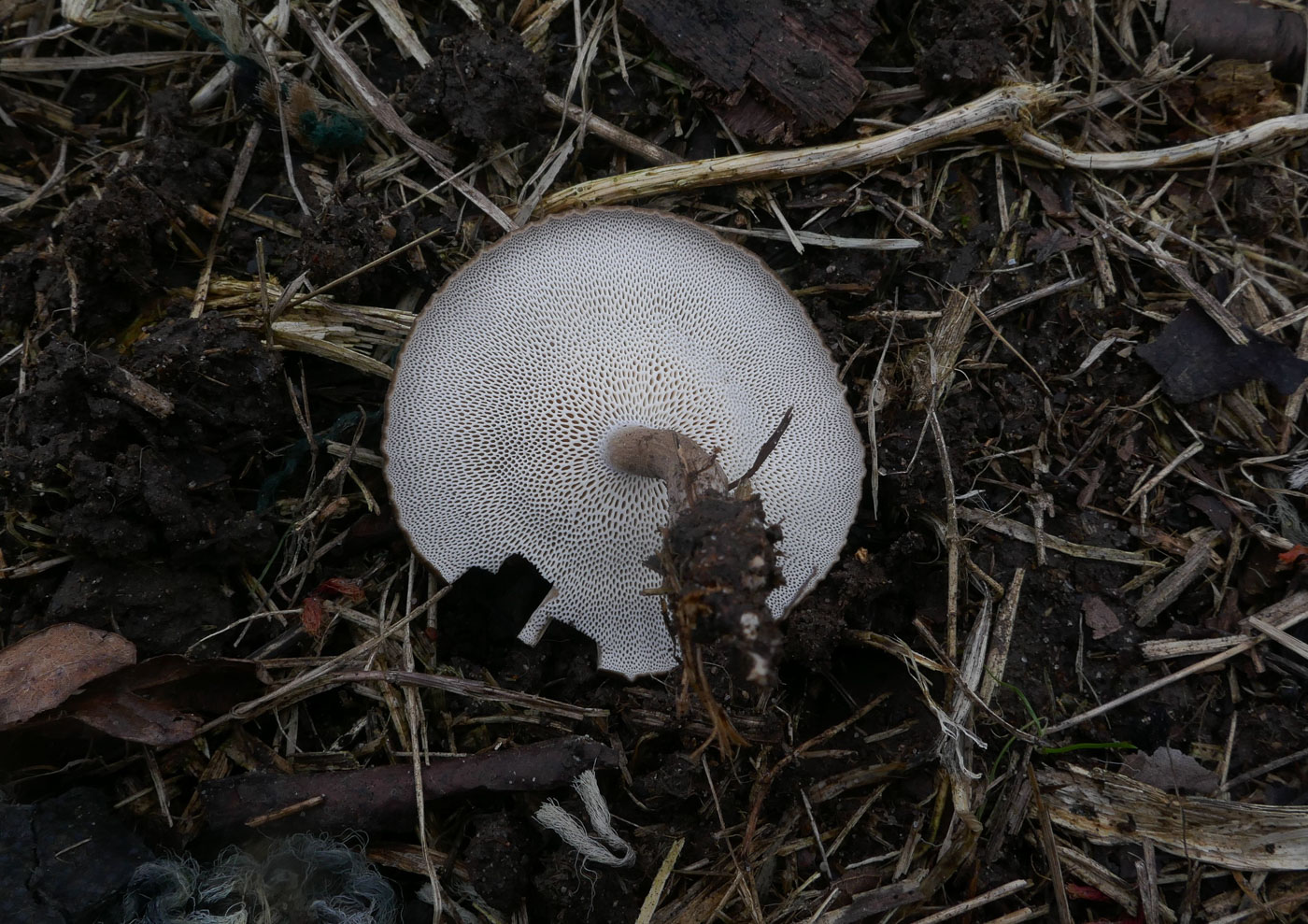 |
December 30th 2024 Lentinus brumalis (Winter Polypore) On woody debris in a plum orchard at Stampwell Farm Jackie Ewan spotted this singleton showing the typical characteristics of the species and at the correct time of year as well. The cap colour, regular shape with slightly fluted edge with distinct but white pores 2-3 per mm which are slightly decurrent all point to this species - previously in genus Polyporus. Previous finds |



 |
July 10th 2023 Hydropus inopinatus (a species NEW TO SCIENCE from Burnham Beeches - no English name) This tiny Mycenoid mushroom was first found in 2021 on a piece of Pine collected from Burnham Beeches by Barry Webb and, following sequencing, described for the first time in the magazine Field Mycology vol 24 (1) earlier this year. Its reappearance has been eagerly awaited in order that sufficient material could be collected for further study and drying, and on July 2nd Barry rediscovered it on the same rotting Pine stump from which his original piece of wood was taken (photo 1). Bingo!! It had also been found in Hampshire back in 2021 and in Kent in 2022, the sequence of both collections matching ours from Burnham Beeches. So a second article has since appeared (in 2024, Field Mycology vol 25 (3)) - the official publication of this species now with a name and full description. The name inopinatus meaning a surprise was thought to be particularly appropriate. All the photos here are Barry's, photo 2 taken on July 5th, photos 1 and 2 are of his original find on a piece of Burnham Beeches Pine on July 31st 2021. See the publication online for further information. Updated find |
January 2nd 2025
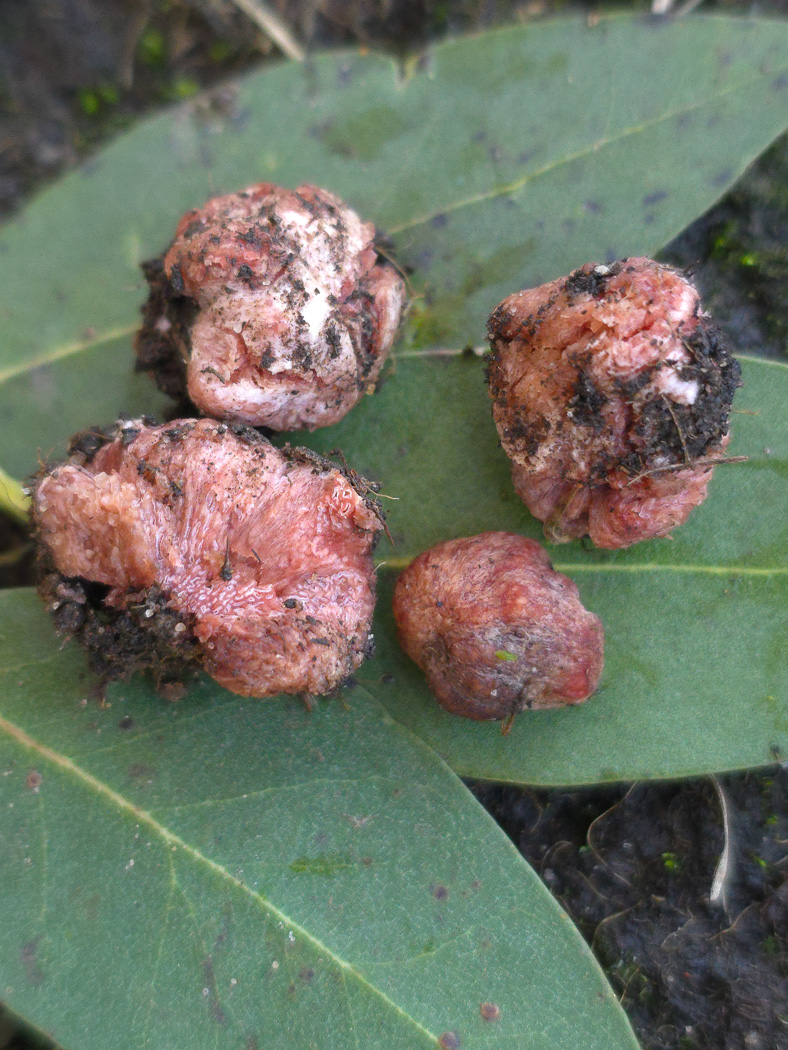 |
January 2nd Hydnangium carneum (Flesh Pink Truffle) In a roadside verge in Gerrards Cross Jesper Launder's attention was drawn to a Eucalyptus tree where he'd previous found interesting fungi, and on then discovering Laccaria fraterna (see entry below) he searched about for signs of truffle activity - ie dig holes, because he knew of a rare species which associates with this tree, one he'd been hoping to find for years. To his amazement and delight he spotted a single pinkish truffle protruding through the soil and on further investigation was rewarded with several more. At home a scope confirmed it was likely to be this species but he feels it is well worth getting a sample sequenced because he knows there are several other Hydnangium species found under this tree in Australia which are not yet known to be British. This is a new to the county with just 27 previous UK records. What an exciting find to start the new year off! New find |
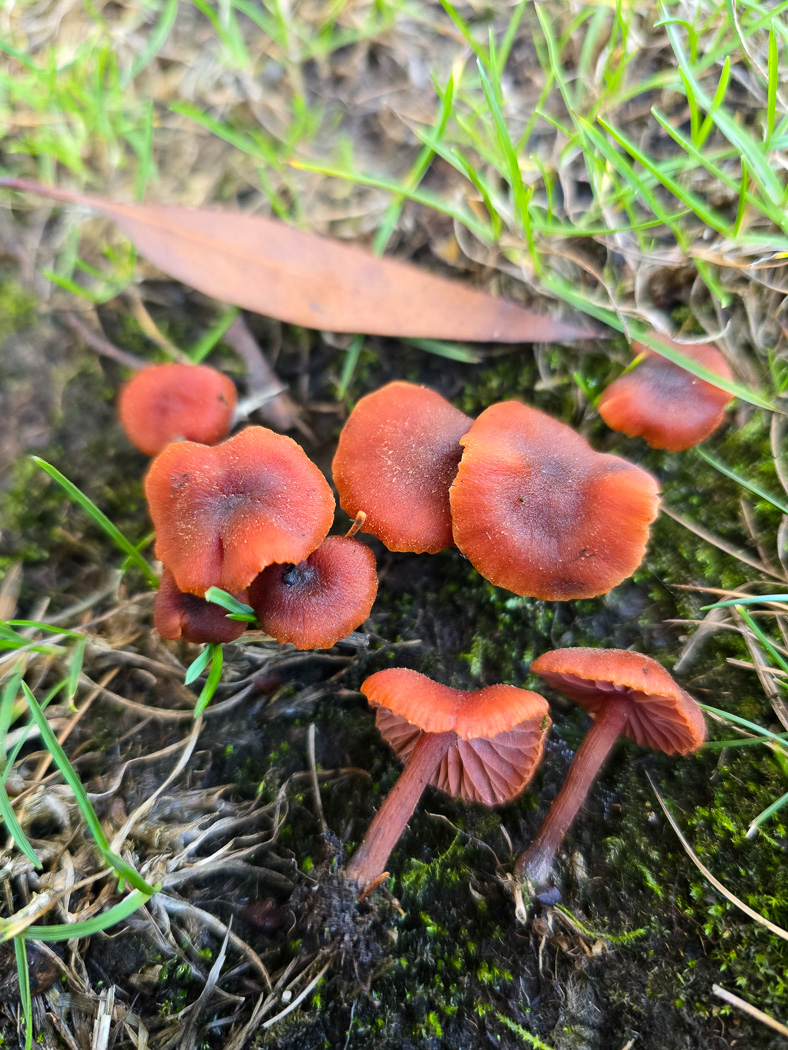 |
January 2nd Laccaria fraterna (Gumtree Deceiver) In a roadside verge in Gerrards Cross Jesper Launder's attention was drawn to a Eucalyptus tree where he'd previous found interesting fungi and today's species in particular. He was not disappointed! Here he found a group of Deceivers displaying the usual features of the genus, ie rusty brown smallish caps and widely spaced pinkish gills. As our common L. laccata can also occur under this tree it was necessary to check this wasn't just that species, and sure enough he found the telltale 2-spored basidia which are only found in this particular unusual Deceiver which is host specific to Eucalyptus. Our only other county record is Jesper's from this spot last year, but if you know of a Eucalyptus near you this is well worth looking out for. Previous finds |
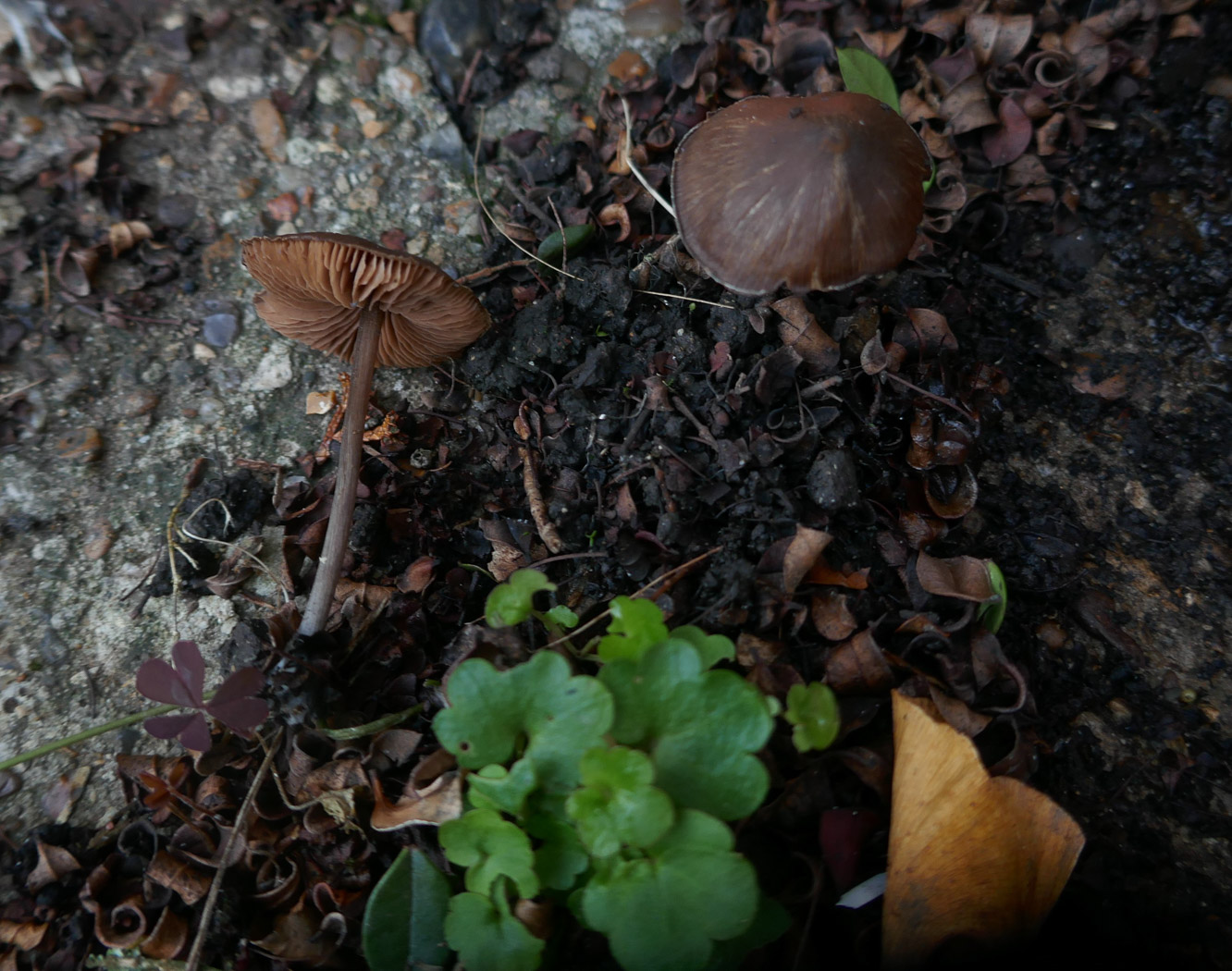
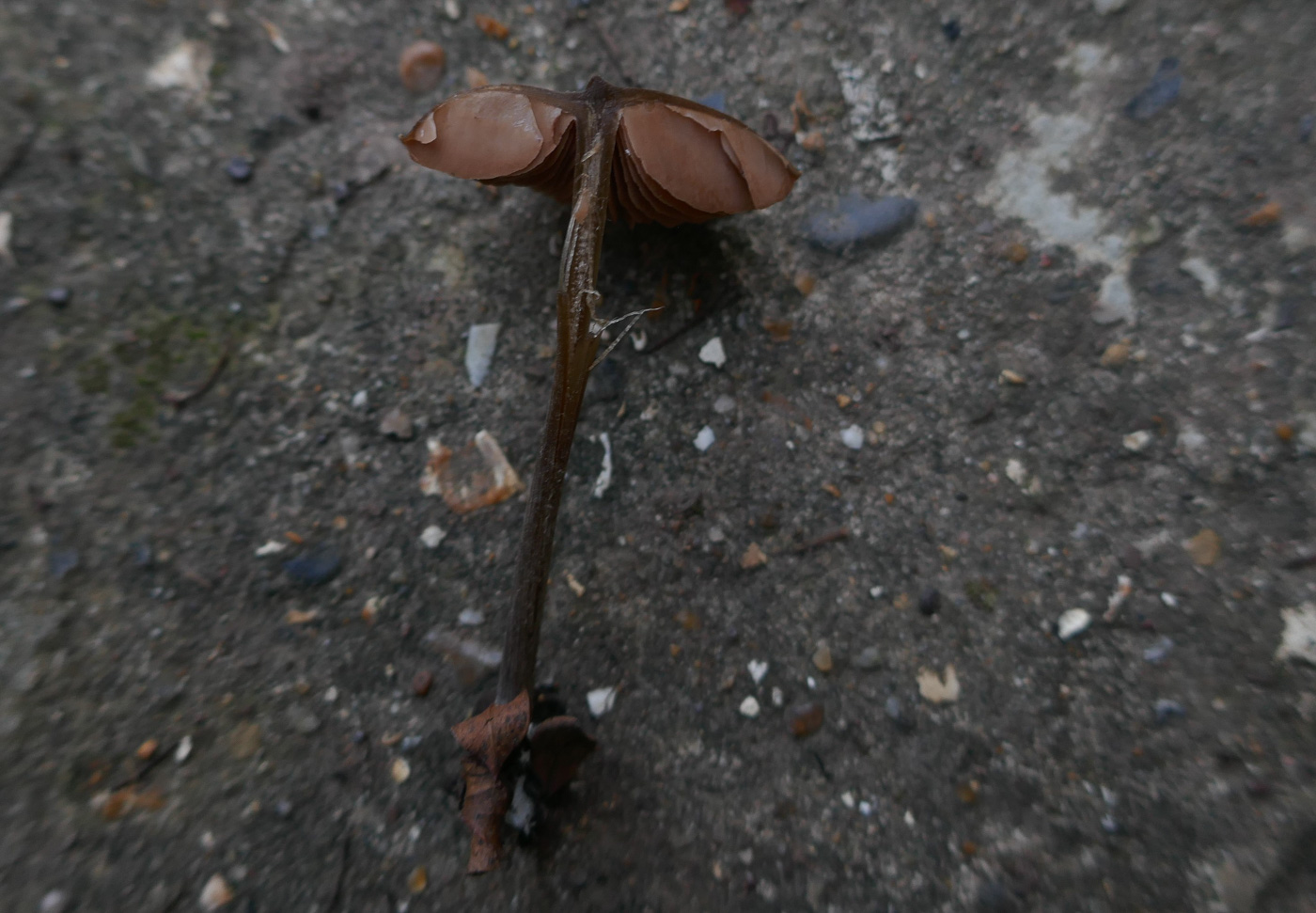 |
January 2nd Entoloma hebes In her garden in Chalfont St. Peter Jackie Ewan noticed a couple of smallish LBJs in a patch of soil. The general 'jizz' and distinctive pinkish brown gill colour pointed to the genus Entoloma and this was soon confirmed by the spore shape under a scope. Characteristic of this particular species is the neat little central papilla which is not unique but does help to eliminate many other contenders in a difficult genus. This combined with the smooth brown cap and microscopic features was enough to confirm Jackie's ID.The species is one of the commoner Pinkgills and we have a fair number of county records. Previous finds |

